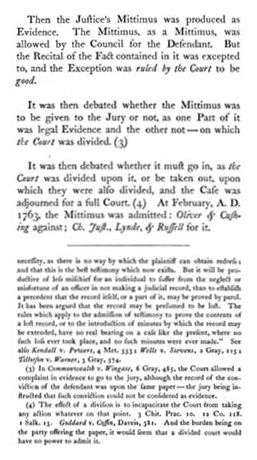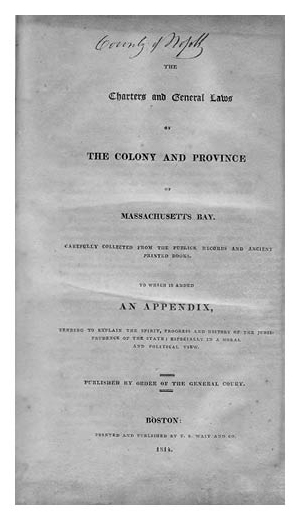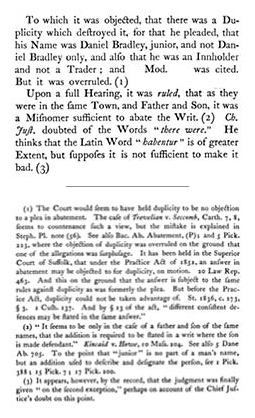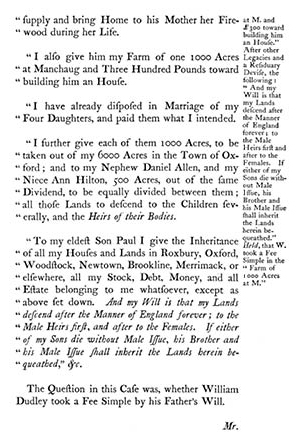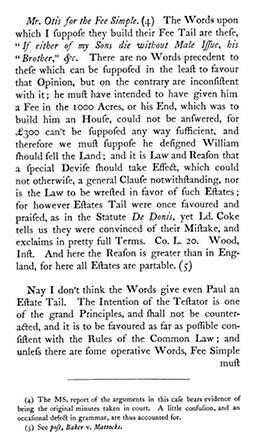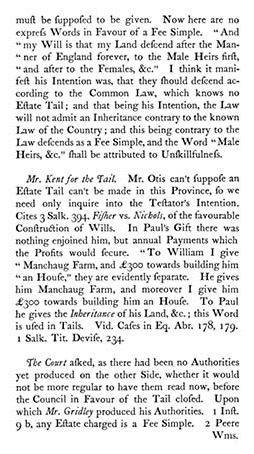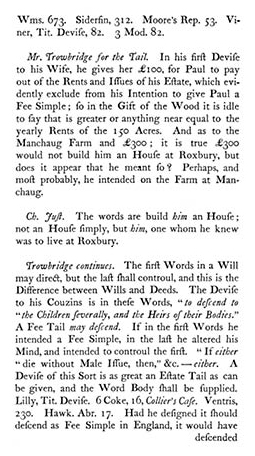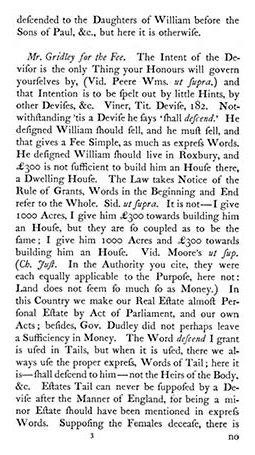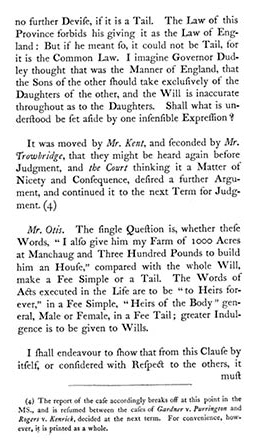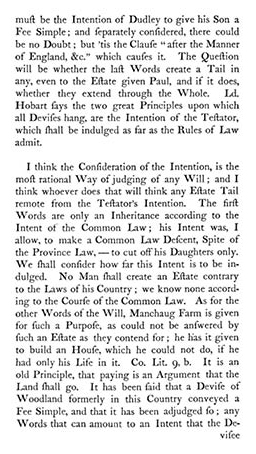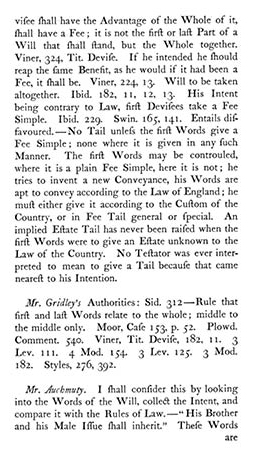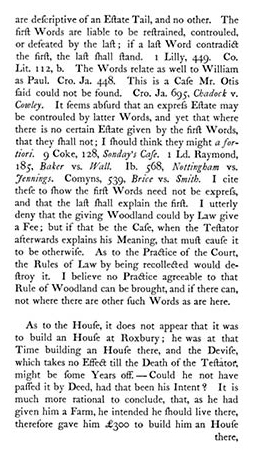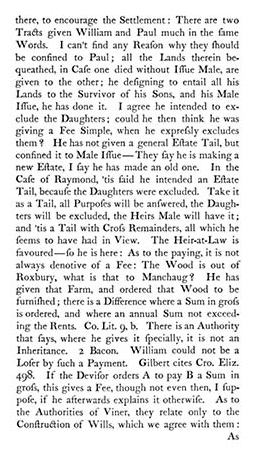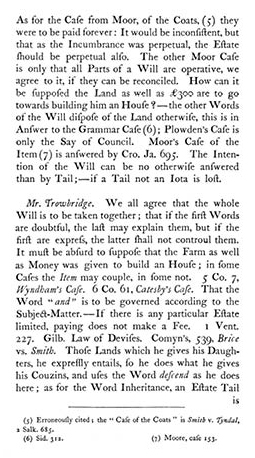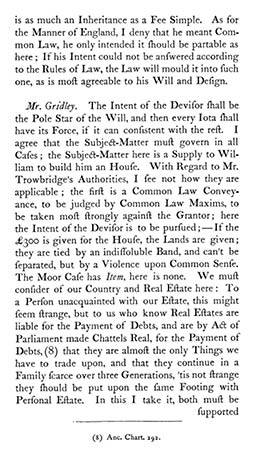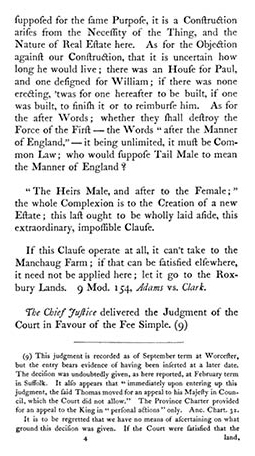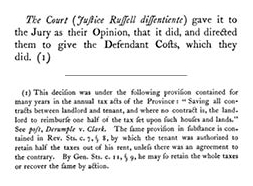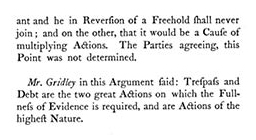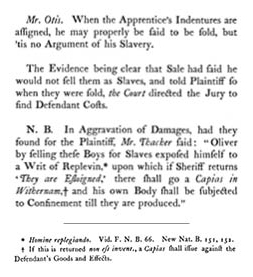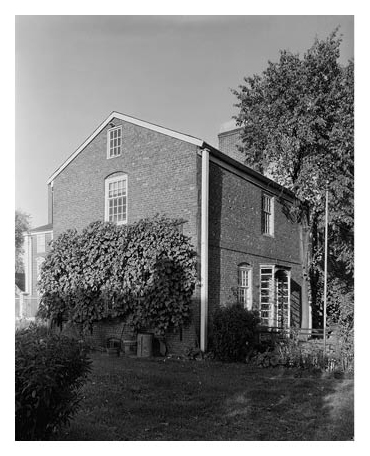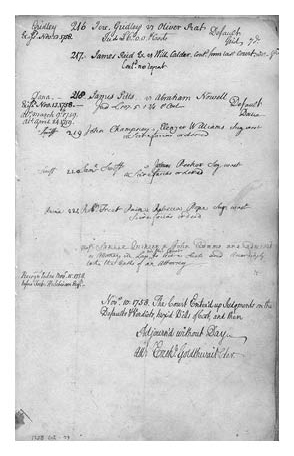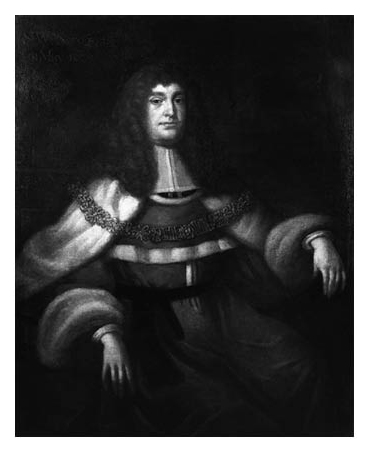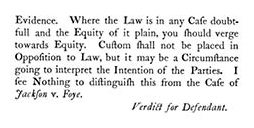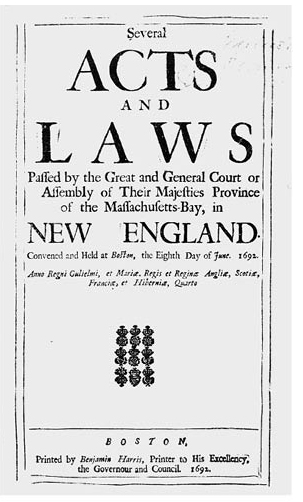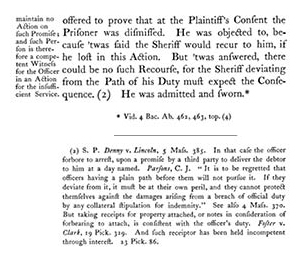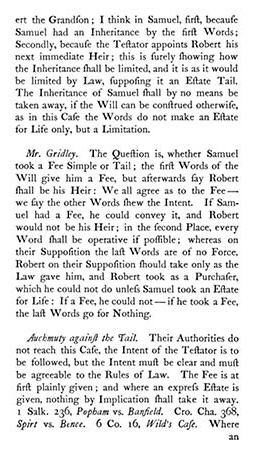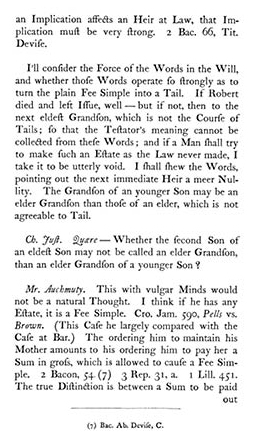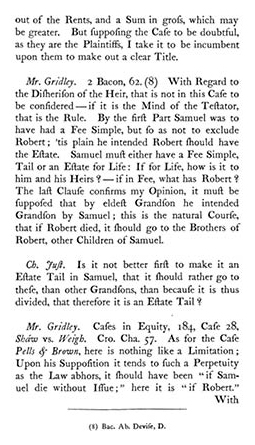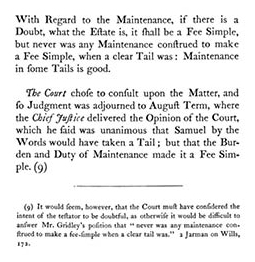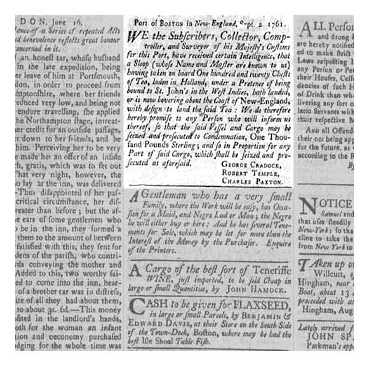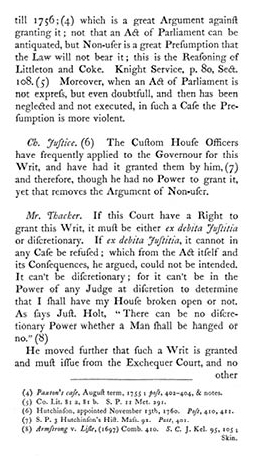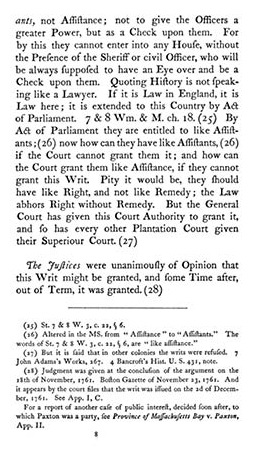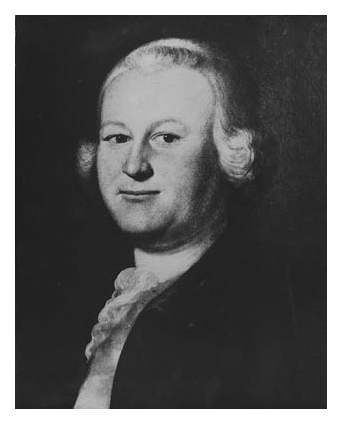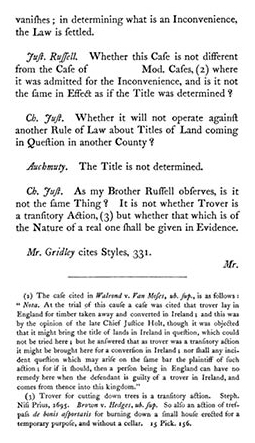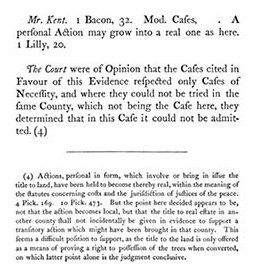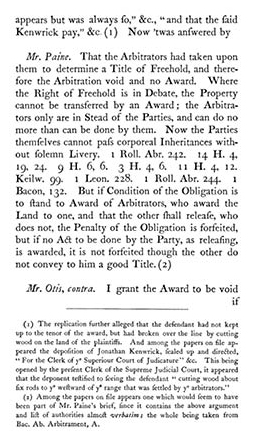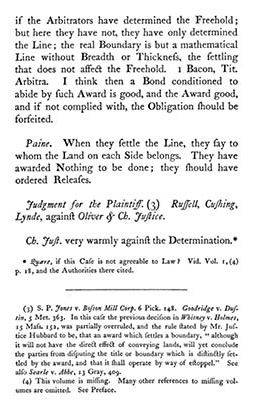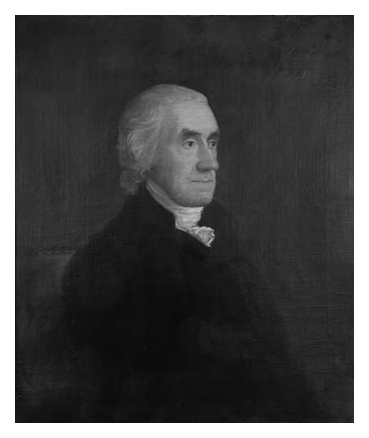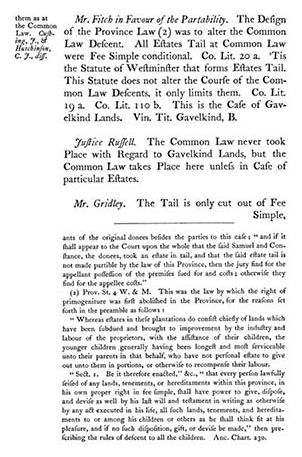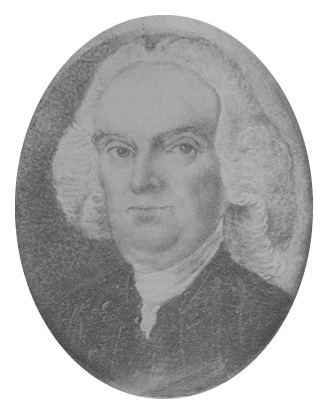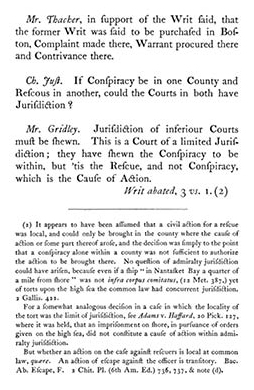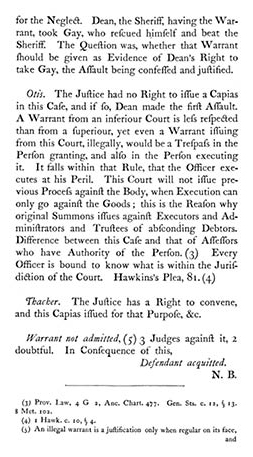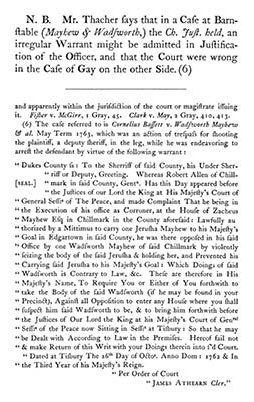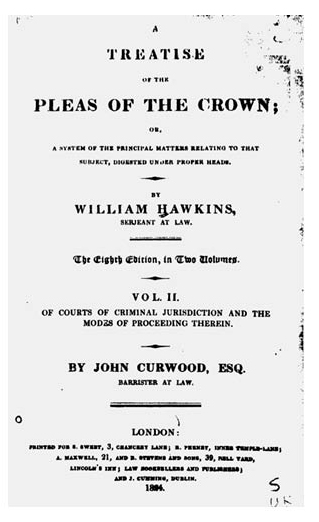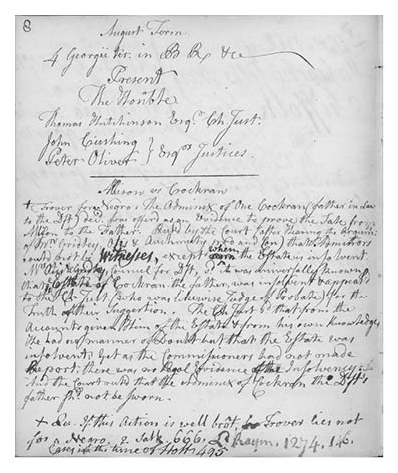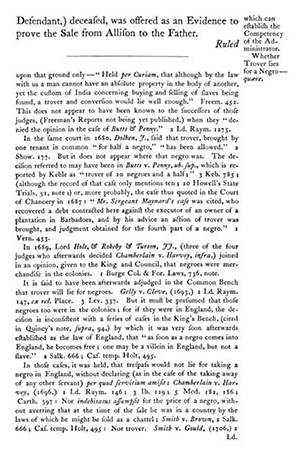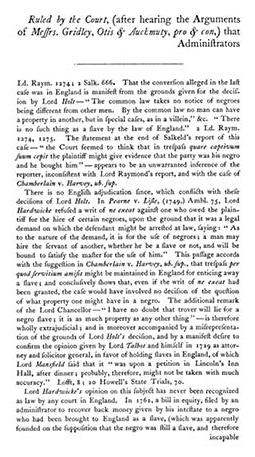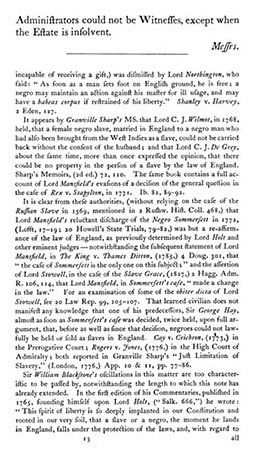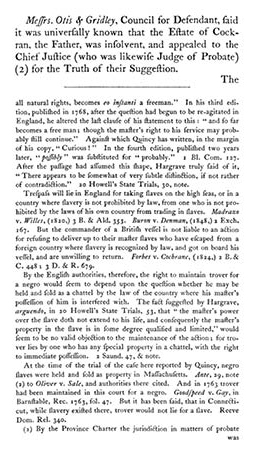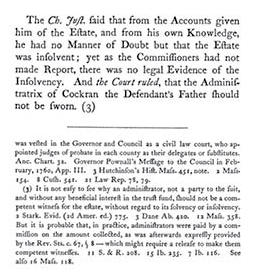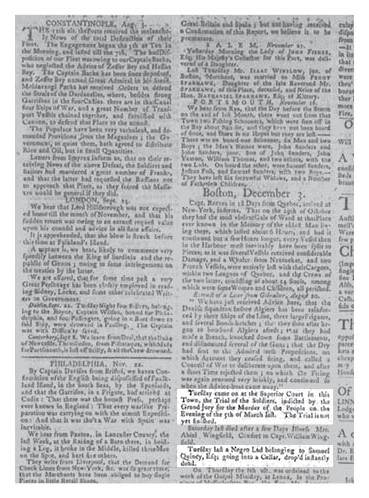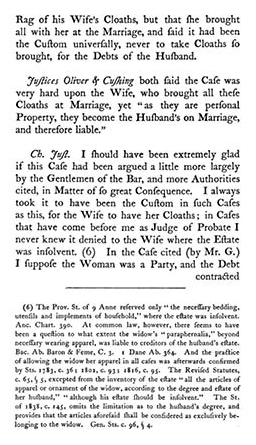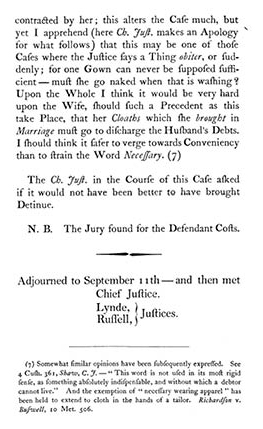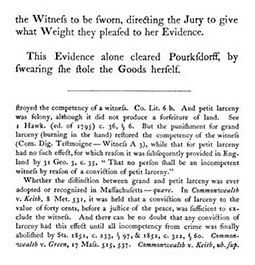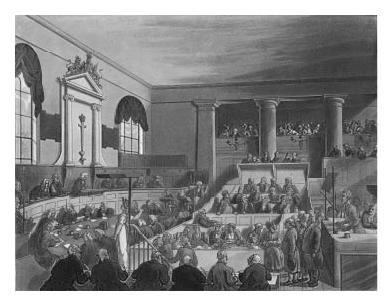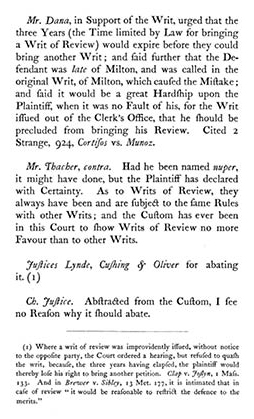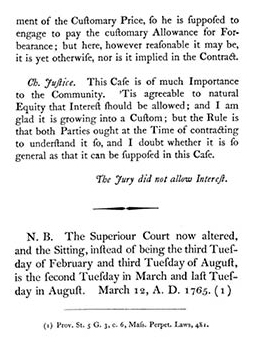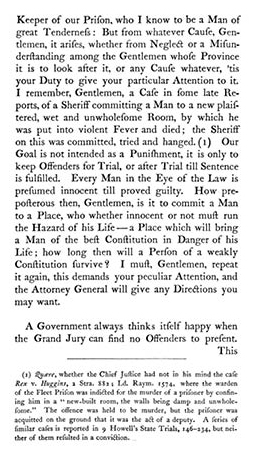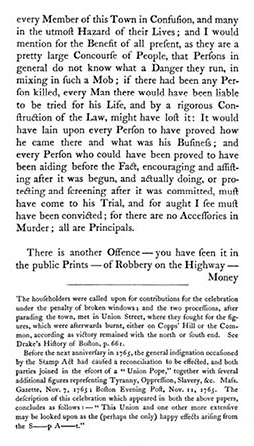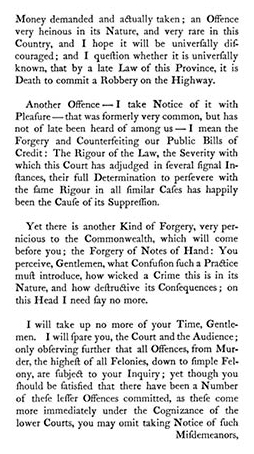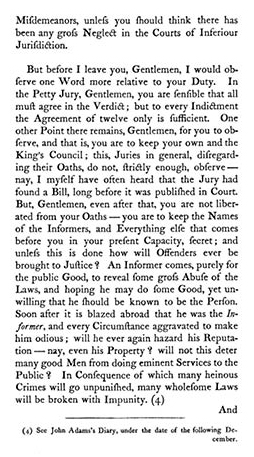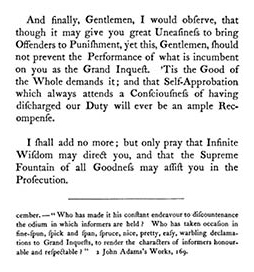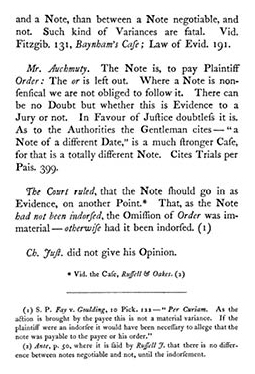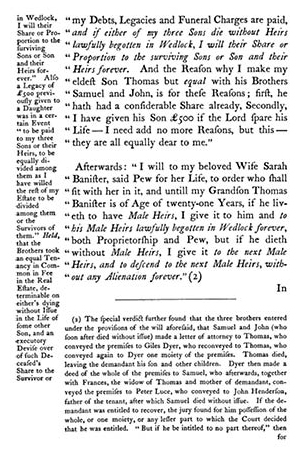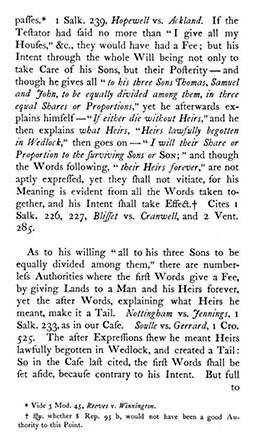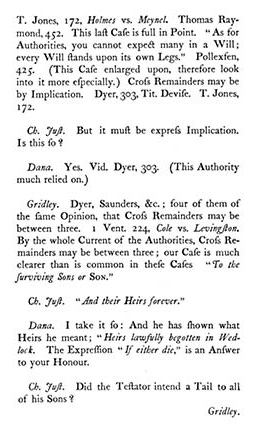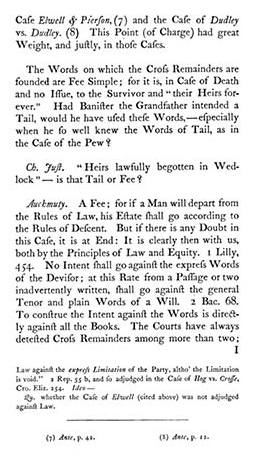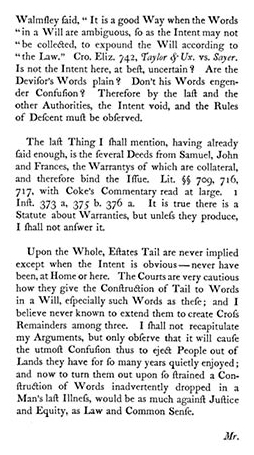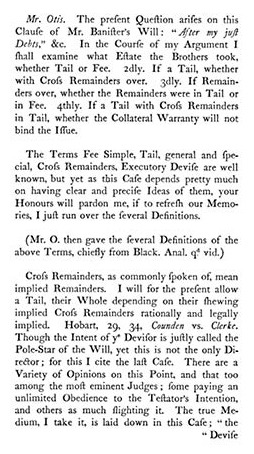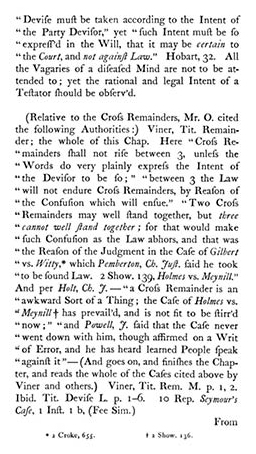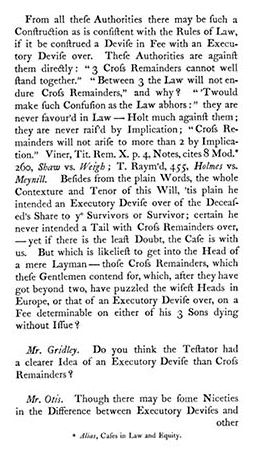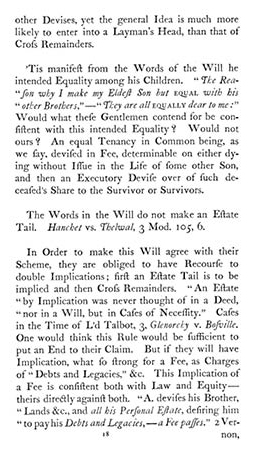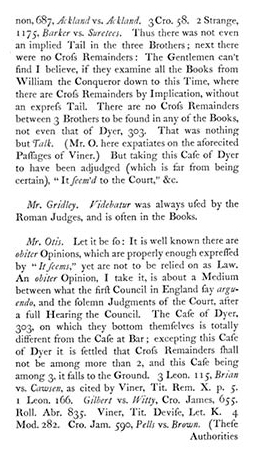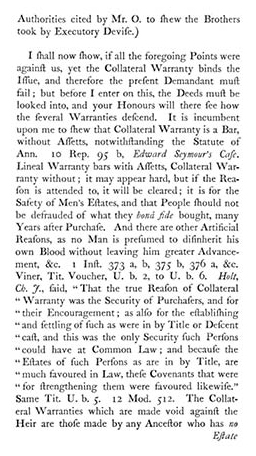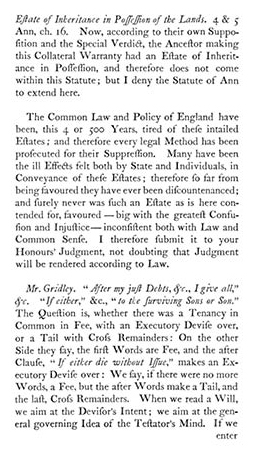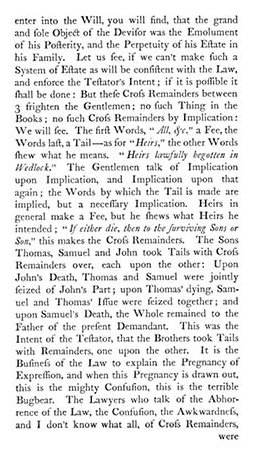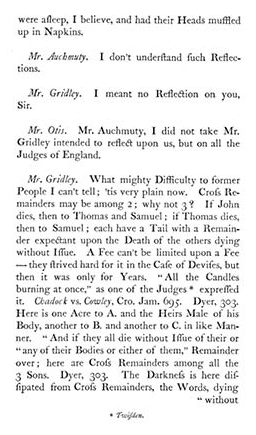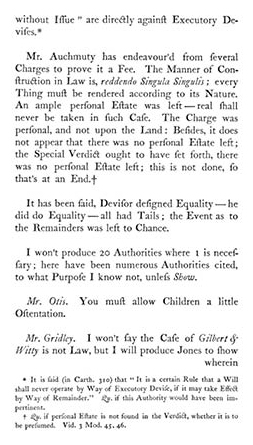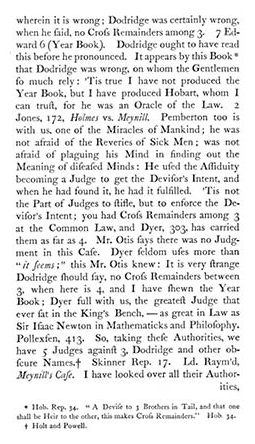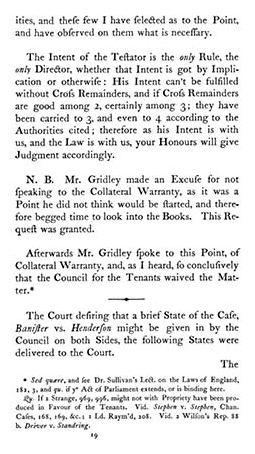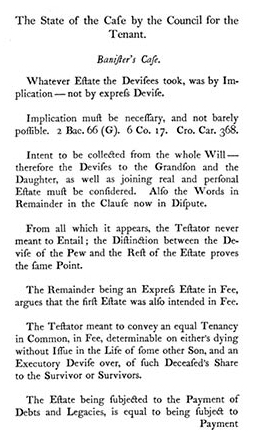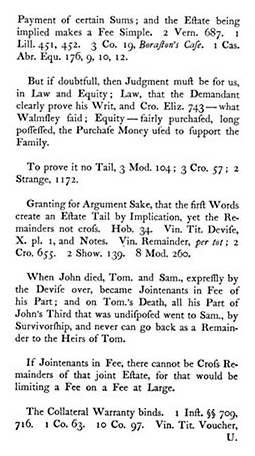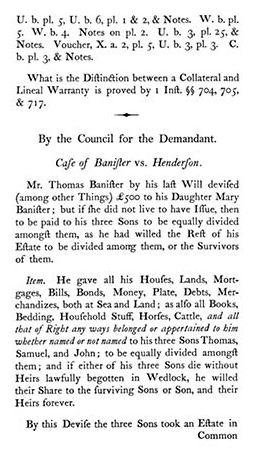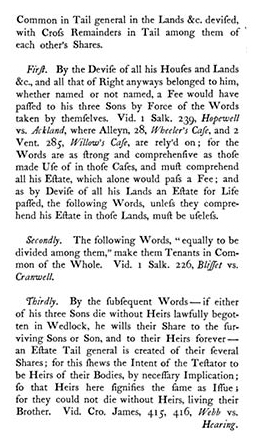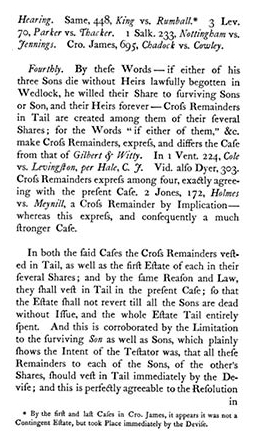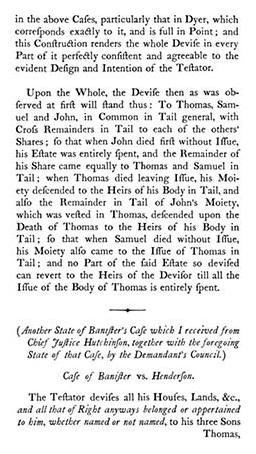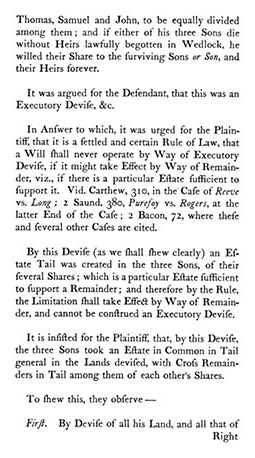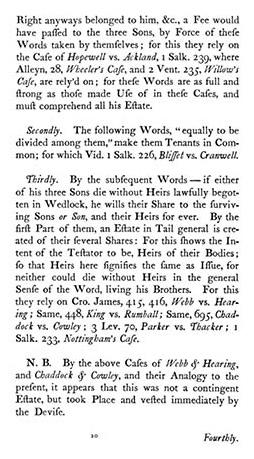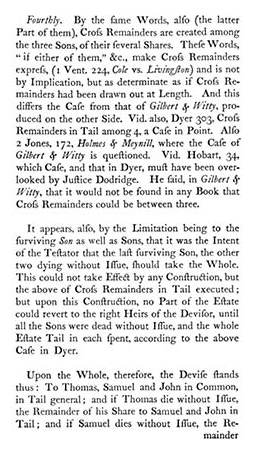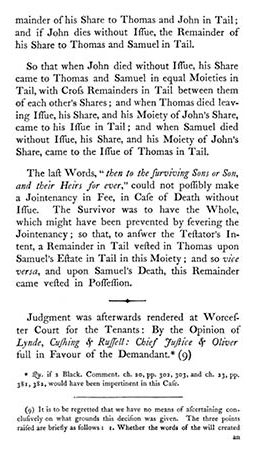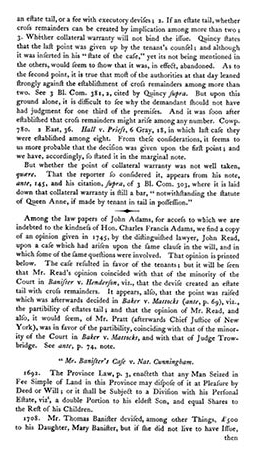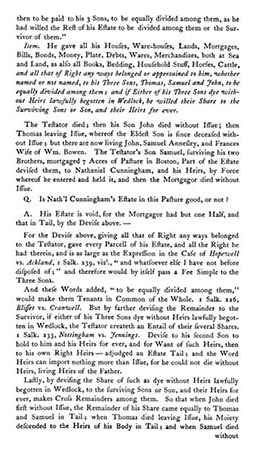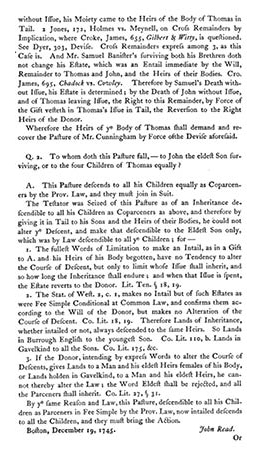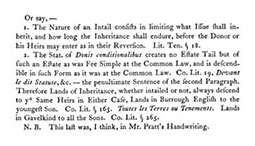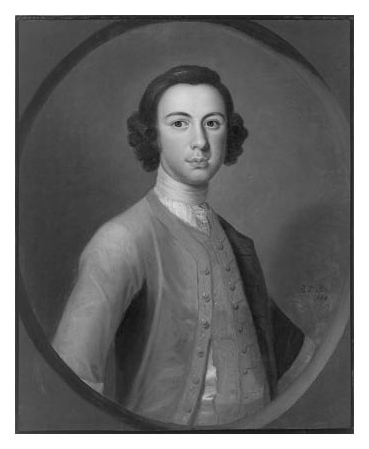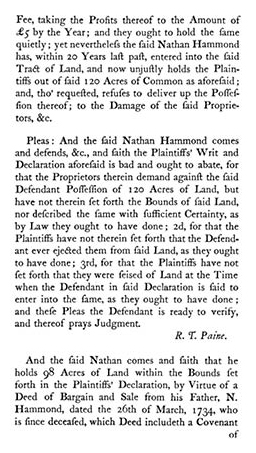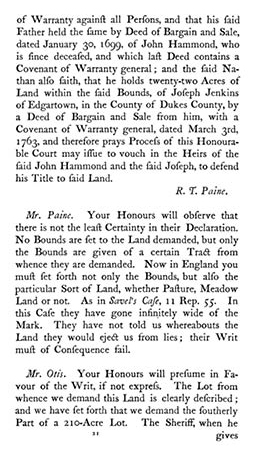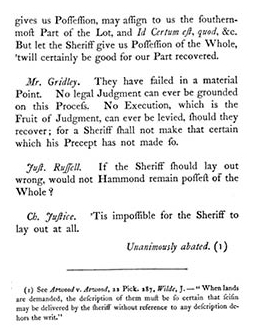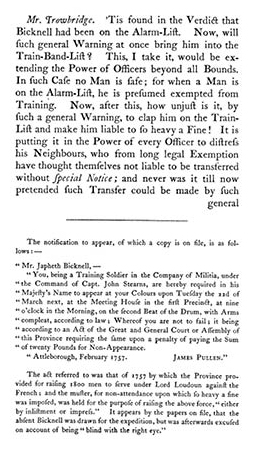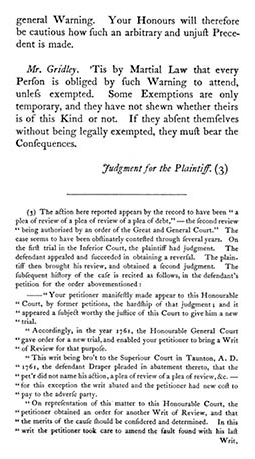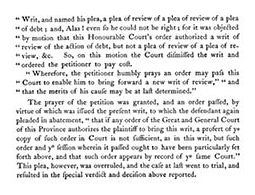THE REPORTS
PART ONE
1761–1765

CASE 1
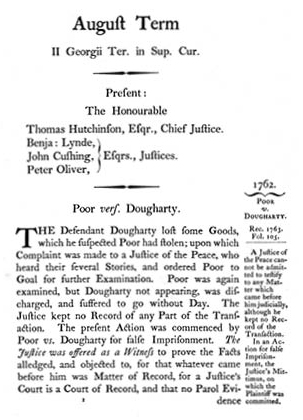
[P. 1]
2 George III (Aug.) in the Superior Court of Judicature
1 · brief description
This was a very appropriate first case for Quincy’s Reports (hereafter, Reports). It featured a hotly contested issue of evidence, and a narrowly divided court. The advocates were most distinguished, Otis and Thacher for the Plaintiff, and Gridley for the Defendant. Of particular interest was the use, on both sides, of English precedents.
The Defendant, Dougharty, “lost some goods,” and accused Poor of stealing them before a Justice of the Peace. The justice ordered Poor to be examined again, but Dougharty did not appear, and Poor was dismissed. Poor then sued Dougharty in trespass for false imprisonment. But there was no record of the proceeding, as the “justice kept no Record . . . ,” so Poor called the Justice as a witness.
The Court unanimously concluded that the Justice of the Peace could not give parol (oral or extrinsic) evidence of proceedings in a court of record.
The Court divided sharply, however, on the admissibility before the jury of the justice’s mittimus (i.e., “we send,” a writ used in sending a record from one court to another) ordering the Defendant to appear. The mittimus properly proved the fact of the arrest, but it also contained an inadmissible recitation of facts below. The members of the Court present at trial divided evenly on the question, with the effect of preventing any action, and the issue was held over for consideration by the full Court. The full Court ruled the mittimus admissible, by a 3–2 vote, for the limited purpose of proving the arrest. Justices Oliver and Cushing were in dissent.
2 · court records
Available, Rec. 1763, Fol. 105.
Indicates that “the said Poor recovered of said Dougharty four pounds lawfull money of this pro-[province?], damage and costs taxed at £20:0:6.”
The records also contain:
- • Affidavit of Parker, illegible, stating the substance of what Dougharty told him about the theft of nine handkerchiefs. At the top is written, “Mr. Parker Evidence.” It appears to have been ordered by Justice Wells and both parties were present when the affidavit was written.
- • Deposition of Capt. Stephen Brown-only the cover page.
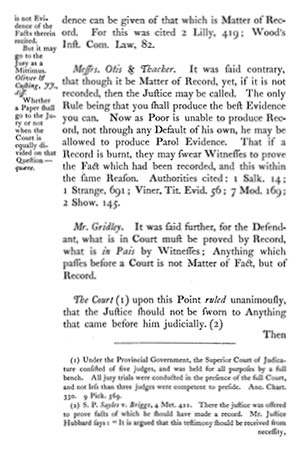
[P. 2]
3 · professionals involved
James Otis Jr. (1725–1783), Oxenbridge Thacher (1719–1765) for the Plaintiff; Jeremiah Gridley (1701/2–1767) for the Defendant. These were among the colony’s finest. See Appendix 6, infra, for short biographies. The Judges were Chief Justice Hutchinson, Cushing, Lynde, Oliver and Russell. See Law in Colonial Massachusetts, supra, 329–332. Gridley was John Adams’s tutor, and Thacher and Otis were in his exclusive Sodalitas club. Id., 376–382. These were the best advocates of the day. Otis and Thacher frequently collaborated with each other, and with Gridley.
The case was originally tried before a full bench, as was the custom, with one judge, Russell, absent. (As Samuel Quincy observed, there was a quorum for this purpose. See S. Quincy n.1, Reports, 2.) This proved to be important, as the bench deadlocked, and the case had to be “adjourned for a full Court.” The final vote, on the issue of admitting the justice’s mittimus into evidence, was three to two, Hutchinson, C.J., Lynde and Russell prevailing over Oliver and Cushing. Such closely split dissents are unusual. See Appendix 1, infra, “Judicial Dissents.”
4 · authority
English sources were offered on both sides. Gridley relied on Lilly’s Abridgment (1719) vol. 2, 419. See Law Commonplace, page [48], n.3. He relied further on Wood’s Institute of the Laws of England (1720), 82. See id., page [7], n.3. Otis and Thacher relied on 1 Salkeld’s Reports (1689–1712) 14. See id., page [32], n.7; 1 Strange’s Reports (1716–1749) 691 (the case of Chambers v. Robinson (1726), which actually appears in vol. 2), see id., page [21], n.12; Viner’s Abridgment (1742–1753), under the entry “Evidence,” 56, see id., page [16], n.2; 7 Modern Reports (1669–1732) 169, see id., page [35], n.2 and page [96], n.4; and 2 Shower’s Reports (1678–1694) 145, see id., page [82], n.1. None of the authorities cited seem particularly compelling on the point being argued. As the cross-references to Quincy’s Law Commonplace demonstrate, all these sources were used by Quincy in his education, and were familiar to him. Most were in his library. See “Catalogue of Books Belonging to the Estate of Josiah Quincy, Jr.,” set out at Appendix 8, infra.
5 · later citations
As Samuel M. Quincy explained in his notes: “the Superior Court of Judicature consisted of five judges, and was held for all purposes by a full bench. All jury trials were conducted in the presence of the full court,” with not less than three judges competent to preside. See The Charters and General Laws of the Colony and Province of Massachusetts Bay (1814), 330. (Hereafter, “Anc. Chart.”) See also Appendix IV, 9 Pick. (26 Mass.) 566 at 569 (1830). The grandson then cross-references similar cases from the early history of the Commonwealth discussing the use of parol evidence to recreate the record of a judicial proceeding. See Sayles v. Briggs, 4 Met. (45 Mass.) 421 (1842); Kendall v. Powers, 4 Met. (44 Mass.) 553 (1842); Wells v. Stevens, 2 Gray (68 Mass.) 115 (1854); Tillotson v. Warner, 3 Gray (69 Mass.) 574 (1854).
Like the mittimus ultimately admitted in this case, the grandson observes that in Commonwealth v. Wingate, 6 Gray (72 Mass.) 485 (1856), the court allowed an admissible complaint in evidence to go to the jury, even though the inadmissible conviction of the Defendant appeared on the same paper. The court admonished the jury to not consider the conviction as evidence. Finally, demonstrating the difficulty of managing a trial court with between three to five judges on the same bench, the grandson explains that where the court was evenly divided on a question, the effect was to incapacitate the court from taking any action whatsoever on the point. See Proctor’s Case, 12 Coke’s Reports 118 (1615) (“In the King’s Bench, Common Pleas, and Exchequer, where all the justices are equally divided, no judgment can be given . . .”). See also Iveson v. Moore, 1 Salkeld’s Reports 15, 91 English Reports 16 (1699), Goddard v. Coffin, 10 F. Cas. 505 (Circuit Court, D. Maine, 1849).
6 · notes
This case gives a fascinating insight into the internal dynamics of the Court, and how it resolved tough issues. As the later Massachusetts cases show, the legal problem presented is capable of a simple solution: i.e., rely solely on the official record except where-through no fault of the Plaintiff-it is unavailable. Even today, judges are most reluctant to require other judges to testify under oath about things that occurred before them in their official capacity as a court of record. See In the Matter of Cook, 49 F.3d 263 (7th Cir., 1995), where a federal district court judge refused to be questioned under oath by the Illinois state authorities as to attorney misconduct in a matter before that judge in court. See McMorrow, Coquillette, The Federal Law of Attorney Conduct (2001), 806–59 – 806–60.
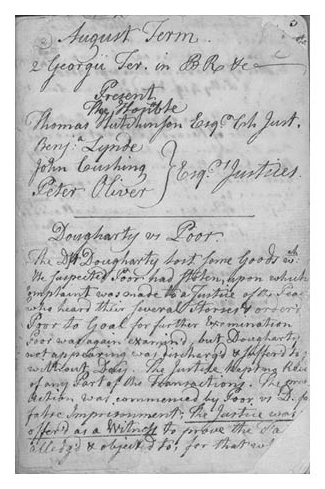
ILLUSTRATION 9: First page of Quincy’s Reports. MHS P347, Reel 4, QP55, p. 3. Poor v. Dougharty (Case 1, 1762), Quincy’s Reports, p. 1. Samuel Quincy lists the case “Poor v. Dougharty,” rather than “Dougharty v. Poor” because, while the original case was brought by Dougharty before the Justice of the Peace for goods stolen, in this case Poor was the plaintiff for false imprisonment. See Annotations, Poor v. Dougharty (Case 1, 1762). Courtesy, Massachusetts Historical Society.
Here, the Court was unanimous that the “Justice should not be sworn to Anything that came before him judicially,” but divided as to whether the Justice’s mittimus (“we send”), the order compelling the Plaintiff to appear to respond to the complaint, was admissible, particularly since part of it was legal evidence. The Court resolved the issue by admitting the mittimus, a fair result for a Plaintiff who, through no fault of his own, was deprived of a record. But the vote was three to two, showing a stubborn formalism in the dissenters.
It is noteworthy that the majority result was apparently not based on the English authorities cited on both sides, but rather to achieve a workable result and a fair rule.
CASE 2
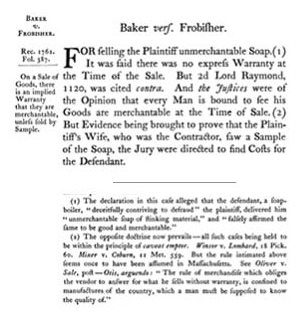
[P. 4]
2 George III (Aug.) in the Superior Court of Judicature
1 · brief description
This was an early “consumer protection” case, about an implied warranty of merchantability for soap. The Court relied on English authority that an express warranty at the time of sale was not required, and this is generally the law today. (If a merchant sells something for a particular purpose, i.e., soap, a customer can rely on an implied warranty that the substance will, indeed, wash your hands, and not be, as alleged here, “stinking material.”) But where the Plaintiff’s wife, apparently an experienced business woman, examined a sample before purchase (and the amounts purchased were in wholesale quantities), the case was dismissed, and the jury directed to find costs for the Defendant.
2 · court records
Available, Rec. 1762, fol. 387.
The Plaintiff first brought suit against the Defendant in a plea of trespass upon the case at the Inferior Court of Common Pleas in Boston in October 1761. The Plaintiff alleged that the Defendant agreed to sell “twenty five boxes of good merchantable soap” for shipment to Canada, but instead delivered to the northward-bound sailing vessel “corruptly unmerchantable soap, ill manufactured and made of bad and stinking materials.” The Inferior Court of Common Pleas awarded costs to the Defendant. The Plaintiff appealed to the Superior Court of Assize and General Gaol Delivery, where the Defendant again was awarded costs. The Plaintiff yet again appealed to the Superior Court of Judicature, where he was represented by Robert Auchmuty. The record merely indicates that a jury was sworn, heard evidence and returned a verdict of costs for the Defendant, without substantiating or contradicting the directed verdict reported by Quincy.
The record contains the initial pleadings, as follows:
John Baker of Boston in the County of Suffolk Merchant Plaintiff & William Frobisher of said Boston Soapboiler Defendant. In the plea of Review of a plea of trespass on the case commenced and prosecuted at an Inferior Court of common pleas held at Boston in and for the County of Suffolk on the first Tuesday of October a.d. 1761 by the said john baker against the said william frobisher in the words following viz. “in a plea of trespass on the case for that the plaint. on the third day of october a.d. 1760 being in want of a quantity of good merchantable soap to ship aboard a vessell and transport to Canada and there to sell the same, at Boston aforesaid applied to the deft to purchase of him the same and the deft accordingly then and there bargained and sold to the plaint. twenty five boxes of good merchantable soap containing two thousand two hundred net weight of such soap for and at eight pence each pound of said soap and one shilling apiece for said boxes and agreed with and promised the plaint. to deliver said twenty five boxes of good merchantable soap on board as [illegible]. . . . Yet the deft never delivered said quantity of good merchantable soap nor any part thereof, but deceitfully contriving to defraud the plaint. delivered on board vessell for the plaint. instead thereof twenty five boxes of bad corruptly unmerchantable soap, ill manufactured and made of bad and stinking materials [illegible]. . . .lost the benefit of the sale that he might have made of good merchantable soap together with the money paid for good soap as aforesaid all of which is to the damage of the said John as he saith the sum of two hundred pounds.”
3 · professionals involved
Robert Auchmuty (1723–1788) represented the plaintiff, as indicated by the court records, above. See Appendix 6, infra, for a short biography.
4 · authority
The Court relied on 2 Lord Raymond’s Reports (1694–1732), 1120 [the case of Lysney v. Selby (1705), which begins on 1118]. See Law Commonplace, page [26], n.2. While accepting the basic English doctrine of implied warranty, the Court made exception for sale by examined sample. Lord Raymond’s Reports were frequently cited in Quincy’s Law Commonplace. See id., page [26], n.2.
5 · later citations
As Samuel Quincy observed, the opposite doctrine of caveat emptor prevailed in Massachusetts, citing Winsor v. Lombard, 35 Mass. (18 Pick.) 57, 60 (1836); Mixer v. Coburn, 52 Mass. (11 Met.) 559, 562 (1846). The grandson cross-referenced Oliver v. Sale, Reports, 29, Case 13, infra, in which Otis argued that the implied warranty of merchantability was limited.
6 · notes
The outcome of this case made a sensible distinction between an ordinary customer, who deserved the “consumer protection” of an implied warranty, and a “contractor” buying large quantities by sample. The persistent Plaintiff, who appealed two lower determinations, was ordered to pay the Defendant’s costs for each of the three hearings, a way to control vexatious suits!
CASE 3
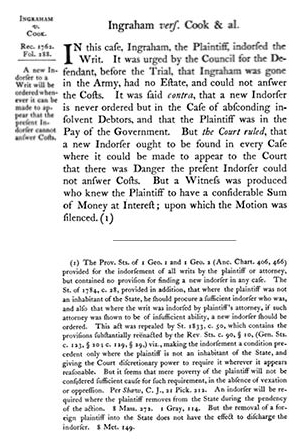
[PP. 4–5]
2 George III (Aug.) in the Superior Court of Judicature
1 · brief description
In the previous case, Baker v. Frobisher, Reports, 4, Case 2, the Court demonstrated one control on vexatious litigation, the routine practice of ordering the unsuccessful party to pay costs. Here was the corollary concern, whether the Plaintiff had enough money to meet Defendant’s costs, if necessary. The Court held that where a witness was produced who knew Plaintiff “to have a considerable Sum of Money at Interest,” the Defendant’s pretrial motion would be denied. See Hallowell v. Daulton, Reports, 33, Case 14, infra.
2 · court records
Available, Rec. 1762, fols. 387–88 (not 288, as in Samuel Quincy’s notes).
The objection raised by the Defendant was more than academic in this case, because the Plaintiff lost in a suit for trespass in the Inferior Court of Common Pleas below and would owe the Defendant costs if he did not prevail in this appeal. In the suit below, the Plaintiff alleged that the four Defendants “with force and arms on the body of Ingraham . . . him did beat so that his life was despaired of,” and prayed for damages in the amount of £100. After a trial de novo before the Superior Court of Judicature, the jury reversed the finding below and returned a verdict in the Plaintiff’s favor, awarding him an amount of £20 plus costs.
Also available:
- Ingraham v. Cook (same), July 8, 1761, No. 172547.
- • Deposition by Eunice Hill in Wrentham, July 8, 1761.
- Ingraham v. Cook (same), Aug. 25, 1761, No. 172361.
- • Deposition of Robert Cook, Inferior Court, Suffolk.
- Ingraham v. Cook (same), No. 174758.
- • Jury Finding for Defendant. Full names of parties are Nathaniel Ingraham and Mary Cook.
3 · professionals involved
No indication.
4 · authority
None referenced by Quincy himself, although the grandson observes that the Provincial Statutes of I Geo. 1 (1714) and I Geo. 2 (1715) (Anc. Chart. 406, 466) made no provision for finding a new indorser in any case.
5 · later citations
The grandson cross-references the various statutes, enacted both before and after Massachusetts and the other colonies declared independence, requiring parties to answer costs in a civil action, and the gradual easing of this requirement. See Prov. St. of I Geo. I and I Geo. 2 (Anc. Chart. 406, 466); St. 1784, c.28; St. 1833, c.50; Rev. Sts. c.90, § 10 (Gen. Sts. c.123, § 20; c.129, § 29). The grandson also details early Supreme Judicial Court interpretations of the statutory requirement. See Feneley v. Mahoney, 38 Mass. (21 Pick.) 212 (1838); Oysted v. Shed, 8 Mass. (2 Tyng) 272 (1811); Bartlett v. Holbrook, 67 Mass. (1 Gray) 114 (1854); Proprietors of the Locks & Canals on Merrimack River v. Reed, 49 Mass. (8 Met.) 146, at 149 (1844).
6 · notes
Access to the courts was, and is, an important political and economic fact. Here the access of a soldier “in the pay of the government” was challenged on the grounds that he could not pay costs if he lost. His case, brought in trespass, alleged that he was cruelly beaten by the Defendant “so that his life, despaired of.” Even allowing for the usual terms of art in trespass pleading, this was a serious case, and, indeed, the Plaintiff eventually received a large verdict of £20 plus costs. It was true the Plaintiff lost below, making the matter of costs for the Defendant a reasonable concern. But, nevertheless, precluding a poor soldier from this type of access to justice would have been significant. As it was, the issue was never squarely faced, for it turned out the soldier was not so poor after all. Later Massachusetts law eventually discarded these barriers to the courts, as Samuel Quincy’s notes demonstrate.
CASE 4
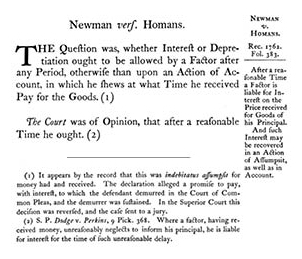
[PP. 5–6]
2 George III (Aug.) in the Superior Court of Judicature
1 · brief description
This was a case brought by a Principal against his Factor for money paid to the Factor for goods belonging to the Principal. A “factor” was “[a] mercantile agent; a person who, in the usual course of his business has possession of the goods . . . of his principal, with authority to sell, etc. . . .” [See P. G. Osborn, A Concise Law Dictionary (London, 1964), 132. (Hereafter, “P. G. Osborn”.)] The question was whether the Factor should be liable for interest if payment to the Principal is delayed. The Court concluded that “after a reasonable Time he ought.”
2 · court records
Available, Rec. 1762, fol. 383.
The record here is of interest, because the action brought was Indebitatus Assumpsit for money had and received, not the action of Account, which was the common law action specially designed for holding agents accountable to principals. For that reason, the Court below sustained the Defendant’s pleading objection. This is also why Quincy emphasized that this claim for interest was “otherwise than upon an Action of Account.” The Superior Court here reversed that holding. See (6) “Note,” below.
Also available:
- Newman v. Homans (same), Aug. 1762, No. 172505.
- • Bill of Costs
3 · professionals involved
No indication.
4 · authority
None.
5 · later citations
As Samuel Quincy indicated at Reports, 6, his note 2, Dodge v. Perkins, 9 Pickering (26 Mass.), 368 (1830), essentially came to the same conclusion, where the factor “neglects to inform his principal” of money had and received for an unreasonable period.
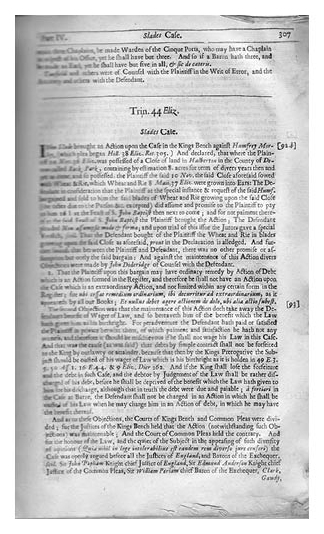
ILLUSTRATION 11: Slade’s Case (1602), 4 Coke’s Reports 92b, from The Reports of Sir Edward Coke . . . (London, 1658), 307. By permission, Coquillette Rare Book Room, Boston College Law School. See Newman v. Homans (1762), Reports, 5 (Case 4), Note 6.
In Ratner v. Hill, 270 Mass. 249 (1930), the case of Newman v. Homans was cited as authority. The issue in Ratner was whether interest was due on a mortgage from the date of the sale of a property. Newman v. Homans was cited for the principle that the obligation to pay interest is imposed only by the terms agreed to by the parties, and that it is consideration for the use of the money. See Ratner v. Hill, supra, 270 Mass. at 254. The case was also cited in Holmer v. Hunt, 122 Mass. 505, at 513 (1877) to illustrate the change in Massachusetts from the common law action of account to the action of assumpsit. See Appendix 5, infra.
6 · notes
The holding of the case was practical and simple, but there was a concealed procedural issue of some importance. Assumpsit was the standard contractual remedy for damages for nonfeasance. See Law Commonplace, page [96], n.9 and page [123], n.8. But the older, and more specific remedy for misfeasance or nonfeasance of an agent was the Action of Account. Before Slade’s Case (1602), 4 Coke’s Reports 92b, it was uncertain whether indebitatus assumpsit (“being indebted, did undertake,” a reference to a fiction designed to avoid perclusion by the writ of debt) would lie where an older, more specific writ, like Account, would provide a remedy. See J. H. Baker, An Introduction to English Legal History (4th ed., London, 2002) 337–365. But there were serious procedural problems with Account, even though the ancient trial of wager by law was denied to bailiffs and agents by 1600. Id., 363–365. Here, the Superior Court was not troubled that the action was brought in indebitatus assumpsit, rather than Account. In doing this, it reversed the court below, the Court of Common Pleas, which sustained a demurrer to the assumpsit declaration, apparently because it was used instead of an Action of Account, which would have set out the time the factor received the money for the goods. (A “demurrer” being a pleading that alleged that the “other party showed no good cause of action or defense.” P. G. Osborn, supra, 107.) The Court thus showed a relaxed view to the formality of the pleading. This would have encouraged the evolution of assumpsit as a general contract remedy, and, indeed, this was occurring in England after Slade’s Case, supra.
CASE 5
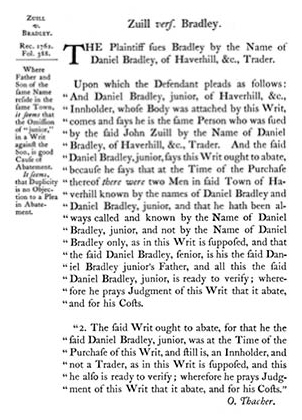
[PP. 6–7]
2 George III (Aug.) in the Superior Court of Judicature
1 · brief description
This was the first of two cases focused on whether the Defendant was adequately described in the writ commencing the case. Here the writ said “Daniel Bradley of Haverhill, Trader.” It was pleaded that the writ should abate for two reasons: 1) there were two Daniel Bradleys in Haverhill, father and son, and this was served on the son, “always called . . . Daniel Bradley, junior”; and 2) Daniel Bradley, junior, was “an Innholder, and not a Trader.” The writ was abated, with the Chief Justice doubtful about the first ground, but apparently not the second.
Note, pleas in abatement “were pleas which, without either admitting or denying the existence of the cause of action, alleged some fact (such as non-joinder of a necessary party. . . . which would preclude the Plaintiff from recovering upon the writ as they framed.” Earl Jowitt, The Dictionary of English Law (London, 1959), 6. (Hereafter, Jowitt.)
2 · court records
Available, Rec. 1762, fol. 388.
The record indicated that judgment was given “on the second exception,” as Samuel Quincy notes. Also available:
- • A receipt for Bradley’s attendance of court which further states that he traveled 66 miles to get to court.
- • Summons of Bradley to Superior Court of Judicature written by Hatch, Esq.
- • A mysterious document that appears pertinent to the Dunten v. Richards case. (Case No. 28, infra, Reports, 67–68.)
- • Order of Execution of Judgment in the amount of 365 pounds, 10 shillings, 10 pence plus costs of suit and perhaps interest, totaling 371.14:14.
3 · professionals involved
Oxenbridge Thacher (1714–1765) appeared for the Defendant. He was one of the elite of the Boston bar, and Josiah Quincy studied law in his office. See Appendix 6, infra.
The Chief Justice expressed doubts about the first ground of abatement, indicating some discourse on the bench, if not a formal dissent.
4 · authority
Quincy indicated that Modern Reports (1669–1732) was cited, but did not give the case name and left the volume and page blank. See Law Commonplace, page [35], n.2, page [96], n.4. In any event, the authority of the case apparently was not followed.
5 · later citations
The opposing counsel’s objection to Thacher’s plea in abatement was based on “duplicity,” i.e., that it “contains more claims, charges or defences than one.” Jowitt, supra, 685. Later Massachusetts cases relaxed this requirement, and, as Samuel Quincy pointed out, Sec. 13 of the Massachusetts Practice Act of 1852 states that “different consistent defenses may be stated in the same answer.” S. Quincy, n.1, Reports, 7. Later Massachusetts cases also revisited the “junior” question, and held that where the father and son had the same name, it was necessary to identify which was meant. Kincaid v. Howe, 10 Mass. 203, 204 (1813).
6 · note
This case gives a good idea of the technicality of common law pleading in Massachusetts in Quincy’s day. The Chief Justice’s reference to the wording “‘there were two Men in said Town,” as different and less sufficient than the Latin “habentur” (“dwell”) was certainly superfluous learning. The Court, however, rightly ignored the duplicity argument of the Plaintiff’s counsel, another technical argument. Skilled counsel were needed when pleading became this complex.
CASE 6
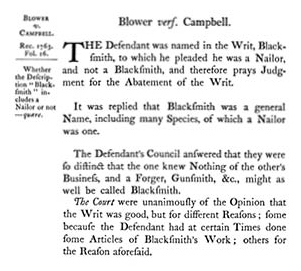
[PP. 8–9]
2 George III (Aug.) in the Superior Court of Judicature
1 · brief description
This is another plea in abatement, like Zuill v. Bradley, Reports, 6, Case 5, supra. This time the Defendant was described as a “Nailor,” but claimed he was a “Blacksmith.” (A “nailor” or “nailer” made nails, Concise Oxford Dictionary, 8th ed., 786.) This was too technical for the Court, which rejected the plea, some justices holding that the Defendant had been a blacksmith, others that a nailer was a kind of blacksmith.
2 · record
Available at Rec. 1763, fol. 16.
3 · professionals involved
No indication. Quincy does indicate that the bench came to the same final result, but disagreed as to the reason.
4 · authority
None.
5 · later citations
See Zuill v. Bradley, Reports, 6, Case 5, note 5, “Later Citations.”
6 · notes
The Court would take technical pleading only so far!
CASE 7
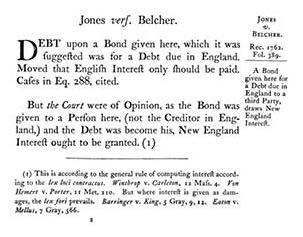
[P. 9]
2 George III (Aug.) in the Superior Court of Judicature
1 · brief description
An interesting conflict of law case on a simple issue: if a bond (i.e., a Contract under seal to pay a sum of money) was to secure a debt due in England, but was executed to benefit a person here-not the original English creditor-should English or American interest rates apply? The Court held for American rates.
2 · record
Available at Rec. 1762, Fol. 389.
3 · professionals involved
No indication.
4 · authority
In support of the argument that English interest should be paid, citation was made to Cases in Equity. This refers to A General Abridgment of Cases in Equity Argued and Adjudged in the High Court of Chancery, first published in 1732 [see Sweet & Maxwell’s Legal Bibliography (2nd ed., London 1955), vol. 1, p. 286; hereafter, “Sweet & Maxwell”]. Pages 288–289 of Cases in Equity state that “in all Cases Interest must be paid according to the Law of the Country where the Debt was contracted, and not according to that where the Debt is sued for.”
5 · later citations
Massachusetts law continued to follow the lex loci contractus (i.e., law of the place of contract) rule, as Samuel Quincy indicated. See Winthrop v. Carleton, 12 Mass. 4 (1812). This is in contrast to the rule of lex fori (i.e., the law of the forum), which Samuel Quincy notes is applicable in cases where “interest is given in damages.”
6 · note
The result is still generally the law. It was interesting that the Court distinguished sharply between the Province and England, favoring the Province.
CASE 8
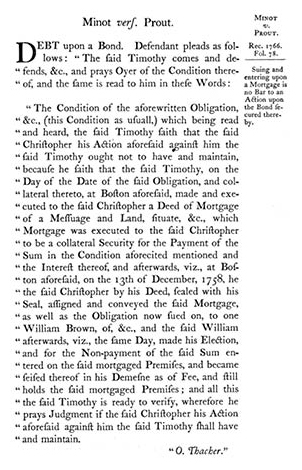
[PP. 9–10]
2 Geo. III (Aug.) in the Superior Court of Judicature
1 · brief description
This was an action for debt on a bond secured by a mortgage. The Defendant alleged that the Plaintiff entered on the mortgaged premises and therefore was barred to sue on the bond, having “elected” the mortgage remedy. The Court disagreed.
2 · record
Available at Rec. 1766, Fol. 78.
3 · professionals involved
Richard Dana (1700–1772) for the Plaintiff and Oxenbridge Thacher (1719–1765) for the Defendant. Both were leaders of the bar. See short biographies in Appendix 6, infra.
4 · authority
The Defendant argued that the Plaintiff’s replication, i.e., the Plaintiff’s answer to the Defendant’s demurrer, Jowitt, supra, 1527, was a “negative pregnant,” citing Lea v. Luthell (1619), 2 Croke’s Reports (1582–1641) [Jac.], 559. See Law Commonplace, page [21], n.6. Also cited was Sampson Ewer’s Doctrina Placitandi (London, 1677), 256. See Sweet & Maxwell, vol. 1, p. 268:58. A negative pregnant “in pleading, is where a person gives an evasive answer to an allegation of his opponent by answering it literally, without answering the substance of it. Thus, if it is alleged that A received a certain sum of money, and he denies that particular amount, this is a negative pregnant, because that substance of the allegation is the receipt of some money, and not the particular amount received.” Jowitt, supra, 1215.
The defense theory apparently was that the Plaintiff’s replication denied that the mortgage had been entered into, rather than denying that, had the mortgage been entered into, it would have barred the bond, as the Defendant’s demurrer argued. Richard Dana rejected the Defendant’s pleading argument on the grounds that if the underlying defense demurrer was bad, “we need not answer this Exception to our Replication.” He then focused on the central issue i.e., “[t]heir Plea is insufficient; for though he had entered upon the Mortgage, yet that is not conclusive that the Bond may not be sued.” Reports, 11.
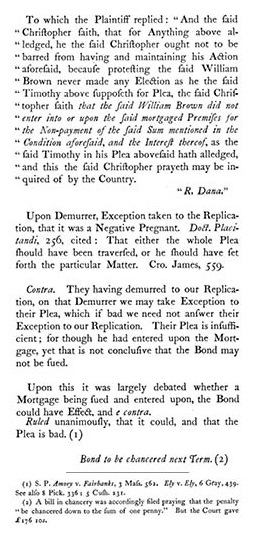
[PP. 11–12]
The Court ignored the Defendant’s pleading point, and the reference to the seventeenth-century English authority, and decided the case, as Dana had urged, on the central issue.
5 · later citations
The result was the later law in Massachusetts. See Amory v. Fairbanks (1793), 3 Mass. 562.
6 · note
Once again the Court brushed aside a technical pleading point and did not address English authority on the point: i.e., the Defendant’s “negative pregnant” argument. It focused on the central issue, and came up with a practical result.
CASE 9
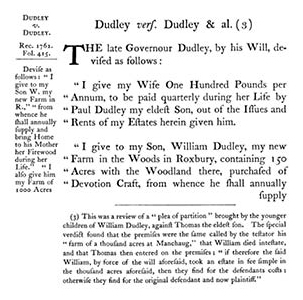
[P. 12]
2 Geo. III (Aug.) in the Superior Court of Judicature
1 · brief description
Here was a case of the greatest importance, both legally and economically. It was a will contest about the will of the late Governor. The will was poorly drafted. The key clause read: “my Lands descend after the Manner of England forever; to the Male Heirs first, and after to the Females. If either of my Sons die without Male Issue, his Brother and his Male Issue shall inherit the Lands herein bequeathed,” Reports, 13. Testator, the late Governor Dudley, devised to his younger son a farm in Roxbury, from which the son would be obligated to provide his mother with firewood, as well as a “Farm of one 1000 Acres at Manchaug and Three Hundred Pounds toward building him an House,” Reports, 13.
At issue was whether the younger son, William, held the Manchaug farm as a fee simple or a fee tail. (A “fee tail” could always revert to the heirs of the grantor if there was a failure of issue, making it technically difficult to sell the property outright for more than a life estate. A fee simple delivered a clear title. See Law Commonplace, page [102], n.1. For a full discussion of banning entails in colonial Massachusetts, see Baker v. Mattocks, Reports, 234, (Case 29, 1763), Note 6. One could not bar an entail by will in Massachusetts until 1791). Opponents of the entail argued that the testator knew that the younger son would live in Roxbury, that the £300 was insufficient to build a house in Roxbury, and thus the devise of the farm in Manchaug was intended as a fee simple so that the son could sell the land to finance a home. The opponents also argued that the closing provision, although it hewed closely to the wording of a fee tail, failed to meet the necessary formalities, and a holding inimical to the free alienation of land should not be read into ambiguous wording. Whether the Superior Court of Judicature agreed with the narrow reading of this will, or the more sweeping rule of hostility toward finding estates of less than fee simple is unclear. The Court ruled that the will devised a fee simple estate in the farm, without comment or explanation.
2 · record
Available at Rec. 1762, Fol. 415.
The action was originally brought by the younger children of William against the eldest son, Thomas, seeking partition of the land. William died intestate. If the land were an estate in fee simple, it would be inherited by all his children equally under Massachusetts law, “for here all Estates are partible,” Reports, 14. If it were an entail, then it vested in Thomas as tenant in tail. See Law Commonplace, page [102], n.1.
3 · professionals involved
The best lawyers in the Colony were briefed on this case. James Otis Jr. (1725–1783) and Jeremiah Gridley (1701/2–1767) argued for the younger children and the fee simple. Robert Auchmuty (1723–1788), Benjamin Kent (1708–1788), and Edmund Trowbridge (1709–1793) argued for William’s eldest son, Thomas, and for the entail. See Law in Colonial Massachusetts, supra, 348, 376–381, 345, 355. All five lawyers argued at length. See short biographies in Appendix 6, infra. Otis and Gridley frequently collaborated.
4 · authority
Otis argued from Coke on Littleton (First Institute) (1628) and Wood’s Institute of the Laws of England (1720), against favoring the entail. See Law Commonplace, page [2], n. 1; page [7], n. 3; page [7], n. 9. Kent answered, relying on Fisher v. Nichols, 3 Salkeld’s Reports (1689–1712) 394, on general principles of will construction. See Law Commonplace, page [32], n. 7. The Court at this point asked for specific authorities. Reports, 15.
Gridley then cited three English cases and two treatises, which Trowbridge countered with two treatises and two English cases. None of these authorities were directly on point given the extraordinarily eccentric drafting of the will, but the Court expressed a clear interest in getting all the authorities “read now.” Reports, 15. One reason might have been their suspicion that the losing party in a case this big was likely to try to appeal to the Privy Council in London pursuant to the Provincial Charter of 1691. See Anc. Chart., 32. This was exactly what happened. See Reports, 25, S. Quincy n. 9.
5 · later citations
Except for Quincy’s own cross-citation, none found. Later Massachusetts cases did not find entails unless clearly stated. There were obvious policy reasons to try to deliver a clear fee simple, unless that was an impossible reading. See “Introduction-The Reports,” supra, notes 128, 129, and accompanying text.
6 · notes
In this “high-visibility” case, after hours of subtle argument, the Court delivered a one-line judgment, “The Chief Justice delivered the Judgment of the Court in Favor of the Fee Simple.” The likelihood of an effort to appeal to the Privy Council, an effort which did in fact occur, may have inhibited the Court from giving explicit reasons. See Reports, 26, S. Quincy n. 9.
And reasons would have been important here, as there were two plausible grounds for the result. Was the Court convinced that the Governor had not intended an entail? In which case the wording of the will was extraordinarily misleading. Or was the Court adopting a rule of construction hostile to finding any but fully devisable estates, unless the wording was technically perfect to establish an entail. This latter ruling would have strongly supported the Colonial law of partible estates, essentially supporting the rights of younger children and women against “English style” primogeniture. Any reader of Jane Austen’s Pride and Prejudice (1813) would appreciate the difference. See “Introduction-The Reports,” notes 128, 129, and accompanying text. See also Richard B. Morris’s classic discussion in Study and History of American Law (1959), which includes an extensive discussion of Quincy’s Reports, including Dudley v. Dudley. See Richard B. Morris, Study and History of American Law, 95–97 and accompanying notes.
My reading of the will leads me to believe, with Samuel Quincy, that the Governor intended to give both brothers entailed estates, with cross remainders, also entailed. See Reports, 26, S. Quincy n. 9. This would make sense of words like “And my Will is that my Lands descend after the Manner of England, forever . . . If either of my Sons die without Male Issue, his Brother and his Male Issue shall inherit the Lands. . . .” (Reports, 13.) If so, the Court was seizing on the draftsman’s incompetence to strike a bold stroke for a presumption of partibility. To say so openly, however, might tempt the Privy Council to interfere. As it was, the Court denied Thomas leave to appeal to England, probably on the grounds that such appeals were permitted for “personal” actions only, not “real” actions as here. See Reports, 25, S. Quincy n. 9. See also The Charter of the Province of the Massachusetts Bay, 1691, which reads, “And whereas we judge it necessary, that all our subjects should have the liberty to appeal to us . . . in any personal action, wherein the matter in difference, doth exceed the value of three hundred pounds sterling, . . .” Anc. Chart., 32 [ital. added].
Despite the denial of leave to appeal, it appears that an appeal to the Privy Council was taken by Thomas anyway. It was referred to Committee on May 5, 1765. An order for hearing was made on May 16, 1765, and on December 16, 1765, an appearance was entered by the respondents. See Acts of the Privy Council, Colonial Series (ed. W. L. Grant, J. Munro, Hereford, 1911), vol. 4, 688. No further entry has been found in the Privy Council records by the editors after that. My special thanks to my distinguished colleague, Sharon H. O’Connor. For a full discussion of Privy Council appeals involving Massachusetts real property, see Banister v. Henderson (1765), Reports, 119, Case 42, Note 6, infra.
CASE 10
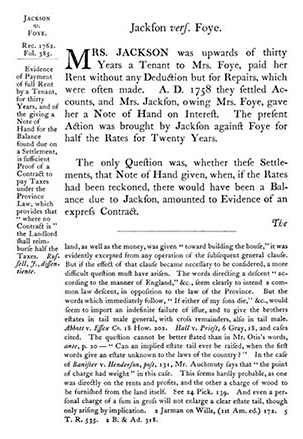
[P. 26]
2 George III (Aug.) in the Superior Court of Judicature
1 · brief description
Tenant brought suit against the landlord to recover half of the taxes paid on rental property over course of 20 years pursuant to the Annual Tax Acts of the Province. See The Acts and Resolves . . . of the Province of the Massachusetts Bay, vol. IV (1757–1768), Boston, 1881, chap. 12, “Province Laws – 1762–63,” 596. “[W]here no contract is, the landlord to re-imburse one-half of the tax set upon such houses and lands; and to estimate Negro, Indian, and Mollatto servants proportionately as other personal estate . . . .” Id. (For one of the earliest examples of such a law, see Tax Act, Provincial Statute 6 William & Mary (1694). See also Reports, 39, S. Quincy n.3.) Special thanks to Mark Sullivan, research librarian beyond compare. The Tax Act provided that “where no Contract is” the Landlord shall reimburse half of the taxes. When the landlord and tenant settled accounts, the tenant, who believed she owed the landlord money, gave the landlord a “Note of Hand on Interest.” The landlord argued that the note constituted evidence of an express contract extinguishing any claim by the tenant. The Superior Court of Judicature agreed, over the dissent of one member, and directed the jury to find for the defendant landlady.
2 · record
Available at Rec. 1762, Fol. 385.
The Plaintiff tenant brought an action for trespass upon the case in the Inferior Court of Common Pleas, where the Defendant prevailed and recovered costs. The tenant appealed to the Superior Court of Judicature Court of Assize and General Gaol Delivery, where the judgment below was reversed. The Record of the appeal to the Superior Court of Judicature makes no note of the directed verdict, but records that the jury found for the Defendant landlord.
3 · professionals involved
James Otis Jr. (1725–1783), the patriot, represented the Plaintiff tenant. See Law in Colonial Massachusetts, supra, 348, and Appendix 6, “Brief Biographies.”
Justice Chambers Russell dissented. This was one of his three dissents out of 78 cases. See Appendix 1, “Judicial Dissents.”
4 · authority
None cited.
5 · later citations
The grandson notes that the Commonwealth continued this policy for some time, see Rev. Sts. c.7, § 8, and ultimately, a tenant could retain all of the taxes paid on rental property, Gen. Sts. c.1, § 9. The grandson also cross-referenced Derumple v. Clark, Reports, 38, Case 17.
6 · note
This is an important contract case, and it is easy to see why Russell dissented. The tenant of thirty years believed she owed the landlord money, and so-on an accounting for the last twenty years-gave the landlord a written promissory note at interest. But if the landlord had reimbursed half the taxes paid to the tenant, as required by the Province Law, then the tenant would be owed money. If we apply modern contract doctrine to this case, it is unclear what consideration the Plaintiff received for her promise to pay money to the landlord, even though she was actually owed money. Surely the tenant losing her rights to reimbursement of the tax was not a detriment to the landlord! A modern court would be unlikely to find an enforceable contract, unless the tenant was clearly aware of the effect of the agreement, and also received some benefit for it, i.e., “bargained for” consideration.
CASE 11
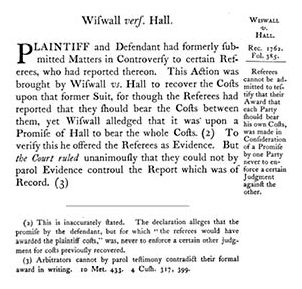
[P. 27]
2 George III (Aug.) in the Superior Court of Judicature
1 · brief description
Parol evidence (i.e., oral or extrinsic) by way of referee’s testimony is inadmissible to control, modify or contradict the referee’s formal Report at arbitration. In his Report, the referee decreed that the Plaintiff and the Defendant share the costs of a matter submitted to arbitration. The Plaintiff then brought a separate suit to recover his costs at arbitration, contending that there was a parol, collateral promise to that effect. The Plaintiff sought to offer as evidence the testimony of the referee, but the Court refused to admit it.
This case was similar to Poor v. Dougharty, Reports, 1, Case 1, heard in the same term. There, a sharply divided Court did, in the end, admit evidence arguably barred by a formal legal rule to prevent a patent injustice.
2 · record
Available at Rec. 1762, Fol. 385.
As Samuel Quincy notes (note 2), the record indicated that the actual promise argued by the Plaintiff was different from that set out by the report. Josiah Quincy Jr. states that it was a promise by “Hall to bear the whole Costs.” The record indicates that it was a promise by Hall not to enforce another judgment for costs, without which “the referees would have awarded the plaintiff costs” (Declaration).
Also available:
- Wiswall v. Hall, (same) Aug. 1760, No. 81064.
- • Judgment and Order that Hugh Hall, Jacob Royall, & James Pitts are obliged to Samuel Wiswall of Bellingham for 750 pounds, Aug. 30, 1760.
- • Notice of Appeal by Hall; saying that Hall will prosecute a Writ of Review with the Superior Court of Judicature, and setting out 12% interest on the judgment if he loses. No interest would apply if the judgment was recovered in part. Hall, Royall and Pitts signed it.
- Wiswall v. Hall, (same) June 8, 1768, No. 88362. Note: Hall was a lawyer.
|
House Charge |
0.18:0 |
|
Referee’s Charge |
5.14:0 |
|
Plaintiff’s Travel |
0.18:0 each |
|
Attendance at 3 days |
0.4:6 |
|
Witnesses travel and Attendance |
0.12:0 |
- Wiswall v. Hall (also “Hall v. Pond”) Feb. 1755
- • Contracts conveying farm.
3 · professionals involved
None indicated.
4 · authority
None cited.
5 · later citations
This remained good Massachusetts law. See Withington v. Warren, 51 Mass. 433, 10 Met. 431, at 433 (1845); Bigelow v. Maynard, 58 Mass., 4 Cush. 317 (1849); Clark v. Burt, 58 Mass. 396, 4 Cush. 396, at 399. Case 11 was cited as authority in Evans v. Clapp, 123 Mass. 165 (1877). There the Court, in determining which questions were concluded by the award of a referee, held that the referee was a competent witness to establish the facts of what took place before him. His parol evidence, however, could not be used to vary or control a written award. The Court cited by example to Wiswall v. Hall, Reports, 27, Case 11. See Evans v. Clapp, supra, 123 Mass. 165, at 170.
6 · note
One of the eternal issues of law is whether to strictly enforce technical rules, which give certainty to proceedings; or to bend these rules to prevent an injustice, or a “trap for the unwary.” In a previous evidence case, Poor v. Dougharty, Reports, 1, Case 1, supra, a sharply divided Court did bend the rules slightly to let in vital evidence. Here they did not, possibly because of the importance of being able to rely on a finished arbitrator’s report. On the other hand, if the Plaintiff’s account of the situation was correct, and he was eager to call on an arbitrator to confirm them, an injustice was done. The Plaintiff was trapped by failing to have the collateral agreement set out in the report. Rulings such as this indicate that formality in a colonial judicial system could outweigh “rough justice.”
CASE 12
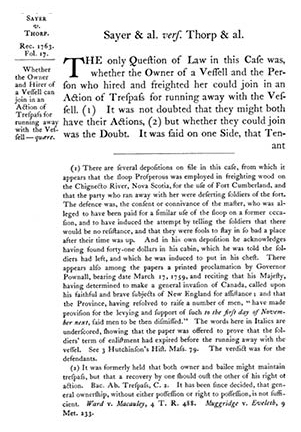
[P. 28]
Sayer & al. v. Thorp & al. (1762)
2 George III (Aug.) in the Superior Court of Judicature
1 · brief description
Could a vessel owner and charterer join together in an action of trespass against Defendant for “running away with the vessel”? In this case, the alleged culprits were “deserting” soldiers from Fort Cumberland on the Canadian border. Although either the owner or charterer could pursue an action independently, the parties debated whether the two Plaintiffs could join in one action. Since the parties then agreed upon the issue, the Court did not decide the point.
2 · record
Available at Rec. 1763, Fol. 17.
The depositions in the record give much more detail than Quincy’s account. These are set out by Samuel Quincy’s note 1. The Plaintiffs alleged the vessel was seized by “deserting” soldiers, and the defense was that the soldiers had actually paid the master of the vessel and had his consent. Also in the record is Governor Pownall’s Proclamation of March 17, 1759, introduced, as Samuel Quincy indicated, to prove the soldiers’ enlistment time was up. The verdict below was for the defense.
3 · professionals involved
Jeremiah Gridley (1701/02–1767), apparently for the defense, “Father of the Suffolk Bar.” See Case 1, note 3, supra, and Anton-Hermann Chroust, The Rise of the Legal Profession in America (1965), vol. 1, 79. See also Appendix 6.
4 · authority
None cited. Defense argued the English rule that the tenant of a freehold, say a life tenant, could not join with the owner of the underlying reversion (i.e., the base fee). Plaintiff counsel pointed out the obvious policy argument that, in cases like this, requiring two separate law suits just adds to the expense. Quincy notes Gridley’s argument on the “two great Actions” (i.e., Trespass and Debt), requiring “Fullness of Evidence,” but why this would make a difference in the pleading here is unclear.
5 · later citations
The grandson observed that “[i]t has since been decided, that general ownership, without either possession or right to possession, is not sufficient.” Citing Ward v. Macauley, 4 Term Reports (T. R.) 499 (1791). (His citation to page 488 is in error. These were reports of the King’s Bench in England. See Sweet & Maxwell, vol. 1, 299:46); Muggridge v. Eveleth, 50 Mass. (9 Met.) 233 (1845).
6 · note
The underlying case, which gave a picture of conditions along the Canadian border, was far more interesting than the technical issue before the Court. The rule that general ownership alone does not necessarily give standing as a Plaintiff is reasonable enough. In this case, for example, the Charterer-who had right of possession-may have been liable to the owner for all charges under the Charter, leaving the Owner with no damages.
CASE 13
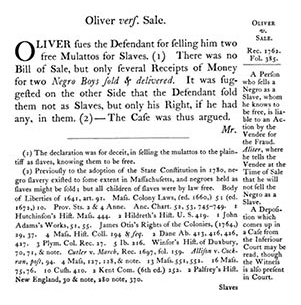
[P. 29]
2 George III (Aug.) in the Superior Court of Judicature
1 · brief description
Action for deceit (fraud) by the Plaintiff for “selling him two free Mulattos for Slaves.” Reports, 29. The Plaintiff argued that the receipt for “two Negro boys sold & delivered” demonstrated that the Defendant intended to convey property. Id., 29, 30. Defense counsel argued that there should be an express warranty of freedom “in the Case of a Negro,” and that any implied warranty should not be imputed to the Defendant in this matter. Id., 31. Chief Justice Hutchinson then asked, “Is there not as palpable a Fraud, when a Man sells a Negro as a Slave whom he knows to be free, as when he sells a Bag of Feathers and assures them to be Hops?” Id., 32. The Defendant then offered the deposition of a woman present at the time of the sale. (It was held that the Deposition could be read, even though the witness was in court.) The Deposition showed that the Defendant expressly refused to sell the boys as slaves because he knew they were to be free after some time, and only conveyed the Defendant’s right and title in their services. The evidence “being clear,” the Court then ordered the jury to find for the Defendant, with costs.
This case is of the greatest interest for what it reveals about the law of slavery in Massachusetts. For the lawyers arguing the case, however, the principal issue was warranty of merchandise and deceit, very much like that of the soap in Baker v. Frobisher (1762), Reports, 4, Case 2, supra. Of course, by Samuel Quincy’s day in 1865, the Civil War had made slavery an issue of the greatest consequence, hence his extraordinary note 2, tracing the history of slave law in Massachusetts. At the time he was publishing the Reports, Samuel Quincy was commanding the Seventy-third United States Colored Troops at Port Hudson, north of New Orleans. See Daniel R. Coquillette, Editor’s Foreword, supra, pp. 6–7.
2 · record
Available Rec. 1762, Fol. 385.
Among the records are the depositions of Anna Bill and Lydia Whitaker, set out by Samuel Quincy in Reports, 32, note 4. One of the witnesses was in Court, and Josiah Quincy’s pupil master Oxenbridge Thacher, for the Plaintiff, tried to prevent the deposition being read, thus giving him a chance to cross-examine her. The Court rejected his argument, and permitted the deposition to be read. Whether the witness could then be called, or was called, was not clear from the report. The Court did, however, accept the gist of both depositions as true, and that Captain Sale did not “sell them [i.e., the “two Negro Boys”] for Slaves . . . only his right & title in them, & Mr. Oliver said he would run the risk of their ever getting free.”
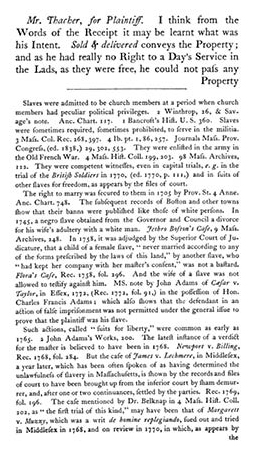
[P. 30]
Also available:
- Oliver v. Sale, (same) Feb. 1762, Nos. 172435–36.
- • Certificate of Attendance, Superior Court of Judicature, Boston.
- Oliver v. Sale, (same) No. 174991.
- • Jury finding for defendant with costs. Full names of parties are John Oliver and John Sale.
- • Jury finding on back for a different case, Hunt v. Proctor.
3 · professionals involved
Oxenbridge Thacher (1719–1765), Quincy’s pupil master, for the Plaintiff; James Otis, Jr. (1725–1783), for the Defendant. See Reports, Case 1, Note 3, “Professionals Involved,” supra. See also Appendix 6, “Brief Biographies,” infra. Otis and Thacher often worked as a team.
Chief Justice Hutchinson’s comparison of a slave to a “Bag of Feathers” or a “Bag of Hops,” see Reports, 32, supra, was not a high point in judicial humanity.
4 · authority
Most striking, no authority was cited on the issue of slavery, despite the many cases and statutory provisions listed by Samuel Quincy in his famous note 2, Reports, 29–31. It was clear that there was slavery in Massachusetts, and that you could also assign an apprentice’s indentures, as Otis observed. The successful argument was that Captain Sale sold whatever interest he had in the boys for any type of service, and Oliver assumed the risk that Sale had none.
Thacher also argued for the Plaintiff that Oliver, by “selling the Boys for Slaves” exposed himself to a “Writ of Replevin” and a “Capias in Withernam,” and that this could result in “his own Body . . . subjected to Confinement till they are produced.” Reports, 33. This was ostensibly added to support aggravation of damages had the Plaintiff won which, of course, he did not. It was a curious, antique argument, particularly as there was no apparent difficulty in producing the boys. A “capias in withernam,” from the Anglo-Saxon withernam, or “taking again,” was used where the Defendant had hidden the goods, so that the sheriff could not replevy them on behalf of the Plaintiff. See Jowitt, supra, 308–309. In that case the Plaintiff could have a capias in withernam, a writ directing the sheriff to replevy equivalent goods of the Defendant. Id., 308. Thacher added that where the sheriff returns “they are Essoigned” (i.e., excused), he could then seize the Defendant’s person, until the goods were produced. See id., 734. This argument, given the facts of the case, was an odd effort to invoke English common law doctrines to impress the Court. It apparently failed in this goal, but obviously impressed the young Quincy, who marked it “N.B.” (nota bene). For the origins of the remedy of replevin, a personal action to recover possession in specific goods unlawfully taken, id., 1526, see J. H. Baker, An Introduction to English Legal History (4th ed., 2002), (hereafter, J. H. Baker) 390–391, 538–539.
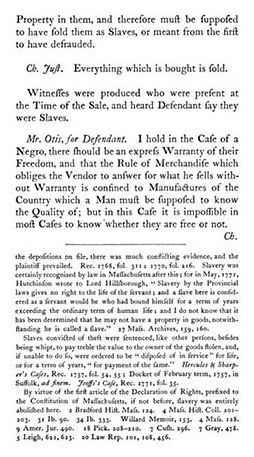
[P. 31]
5 · later citations
As Samuel Quincy observed in his exhaustive “note 2,” the adoption of the Massachusetts Constitution in 1780, Article 1, Declaration of Rights, ended slavery in the state. See S. Quincy, note 2, Reports, 31, supra.
Case No. 13 has been cited as authority for the right of slaves to marry prior to the 1780 Constitution, a point that could be important in disputes over inheritance. See Merrick v. Betts, 214 Mass. 223 (1913), which cites to Oliver v. Sale for this point at page 223.
6 · note
This case remains an extraordinary window into the colonial consciousness about race and slavery. The two “Negro Boys sold & delivered,” “free Mulattos” but sold “for Slaves,” could have been mislabeled “Bag[s] of Feathers[!]” As the Chief Justice observed, “Is this not as palpable a Fraud, when a Man sells a Negro as a Slave whom he knows to be free, as when he sells a Bag of Feathers and assures them to be Hops.” Reports, 32. But Quincy lived in a world where even free blacks were treated differently from whites. See, for example, the “negro woman being with Child . . . a free White Man being the father” who was unable to obtain the usual remedies of a white woman before the Justice of the Peace. See Law Commonplace, infra, page [91]. And even whites could be apprenticed for years, with greatly reduced freedoms. Id., pages [19]–[21]. Thus if a woman apprentice married, she “must serve out her Time + her husband cannot take Her out of Her Master’s service.” Id., page [20]. See also Quincy’s extensive discussion of the curtailed rights of women. Id., pages [25]–[28]. See, generally, the excellent articles by Sally E. Haddon, “The Fragmented Laws of Slavery in the Colonial and Revolutionary Eras,” and by Holly Brewer, “The Transformation of Domestic Law,” in The Cambridge History of Law in America, vol. 1, Early America (1580–1815), (ed. M. Grossberg, C. Tomlins, 2008), at 235, 289, respectively. Colonial Massachusetts had little consciousness of its racism, and assumed a hierarchical system that curtailed the rights of free blacks as well as slaves, and women generally, white as well as black.
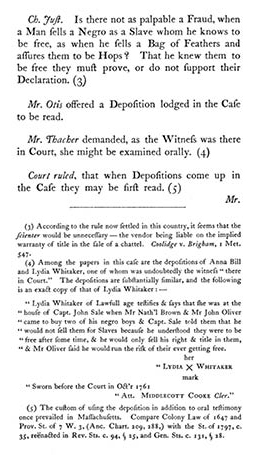
[P. 32]
ILLUSTRATION 12: Slave Quarters, Isaac Royall House, Medford, Massachusetts (1732–1739). Isaac Royall’s will of 1778 and codicil of 1779 established the Isaac Royall Chair at Harvard Law School. His gift could be seen as the founding of that great law school. See Arthur E. Sutherland, The Law at Harvard (1967), pp. 32–42. That he was a major slaveholder in Antigua and brought slaves to Massachusetts, there can be no doubt. See the fascinating account by the present holder of the Royall Chair, Janet Halley, “My Isaac Royall Legacy,” 24 Harvard Black Letter Law Journal 117 (Spring, 2008). Photograph courtesy Royal House Association. See Oliver v. Sale (1762), Reports, 29 (Case 13).
CASE 14
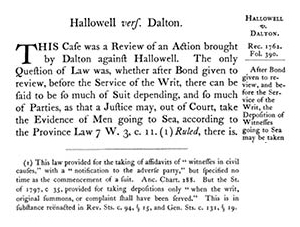
[PP. 33–34]
2 George III (Aug.) in the Superior Court of Judicature
1 · brief description
Actual service of the writ was not necessary for taking “the Evidence of Men going to Sea” by affidavit pursuant to a Province Law where a bond has been given.
2 · record
Available at Rec. 1762, Fol. 390.
The case began as a suit by James Dalton, a “mariner,” against Benjamin Hallowell, a “shipwright,” over an unpaid bill for beef. Dalton won the judgment in the lower court, leading to Hallowell’s appeal.
3 · professionals involved
According to the Record, Benjamin Kent (1708–1788) represented James Dalton. See Appendix 6. There is no indication of the Plaintiff’s attorney.
4 · authority
The sole authority cited was the Province Law itself, 2 William 3, chapter 11 (1701). It merely required that the affidavits be with a “notification to the adverse party,” with nothing further about commencement of the suit. As Samuel Quincy pointed out, this ambiguity was remedied by Massachusetts Statute 1797, chapter 35, which permits depositions only after the service of the writ, original summons, or complaint.
5 · later citations
Today, most jurisdictions permit taking of depositions to preserve testimony before filing a complaint, so long as “expected adverse parties” are notified. See F. Rule Civ. P. 27(a). The practical reason is the same as recognized by the Court in this case, to preserve evidence that might otherwise be lost.
6 · note
This case was a practical reading of an ambiguous statute to serve simple policy, preserving evidence that could be lost when men go to sea, a real danger in 1762.
CASE 15
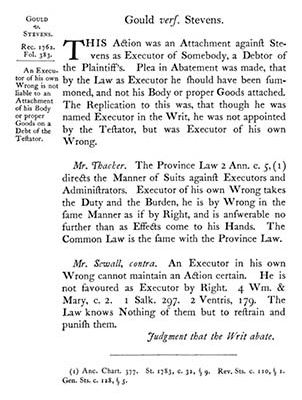
[P. 34]
2 George III (Aug.) in the Superior Court of Judicature
1 · brief description
Plaintiff was a creditor “of Somebody,” who was deceased. Instead of suing Somebody’s estate, Plaintiff summoned Stevens, as Somebody’s executor, and attached Stevens’s own body and goods. The Court held that the writ of attachment was no good.
2 · record
Available at Rec. 1762, Fol. 383.
The Record reveals that three Goulds, John, Robert, and John Jr., were the Plaintiffs, and that Peter Stevens, the executor of John Stevens (“Somebody”) was the Defendant.
3 · professionals involved
Counsel for the Plaintiff was Jonathan Sewall (1729–1796). See Law in Colonial Massachusetts, supra, 352–354 and Memorandum of 1762, Reports, 35, infra. Counsel for the Defendant was Oxenbridge Thacher (1719–1765). See Case 1, note 3, supra, and Memorandum of 1762, Reports, 35, infra. See also Appendix 6.
4 · authority
Thacher relied heavily on the Province Law 2 Ann. c.5(1) (1704), which governs the duty of executors. An “Executor of his own Wrong,” or “Executor de son tort” is “a stranger [who] takes upon himself the act as executor or administrator without any just authority . . .” Jowitt, supra, 759. The general common law rule is that such an executor is liable to suit, as if he were rightfully appointed, but only “to the extent of the assets which have come to him. . . .” Id., 759. (He is not entitled to the “profits or advantages” or executorship. Id., 759.) Sewall argued the contrary, but his statements were off the point. The “executor of his own wrong” cannot bring an action himself in the right of the deceased, it is true, but he cannot be sued personally, nor can his own goods be attached. See, today, the English Administration of Estates Act, 1925, ss 28, 29, 55(1) xi. Id., 759. As authority, Sewall offered Fouler v. Cooke (1695), 1 Salkeld’s Reports 297 (covering 1689–1712), see Law Commonplace p. [32], n. 7, and Pyne v. Woolland (1690), 2 Ventris’ Reports 179 (covering 1668–1684), see Law Commonplace, p. [89], n. 7. Sewall’s English cases were not on point, and the Court threw out his suit.
5 · later citations
The Court’s holding remains the common and statutory law in most English and American jurisdictions, as Samuel Quincy noted.
6 · note
Sewall tried to overcome direct Province statutory law by reference to English common law decisions. How the Court would have resolved a direct conflict between a Province statute and a leading English case would have been interesting, and, as we will see, such conflicts could occur. Here, however, “[t]he Common Law [was] the same with the Province Law,” as Thacher argued. Sewall’s citations were off point and showed a certain amount of pure braggadocio. The Court, however, was not fooled.
ILLUSTRATION 13: Docket Book, Inferior Court of Common Pleas, Suffolk, 1758 October, showing the admission of John Adams and Samuel Quincy, Josiah’s older brother, as attorneys on November 6, 1758. Note the signature of Ezekiel Goldthwait, Clerk, and the names of Jeremiah Gridley, Foster Hutchinson, and Robert Treat Paine.
Josiah himself was admitted as attorney in 1766, but never the higher rank of “barrister,” almost certainly for political reasons. See Neil L. York, “A Life Cut Short,” Quincy Papers, vol. 1, pp. 17–18. See Quincy’s own discussion at Memoranda, August Term, 1769, Reports, 317 (1769), Quincy Papers, vol. 5. Image courtesy Social Law Library, Boston.
memorandum

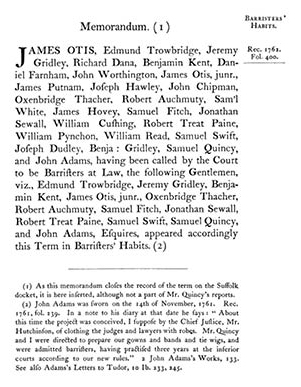
[P. 35]
note
John Adams recorded a major effort from 1762 to 1774 to impose a more formal structure on the Boston bar. See Diary and Autobiography of John Adams (hereafter, “Adams Diary”) (L. H. Butterfield, ed., 4 vols., Cambridge, Mass., 1964) 1, 136–137; 111, 274; Legal Papers of John Adams (L. K. Wroth, H. B. Zobel, eds.), Cambridge, Mass., 1965 (hereafter, “Adams, Legal Papers”), 1, lxxvii–lxxxiii. See also Daniel R. Coquillette, “Justinian in Braintree: John Adams, Civilian Learning, and Legal Elitism, 1758–1775” (hereafter, “Justinian in Braintree”), Law in Colonial Massachusetts, 1630–1800 (D. R. Coquillette, R. Brink, C. S. Menand, eds., 1984), 395–400. It is unclear whether Adams supported the attempt by Chief Justice Hutchinson to establish a separate rank of barrister and to require gowns and wigs. Id., 395–397.
In all events, listing the elite of the bar and inserting it into the Suffolk docket at Rec. 1762, fol. 400, was an important step. The list of 26 names seems to have been composed in order of seniority, with James Otis Senior as most preferred, going down to John Adams as “Mr. Junior,” following the practice of the Inns of Court. The twelve that then “appeared accordingly this Term in Barristers’ Habits” were apparently the most active, a fact confirmed by our Appendices 1 and 2. Biographies of all 26 appear in Appendix 6.
While assisting with the research on these cases in the Massachusetts Archives, my research assistants, Brandon Bigelow and Brian Sheppard, made an important discovery, additional lists of attorneys, with cases after each name. Apparently, these are the cases in which the attorneys appeared during a particular period, or signed pleadings. Not surprisingly, the most active attorneys are those that appear on the 1762 list. See Appendix 6. The only exceptions were our own Josiah Quincy, who was not yet “admitted” in 1762, and Benjamin Prat (1711–1763), who had left Boston in November of 1761 “to take his Seat as Chief Justice of that State.” See Adams Diary, 111, 274; “Justinian in Braintree,” 377–379.
CASE 16
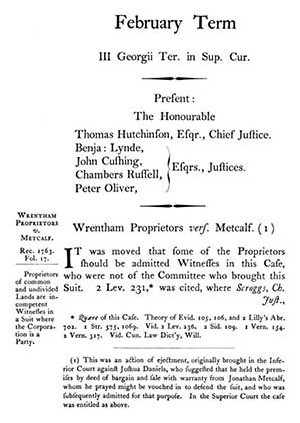
[P. 36]
Wrentham Proprietors v. Metcalf (1763)
3 George III (Feb.) in the Superior Court of Judicature
1 · brief description
This was an action to eject the Defendant from real property. The sole issue here was whether those Proprietors who were not of the Committee who brought the case could be witnesses. (The usual common law rule was that parties in interest could not be witnesses, because they were not impartial. See J. H. Baker, supra, 91, 511; Lord Brougham’s Evidence Act 1851, 14 & 15 Vict. c.99.) The answer here is “no,” the Chief Justice “doubting whether in any Case, where the Interest was ever so small, if they were direct Plaintiffs they should be admitted [as witnesses].” Reports, 37.
2 · record
Available at Rec. 1763, Fol. 17.
Further papers at Suffolk County Files under Metcalf v. Wrentham Proprietors (Aug. 1763).
Records also contain:
- • Summons witnessed by Hutchinson and written by Nathaniel Hatch of Wrentham Prop. (At the bottom of the above document Auchmuty has written for Wrentham that he is now their counsel, and that he disagrees with the judgment.)
- Wrentham Proprietors v. Metcalf (“Metcalf v. Wrentham Proprietors”), Aug. 1793, No. 84523.
- • Summons to John Metcalf, Benjamin Pond, Michael Henry and Robert Hiardell(?) to Superior Court of Judicature to give evidence of plea review. (On the back of the summons is an indication that the summons was served and that the parties appeared in court signed by Nathaniel Hatch.)
- Wrentham Proprietors v. Metcalf (same), Aug. 1763, No. 84517.
- • Summons to Capt. Pond, Deacon Thurston, & Robert Blake to appear before Superior Court of Judicature signed by Nathaniel Hatch.
- Wrentham Prop. v. Metcalf (same), No. 174885.
- • A record of some kind, but it is barely legible.
- Wrentham Prop. v. Metcalf (same), No. 174885.
- • Jury finding, illegible.
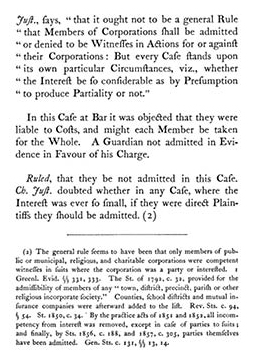
[P. 37]
3 · professionals involved
Robert Auchmuty (1723–1788) represented the Wrentham Proprietors. See Appendix 6, “Brief Biographies.”
4 · authority
Contemporaneous sources. Rex v. Mayor, Citizens and Common Council of London (1678), 2 Levinz’s Reports 231 (covering 1660–1696), see Law Commonplace, [89], n. 7, cited by the Plaintiff’s attorney. Josiah Quincy added a list of other cases and treatise descriptions he thought obtained, citing Theory of Evid. 105, 106, see Law Commonplace, [36], n. 6 (the cited pages refer to 2 Levinz’s Reports 231); 2 Lilly’s Abridgment 702, see Law Commonplace, [48], n. 3 (the cited section of the treatise deals with witness qualification, though p. 702 does not offer a close analogue to the instant case); Ball v. Bastock (1728), 1 Strange’s Reports (covering 1716–1749), 575, and Rex v. Robins (1737), 2 Strange’s Reports 1069, see Law Commonplace [21], n. 12; Enfield v. Hills (1679), 2 Levinz’s Reports (covering 1660–1696) 236, see Law Commonplace [89], n. 7; Dickson v. Williamson (1658), 2 Siderfin’s Reports (covering 1657–1670) 119, though this case does not appear to be on point (The case of Le County De Salop v. Le County De Stafford, 1 Siderfin’s Reports 192, cited in 2 Vernon’s Reports, supra, might have been intended. See Sweet & Maxwell, vol. 1, p. 319); Gibbs v. Cotton (1685), 1 Vernon’s Reports (covering 1681–1720) 154, see Law Commonplace [19], n. 1 (this case is not on point, however); Dowdeswell v. Nott (1694), 2 Vernon’s Reports (covering 1681–1720), 317, see Law Commonplace [19], n. 1; and volume 2 of Cunningham’s New and Complete Law Dictionary, first published in 2 volumes in Dublin, 1764. See Sweet & Maxwell, vol. 1, p. 8. The fact that it was published after the case suggests the later reference and reevaluation inherent in the reporting method as a learning tool, assuming that the notation was in Quincy’s hand. The entry under “Will” (on an un-numbered page near the end of vol. 2) offers extensive discussion of witnesses to wills.
5 · later citations
The grandson provides some interesting background concerning the scope of the rule barring members of a corporation from testifying where the corporation is an interested party, citing 1 Greenl. Evid. §§ 331, 333. Simon Greenleaf also provides subsequent statutory enactments that modified the rule against interested parties, citing St. 1792, c. 32; Rev. Sts. c. 94, § 54; St. 1850, c.34; St. 1856, c.188; St. 1857, c. 305, and ultimately lifted the bar to parties from testifying, see Gen. St. c. 131, §§ 13, 14.
6 · note
Quincy challenged (“quare”), the English authority of Chief Justice William Scroggs (1623–1683), in the case of Rex v. Mayor, Citizens and Common Council of London (1678), 2 Levinz’s Reports 231, cited by the Plaintiff. Chief Justice Hutchinson seems to have agreed. In this case, the Plaintiffs were proprietors of a common, undivided land, and the proposed witnesses were other non-party proprietors. Parties to an action, of course, could not testify in their own action in colonial Massachusetts. At issue was whether the testimony of non-party, interested witnesses should be admitted. The general rule vested great discretion in the trial court to determine whether the interest of the witness was so considerable that a presumption of prejudice ought to attach. Of particular interest to Josiah Quincy may have been a statement by Chief Justice Hutchinson from the bench expressing the view that he “doubted whether in any Case, where the Interest was ever so small, if they were direct Plaintiffs they should be admitted.” Here, the “non-party” Proprietors might still have been liable to costs, and each member might have been liable for full costs, so they certainly had an interest in the case.
The case certainly demonstrates the relative independence of the colonial courts, at least in construing dicta in English decisions.
ILLUSTRATION 14: Sir William Scroggs (1623–1683), Chief Justice of the Common Pleas (1676–1678) and of the King’s Bench (1678–1681). Portrait, possibly after John Michael Wright, oil on canvas (1678). Courtesy National Portrait Gallery. Chief Justice Scroggs’ conduct during the Popish Plot trials was infamous, a “disgraceful exhibition of partiality.” D. M. Walker, The Oxford Companion to Law (1980), 1121. He has been described as “coarse and unprincipled” and “undoubtedly one of the worst judges who ever disgraced the bench.” Id.
CASE 17
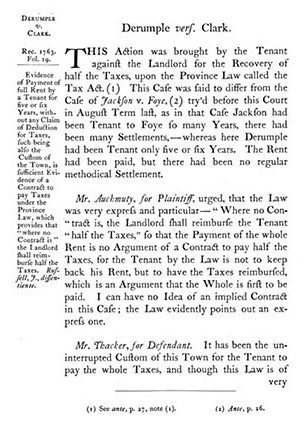
[P. 38]
3 George III (Feb.) in the Superior Court of Judicature
1 · brief description
This case involves the same contract issues as in Jackson v. Foye (1762), Reports, 26, Case 10, supra. Once again, the controversy is caused by the “Tax Act,” which provided that “saving all contracts between the landlord and tenant, and where no contract is, the landlord to reimburse one half of the tax set upon such houses and lands.” See Prov. St. 4 W. & M. (1692); The Acts and Resolves . . . of the Province of the Massachusetts Bay, vol. IV (1757–1768), Boston, 1881, chap. 12, “Province Laws – 1762–63,” 596; and discussion at Case 10, supra. Here the Plaintiff was a tenant of “five or six years.” There was no express contract to the contrary, and the Plaintiff sued the landlord for reimbursement of half of the tax. In a highly interesting decision, the Court found that there was an “implied” contract not to reimburse the tax, partly based on “the Custom of the Town.” As in Jackson v. Foye (1762), Reports, 26, Case 10, supra, Justice Russell disagreed, stating: “I think the Law evidently means an express Agreement. However, I don’t think we have here any Evidence of an implied Agreement, or any Agreement at all.” Reports, 40. In Jackson v. Foye, supra, there was at least some evidence of an express contract, the tenant’s note of hand. Here there was absolutely no evidence of an express contract.
2 · record
Available at Rec. 1763, fol. 19.
Nothing in the Suffolk files.
3 · professionals involved
Robert Auchmuty (1723–1788) appeared for the Plaintiff tenant, seeking reimbursement. Oxenbridge Thacher (1719–1765) appeared for the Defendant landlord. These were “top” lawyers. See full description at Appendix 6, “Brief Biographies.”
Justice Russell appears to have dissented from the outcome, which was supported by the Chief Justice, Justice Oliver, Justice Cushing, and Justice Lynde. Justice Russell rarely dissented, and 58 out of the 78 opinions were unanimous. See Appendix 1, infra.
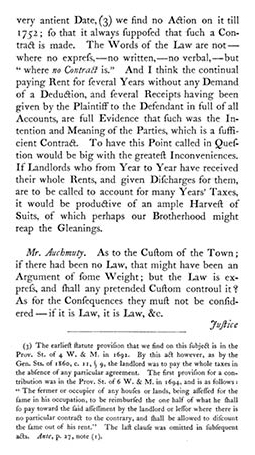
[P. 39]
4 · authority
None cited.
5 · later citations
Derumple v. Clark was cited in Ammidown v. Freeland, 101 Mass. 303, 310 (Mass. 1869), to provide an example of “provisions inserted in the tax acts of Massachusetts from an early period, taxing real estate either to the landlord or the tenant, and giving to the one who actually pays the amount of the tax the right to recover the same or a certain portion thereof from the other.”
6 · note
This is a fascinating case, because the Justices differed among themselves as to law, and there was disagreement on the law even among those who agreed on the outcome.
Justice Russell read the “Tax Act” as requiring reimbursement in the absence of an express contract, which certainly makes sense. Robert Auchmuty argued, rightly, that the “Law was very express and particular,” and the mere fact his client paid the full rent could not give rise to an implied agreement, because the statutory right was for reimbursement only.
For the Defendant landlord, Oxenbridge Thacher (Quincy’s pupil master) argued that it was “the uninterrupted Custom of this Town for the Tenant to pay the Whole Taxes.” This impressed Justice Lynde (“I think the Custom of the Town is a Great Thing”), but not Justice Oliver (“As for the custom of the Town, I can’t think it of any Weight”), Reports, 40. But Justice Oliver thought there was a “strong” presumption of a contract, as in Jackson v. Foye, Reports, 26, Case 10. Justice Cushing combined both the “Custom of the Town” and the “implied contract” argument. “[T]he Intention of these parties . . . may be collected from the Evidence joined to the Custom of the Town.” Reports, 40.
This last argument was what impressed the Chief Justice. “Custom shall not be placed in Opposition to Law, but it may be a Circumstance going to interpret the Intention of the Parties.” Id., 41. The Chief Justice also thought that the landlord had the better of the policy and fairness arguments, a point he expressed in terms of “equity.” “Where the Law is in any Case doubtful and the Equity of it plain, you should verge towards Equity.” Id., 41. The reason for this may be that the law was rarely enforced. As Thacher observed, “[T]hough this Law is of very antient Date [1692], we find no action on it till 1752.” Id., 38–39.
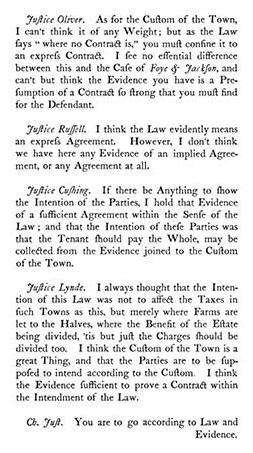
[P. 40]
Here the Justices, once again, “bend” a formal application of the law to achieve a “fair” result by invoking Custom, implied contracts, and equity arguments. What was so interesting in this case is that they each adopted slightly different rationales, and Justice Russell flatly disagreed.
It is notable that there was no appeal to English precedent, even in the arguments. Perhaps this was because of the “equitable” and “local” nature of the statutory dispute, although the legal principles involved were commonly debated in England. See J. H. Baker, supra, pp. 208–212.
CASE 18
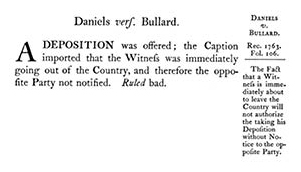
[P. 41]
3 George III (Feb.) in the Superior Court of Judicature
1 · brief description
The sole issue was whether a deposition was admissible when the opponent Party was not notified. The only grounds were that “the Witness was immediately going out of the Country.” This was not sufficient to excuse lack of notice.
2 · record
Available at Rec. 1763, fol. 106.
Numerous other depositions and papers are available in the Suffolk County Files, including:
vol. 494, fol. 58, index no. 83898
- (1) Attestation by justice of the peace
- (2) Deposition of Henry Bullard
- (3) Deposition of Jemima Bullard
- (4) Deposition of Nathan Partridge
- (5) Deposition of Josiah Rockwood
vol. 495, fol. 1, index no. 84041
- (1) Agreement to send dispute to referees (arbitration)
- (2) Notice to referees of agreement between parties
- (3) Deposition of Elijah Clark
3 · professionals involved
Not indicated.
4 · authority
None cited.
5 · later citations
None.
6 · note
This is still good Massachusetts and federal practice. See F.R. Civ. P. 27; Donald J. Savery, Frank C. Corso, William T. Harrington, Massachusetts Practice, vol. 46, Federal Civil Practice, 327–328 (1998).
CASE 19
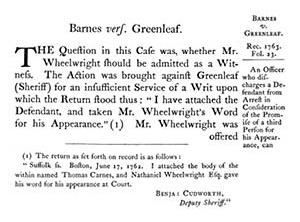
[PP. 41–42]
3 George III (Feb.) in the Superior Court of Judicature
1 · brief description
The Defendant Sheriff (Stephen Greenleaf) arrested one James Barnes and then released him, on the word of one Wheelwright that Barnes would appear in court. The issue, as in Wrentham Proprietors v. Metcalf, Reports 36, Case 16, supra, was whether Wheelwright was too interested in the outcome of a dispute between the Plaintiff and the Sheriff about the release of Barnes to appear as a witness. (The Sheriff argued that the prisoner was released with the Plaintiff’s consent, and Wheelwright apparently would have supported this.) The Court held that the Sheriff would not have recourse against Wheelwright if the Sheriff was found to have deviated “from the Path of his Duty,” therefore Wheelwright was not interested in the outcome and could testify.
2 · record
Available at Rec. 1763, Fol. 23.
Nothing in the Suffolk Files.
3 · professionals involved
Not indicated.
4 · authority
None cited. Quincy himself added a citation at Reports, 42, to that colonial favorite, [Matthew] Bacon’s Abridgement, vol. 4, 462–463, which was on point. Volume 4 was first published in London in 1759. See Sweet & Maxwell, supra, vol. 1, 16.
5 · later citations
Samuel Quincy noted several subsequent cases on this issue: Denny v. Lincoln, 5 Mass. 385 (Mass. 1809); Ayer v. Hutchins, 4 Mass. 370 (Mass. 1808); Foster v. Clark, 36 Mass. 329, 19 Pick. 329 (Mass. 1837); and Pollard v. Graves, 40 Mass. 86 (Mass. 1839). Reports, note 2, page 42.
6 · note
Another example, like Reports 36, Case 16 (Wrentham Proprietors v. Metcalf), of the old common law rule that persons could not testify in a case in which they were a party, or had a direct interest in the outcome, because of a likely bias. Here, the Plaintiff’s lawyer was making aggressive use of the doctrine, and rightly lost.
CASE 20
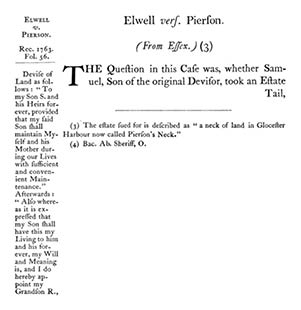
[P. 42]
3 George III (Feb.) in the Superior Court of Judicature
1 · brief description
This is another case, like Dudley v. Dudley, Reports 12, Case 9, in which a poorly drafted will is challenged as to whether or not it established an entail. These are important cases, with much riding on the outcome. The direct heir could convey the land outright, if it was not entailed, but the land could be “locked in” if an entail existed. Here, the Court decided that the words technically established an entail, but that the duty in the will to “maintain Myself and his Mother during our Lives with sufficient and convenient Maintenance” resulted in a fee simple instead!
2 · record
Available at Rec. 1763, Fol. 50.
Additional papers in Suffolk Files vol. 479, index no. 80289, and vol. 493, index no. 83617, including:
- vol. 479, index no. 80289
- • Court record and case description (2½ pages) from Essex County Superior Court of Judicature Court of Assize, dated 10/10/1759
- vol. 493, index no. 83617
- • Bill of costs from Essex County Superior Court, dated 1762.
3 · professionals involved
Oxenbridge Thacher (1719–1765), Quincy’s pupil master, appeared for the Plaintiff, the eldest son of the direct heir, arguing for the entail. He was joined by Jeremiah Gridley (1701/2–1767). Robert Auchmuty (1723–1788) appeared for the Defendant, and argued against the entail. These were the “cream of the crop” of Boston’s practicing bar. See Appendix 6. Thacher had studied law under Gridley, and the two occasionally collaborated.
4 · authority
Thacher began his argument for the entail with a very important assertion, albeit directed at a side issue in the case. Apparently, it was “objected that there were but two witnesses to the will.” Reports, 43. Thacher observed that at the time the will was made “the Law required but two” because “[t]he Statute of Frauds was never supposed to extend here, till we made a like Law here,” citing Old Colony Laws (1672 ed.), 158. See Prov. St. 4 W.&M. Anc. Chart. 233 for the colonial statute, adopted in 1693. The Statute of Frauds was adopted in 1677, 29 Car. 2. c.3.
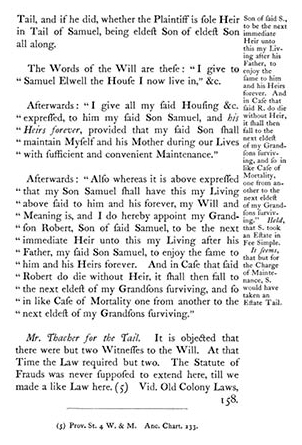
[P. 43]
Thacher then went on to cite much English case authority on the central issue, as did Auchmuty on the other side. Characteristically, Gridley, also arguing for the tail, referring to relatively few English authorities, but rather arguing from a general law of construction, i.e., “every Word shall be operative if possible.” Reports, 45.
The nature of the cases cited demonstrated extensive research, and excellent libraries, available to both sides. Sonday’s Case from 9 Coke’s Reports 128 [1572–1616], first published in 1613 (Sweet & Maxwell, vol. 1, 296:31), was cited by Thacher for the distinction between a remainder over to a stranger, as opposed to kin, as were two cases from Croke’s Reports (Jacobean) (covering 1542–1641), first published in 1657 (Sweet & Maxwell, vol. 1, 298:37). More recent cases were cited from 1 Lord Raymond’s Reports 569 (covering 1694–1732), first published in 1743 (Sweet & Maxwell, vol. 1, 307:105, and Law Commonplace, p. [70], n. 2) and Lord Talbot’s Reports 1 (covering 1730–1737), first published in 1741 (Sweet & Maxwell, vol. 1, 345:12). Auchmuty also appealed to Coke and Croke’s Reports, arguing that once a fee simple is given “nothing by implication shall take it away.” Reports, 45. Auchmuty and Gridley also referred to Bacon’s New Abridgment of the Law, vol. 2, title “Devise.” See Reports, 46–47. This large, useful legal encyclopedia was published in installments from 1736 to 1766, vol. 2 appearing in 1736. Quincy referred to Bacon’s Abridgment frequently in his Law Commonplace, and possessed copies of Croke’s Reports in his library at his death in 1775. See Appendix 8, infra, “Catalogue of Books Belonging to the Estate of Josiah Quincy jun: Esq: Deceas’d,” item 80.
5 · later citations
This case has never been cited by later Massachusetts courts, and probably for the reason noted by Samuel Quincy, Reports 48, S. Quincy n. 9. According to Samuel Quincy, Gridley’s textual argument was correct, and “never was any maintenance construed to make a fee-simple when a clear tail was,” citing T. Jarman’s Treatise on Wills, vol. 2, 172 (1841, 1844) originally published in two volumes, the second appearing in 1844 (Sweet & Maxwell, vol. 2, 185). As Jarman noted, “[F]or where the direction to pay is imposed on a person to whom there is given . . . an estate tail whether limited in express terms, or arising constructively by implication . . . the charge is inoperative to enlarge such . . . estate tail, to a fee simple.” Id., 172–173. Samuel charitably suggests that “the Court must have considered the intent of the testator to be doubtful,” but the Chief Justice actually said the opposite. Reports, 48. As a point of law, the case appears wrongly decided.
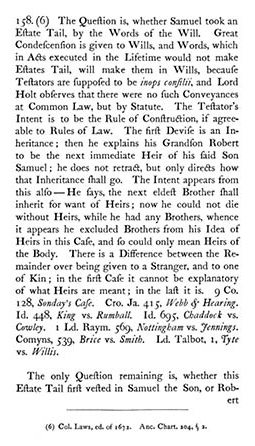
[P. 44]
6 · note
This case is important for two reasons. First, it shows the reliance by the best advocates in the colony on reported English cases, some over two hundred years old, in arguing a complex legal issue. Ironically, the second reason for its importance is because the Court, in the end, paid little attention to these authorities.
The best argument for finding an entail was thoroughly supported by the English authorities. The maker of a will cannot explain what he meant to do after his death. In attempting to discover his intent, the Court should try to make every word used “operative,” as Gridley argued: “[E]very word shall be operative if possible . . . if he [Samuel, the son] took a Fee, the Last Words go for Nothing.” Reports, 45. The Chief Justice’s questions during argument show him using such a textual approach. See Reports, 46, 47.
The Court clearly had trouble with this case, however, and adjourned judgment. On announcing the opinion, the Chief Justice said it “was unanimous that Samuel by the Words would have taken a Tail,” i.e., the textual approach, but that “the Burden and Duty of Maintenance made it a Fee Simple.” Reports, 48. In short, the Court acknowledged the validity of the textual argument, but found it trumped by the practical concerns of the son’s duty to maintain his Mother “with sufficient and convenient Maintenance.” Reports, 43. Whether the Court was also expressing a covert hostility to entails, whose validity in Massachusetts was challenged in other leading cases such as Dudley v. Dudley (1762), Reports 12, Case 9, is open to conjecture.
CASE 21
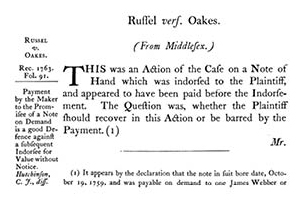
[P. 48]
3 George III (Feb.) in the Superior Court of Judicature
1 · brief description
This is an important case about negotiable commercial papers. “A note of hand,” payable to “James Webber or order,” is indorsed to the Plaintiff, but the promisor, the Defendant, had already paid the indorser. The Plaintiff did not know of the payment when he took the note. The Court found for the Defendant, but the Chief Justice was in dissent. The problem, of course, is that good faith holders for value of such notes, without notice of such a payment, can be left with only an action against the indorser, who may be judgment proof. As the Chief Justice observed, “If this Action be barred, it seems to me that one half of the Trade must be extremely precarious, for it rests upon such Bills, whose Credit must be destroyed.” Reports, 50.
2 · record
Available at Rec. 1763, Vol. 91. See also the file, August 4, 1761, No. 82195 which contains:
- Russell v. Oakes, (same) Aug. 4, 1761, No. 82195.
- • Jury Findings-jury found that the note at issue was made and given by Oaks for valuable consideration, and after the giving of the note, but before its endorsement, the sum of the note was paid by Oaks to Webber in order to discharge it, and Webster accepted it thereafter; and Plaintiff at the time of endorsement did not know that it had already been paid on Aug. 11, 1761, so the Plaintiff ought to recover the sum of 2.12:8 with costs.
- • Fragment of Recognizance to Prosecute Appeal from Dec. 1761.
3 · professionals involved
Counsels in this case were among the most distinguished of the bar. Edmund Trowbridge (1709–1793) appeared for the Defendant, as did Jeremy Gridley (1701/2–1767). See biographies in Appendix 6. Gridley, John Adams’s pupil master, became Attorney General in 1767. Trowbridge was Attorney General from 1749–1767, and became a Justice of the Superior Court in 1767. They were opposed by Benjamin Kent (1708–1788), for the Plaintiff, who became Attorney General in 1776. See his biography in Appendix 6. Thus all the counsels in this case either were, or would become, Attorney General!
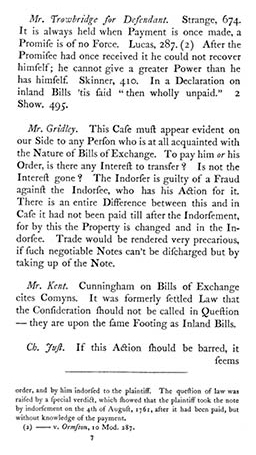
[P. 49]
4 · authority
Trowbridge cited four English cases, Jefferies v. Austin (1725), 1 Strange’s Reports 674 (1716–1749), 2 vols., 1755 (Sweet & Maxwell, vol. 1, 309:124, Law Commonplace, p. [21], n. 12); Anonymous v. Ormston, Lucas’ Reporter 286 at 287-part 10 of Modern Reporter (covering 1702–1710), eds. in 1736, 1741, 1769 (Sweet & Maxwell, vol. 1, 305:88); Hill v. Lewis (1694), Skinner’s Reports, 410 (covering 1681–1697), 1728 (Sweet & Maxwell, vol. 1, 309:121); and Claxton v. Smith (1686), 2 Showers’ Reports 494, at 495, (covering 1678–1694), pt. 2, 1720 (Sweet & Maxwell, vol. 1, 309:119, Law Commonplace, p. [82], n. 1). Gridley cited to no English authority, but argued the policy implications of requiring the promisor to actually find and destroy the note if he wants to pay it. Kent, in opposition, cited to Cunningham’s The Law of Bills of Exchange etc. London, 1760, with further editions in 1761 and 1766 (see Sweet & Maxwell, vol. 1, 521:30) which he stated also cited Comyns Reporter (covering 1695–1741), 1744 (see Law Commonplace, p. [32], n. 2).
5 · later citations
This was good law in Massachusetts until the statutory reforms of 1839. See Baker v. Wheaton, 5 Mass. 509, at 512 (1809); Hemenway v. Stove, 7 Mass. 58 (1810); Mass St. 1839, c. 121, § 1; Gen. Sts. C.53, § 10. It was actually cited as authority in Quincy’s Reports itself. See Tuttle v. Williston, Reports, 333, Case 70, at 336.
6 · note
This case demonstrates a major division of the Court about a very important topic, and a willingness to pick and choose among many English precedents in a matter highly important to the law of trade. The Chief Justice was right that applying a defense between the original parties to a note against a bona fide purchaser for value without notice damages free negotiability. In his words, “It destroys the Distinction between Notes negotiable and not.” Reports, 50. On the other hand, it puts the original promisor in a practical dilemma. How can he discharge the note without getting possession of the actual note itself, which may have circulated through dozens of hands? This was the core of Gridley’s argument for the Defense. While both Trowbridge and Kent relied on English authority, it was ignored by both Justice Russell and the Chief Justice, who appear to have relied solely on policy arguments.
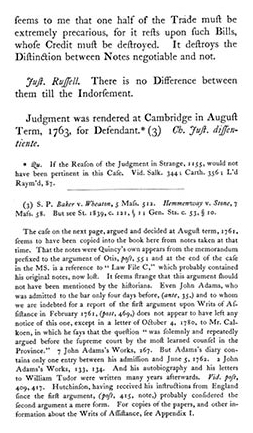
[P. 50]
In the end, Gridley’s policy argument seems to have prevailed, i.e., that the innocent bona fide purchaser of the note could always sue the indorser for fraud, as indorsing a fully paid note is clearly a deceit. Whether Justice Russell was correct in responding to the Chief Justice’s concerns about negotiability that “there is no difference between them [notes negotiable and not] till the Indorsement” is a different matter. The note in this case was made out to the promisee “or order.” It was clearly meant to be negotiable, and was, therefore, not the same as a non-negotiable note, even before indorsement. The outcome of the case would make such negotiable notes less safe in the Commonwealth, which doubtless led to the later statutory changes.
Today, Article 3 of the Uniform Commercial Code generally provides that payment would not be a defense against a holder in due course, so that makers of negotiable notes should never pay unless the note is surrendered. My distinguished colleague, James Rogers, has pointed out that the issue still arises in the disorganized market for second mortgages, where a person pays off a mortgage without ensuring that the original note is surrendered. This has permitted the dishonest sale of such prior mortgage notes. The drafters of American Law Institute’s Restatement of the Law of Mortgages argued that third parties holding such mortgages should not have automatic recourse against the original parties to the mortgage, resulting in much controversy, including a proposed revision to UCC sec. 3-605 to permit the defense of payment if the obligor has not been notified that the mortgage note has been transferred. My thanks to James Rogers.
CASE 22
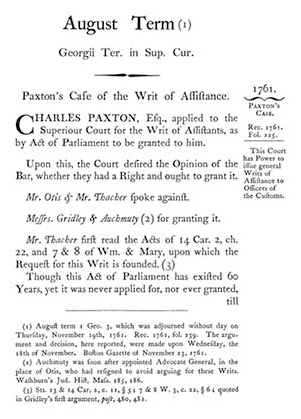
[P. 51]
ILLUSTRATION 16: Boston Evening Post, Sept. 14, 1761, 4. See the Notice signed by Charles Paxton, top center, of Sept. 2, 1761. See also Paxton’s Case of the Writ of Assistance (1761), Reports, 51 (Case 22). Courtesy of Early American Newspapers, and Archive of Americana Collection. Published by Readex (Readex.com), a division of NewsBank, inc.
Paxton’s Case of the Writ of Assistance (1761)
1 George III (Aug.) in the Superior Court of Judicature
Note: This case is out of chronological order, but the notes are Quincy’s, probably copied in from notes taken in August term, 1761. See S. Quincy, unnumbered note, Reports, 50.
1 · brief description
This is the famous second argument of the “Writ of Assistance” case, a case of the greatest political importance. In June of 1755 Charles Paxton, in his capacity of “Surveyor of all Rates, Duties and Impositions arising and growing due to his Majesty at Boston,” sought a “Writ of Assistants” under “the Seal of this Superiour Court in the Legal form & according to Usage in his Majestys Court of Exchequer & in Great Britain.” See Reports, Appendix I, p. 402. (The correct historical name for the writ, as Gridley would later argue, is “Assistants, not assistance.” See Reports, 56–57.) Samuel Quincy’s original edition of Quincy’s Reports in 1865 contained two “Appendices” related to this case, prepared by Horace Gray, Jr., who became Chief Justice of the Supreme Judicial Court and a Justice of the Supreme Court of the United States. (For a full account of Gray’s involvement with the Reports, see Mark G. Sullivan, “Phantom References to Quincy’s Reports in the Massachusetts Supreme Judicial Court Reports,” Appendix 5, infra.) Gray’s Appendix I addressed the issue “What are writs of assistance?” and other legal issues. See Reports, 395–540. Appendix II contained Gray’s accounts of Gray, Treasurer of the Province of Massachusetts Bay v. Paxton (1761), Province of Massachusetts Bay v. Paxton (1762), and Erving v. Cradock (1761), related civil actions. See Reports, 541–572. As to other contemporary accounts, see The Legal Papers of John Adams (eds. L. Kinvin Wroth, Hiller B. Zobel), Cambridge, 1965 vol. 2, 106–107; Samuel A. Green, James Otis’s Argument Against The Writs of Assistance, 1761 (Cambridge, 1890), 4–8; and James M. Farrell’s excellent account “The Writs of Assistance and Public Memory: John Adams and the Legacy of James Otis,” 79 New England Quarterly (2006), 557. See also the general account of the controversy in The Boston Gazette and Country Journal, November 23, 1761, 3.
The Writ here was being sought pursuant to Statute 13 & 14 Car.2 c. 14, sec. 5, which authorized “the Officers of our Customs & their Deputies . . . to go & enter aboard any ship or vessel outward or inward bound” or “to enter & go into the vaults cellars warehouses shops . . .” then “to seize and from thence to bring any kind of goods or merchandise whatsoever prohibited & uncustomed . . .” See Reports, 419–421, Appendix I. Such a general warrant was, naturally, resented by Boston merchants, who bitterly opposed it. See “Petition of the Merchants,” February 1761, Reports, 412–413. Very significantly, the Court sought “the Opinion of the Bar, whether they had a right and ought to grant it.” Reports, 51. Despite eloquent arguments against the Court issuing such a Writ, made by James Otis and Oxenbridge Thacher, the Writ was approved by a unanimous court. Reports, 57.
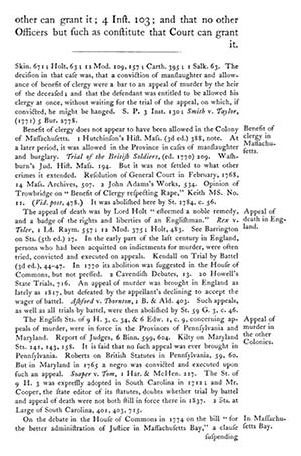
[P. 53]
2 · record
Available at Rec. 1761, fol. 225. Many additional legal records from related cases were set out by Horace Gray, Jr., in Appendix I to the 1865 1st edition of the Reports, as indicated above.
3 · professionals involved
The case was argued because the Court “desired the Opinion of the Bar.” Reports, 51. Whether counsel were retained by interested parties, or were speaking their own views, is unclear on the record. All four advocates were leaders of the Bar. See Appendix 6, “Brief Biographies.” Certainly, historical events would show Otis, arguing against the Writ, to be a fervent patriot, and Auchmuty arguing for the Writ, to be a firm Tory. This was most certainly one of the two arguments that made the professional reputation of James Otis, Jr. (1725–1783). He was joined by Oxenbridge Thacher (1719–1765), Quincy’s pupil master and another senior member of the bar. Otis had been Advocate General in Admiralty since 1756, but resigned to avoid arguing for the Writ, as Samuel Quincy noted. Reports, 51, n. 2. See Appendix 6. Arguing to grant the Writ were the two most respected members of contemporary bar, Jeremy Gridley (1701/2–1767) and Robert Auchmuty (1723–1788). See Appendix 6. Gridley died within months of being appointed Attorney General in 1767. Perhaps mercifully, he never saw the Revolution. Auchmuty, on the other hand, was proscribed in 1778, after replacing Otis as Advocate General and then serving as Judge of the Crown-dominated Vice Admiralty Court from 1767–1776. Interestingly, Otis, Thacher, Gridley and Auchmuty all collaborated with each other in arguing regular cases.
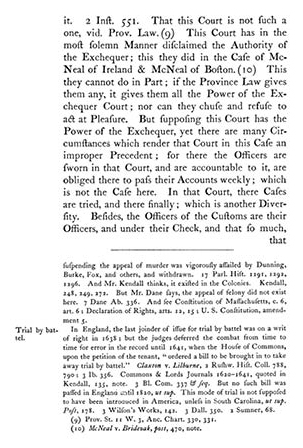
[P. 54]
4 · authority
Both sides relied heavily on Edward Coke, the great authority of the English common law. Arguing that “non-user is a great Presumption that the Law will not bear it,” Thacher relied on Coke on Littleton (First Institutes) (London, 1628), 81a–81b. Thacher also relied on Holt, another great English Common lawyer, for the proposition that this Writ cannot be discretionary, but must either be required by law or not, quoting Holt, “There can be no discretionary Power whether a Man shall be hanged or no.” Armstrong v. Lisle (1697), Comberbach Reports, 410 (covering 1685–1698), London, 1724. Thacher also appealed to Coke’s Fourth Institutes, 103, London, 1644, for the proposal that the Writ must issue from the Exchequer Court, and to Coke’s Second Institutes, 551, London, 1642, for the proposition that no other court could issue it.
Quincy was absent for most of Otis’s great argument. “Mr. Otis was of the same side [as Thacher], but I was absent while he was speaking, most of the Time, and so have but Few Notes.” Reports, 55. Nevertheless, the authorities noted for Otis are fascinating. There was a predictable reliance on English criminal law authorities, Hawkins, Coke and Viner, Reports, 56, but also extensive citation to Rapin’s History of England (2nd ed.) London, 1732, as Samuel Quincy noted, Reports, 55, S. Quincy n. 14.
Gridley and Auchmuty’s arguments for the Writ also cited to English authorities, including Bacon’s Abridgment and Coke’s Fourth Institutes, supra, but the core of these arguments were largely a matter of strict application of the words of the statute. Auchmuty also argued that these were earlier grants of the writ in the colony “in Chief Justice Sewall’s time.” Reports, 56. For this assertion, there as no citation of authority. Gridley also argued that “every other Plantation Court” had given “their Superiour Court” power to issue the Writ of Assistants. This argument was in at least Samuel Quincy’s view-wrong. See Reports, 57, S. Quincy n. 27.
5 · later citations
One of the greatest of all pre-revolutionary legal cases, Paxton’s Case has been widely cited ever since, including seven times by the Supreme Court of the United States. The most recent example is Justice O’Connor’s dissent, joined by Justices Brennan, Marshall and Stevens, in Illinois v. Krull, 480 U.S. 340, 363 (1987). It has also been widley discussed by historians. Horace Gray’s Appendix I is a good early example. See Reports, 395–540, and Appendix 5, “Cases Citing to Quincy’s Reports,” infra. Paxton’s case has also been cited by the Supreme Judicial Court itself and by other state and federal courts, including courts in Indiana, Pennsylvania and Maine, and the Court of Military Appeals. See Appendix 5, infra, for a full list.
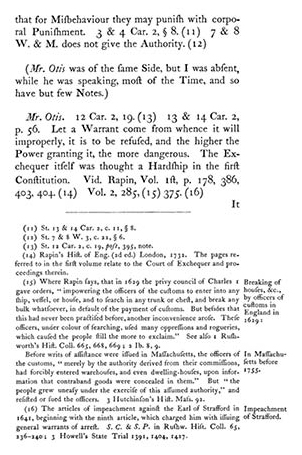
[P. 55]
6 · note
The Writ of Assistants (more correct than “Assistance,” see Note 1, supra) was used by the Court of the Exchequer pursuant to 14 Car. 2, ch. 22 (the “Act”) as a powerful general warrant to secure goods on which tax was owed to the government. Smuggling in the colony led, in June of 1755, to an effort by the customs officers in Boston to use the Writ under the seal of the Superior Court, to enter boats and houses without the usual common law procedures.
There were essentially three arguments against this. First, as Thacher argued, the Writ had never been issued by the Superior Court in Massachusetts, despite 60 years since the passage of the Act. Why? The “non-user” suggested a wise presumption against the validity and wisdom of the act itself. Reports, 52. Otis put it more strongly, “[i]t is worthy consideration whether this Writ was constitutional even in England.” Reports, 56. As Samuel Quincy noted, Otis’s first argument in February 1761 stated that “An act of Parliament against the Constitution is void.” Reports, 56, S. Quincy, n. 17. By “Constitution” Otis, according to Samuel Quincy’s notes, was referring to the famous section of the Magna Carta, conventionally numbered c.39 in the 1215 original, that “[n]o freeman shall be captured or imprisoned or disseised or outlawed or exiled or in any way destroyed, nor will we go against him or send against him except by the lawful judgement of his peers or by the law of the land.” See J. C. Holt, Magna Carta (2d ed., 1992), 461. Samuel Quincy also cited to Coke’s assertion in Coke on Littleton, supra, that statutes should be construed “by the rule and reason of the common law.” Reports, 56, S. Quincy, n. 22.
Otis’s second argument was that the Act was passed after the First Massachusetts Charter and, hence, “not there invented until after our Constitution and Settlement.” Reports, 56. This would bring in question all subsequent English Statutes. In addition, the Chief Justice had already ruled that such writs had already been issued in the colony by the Governor, even if improperly. Reports, 52.
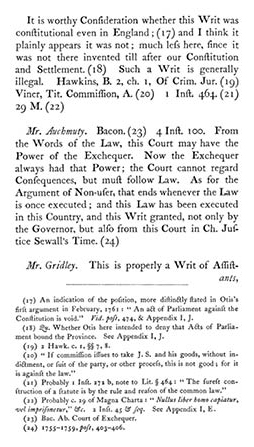
[P. 56]
A final argument was that the Writ was designed to be issued by the Court of Exchequer, and the Superior Court lacked the safeguards of the English Court of Exchequer, “for there the Officers are sworn . . . and are accountable to it, are obliged there to pass their Accounts weekly, which is not the Case here.” Reports, 54. The Exchequer had direct supervisory power over the customs officers and could punish them directly. Reports, 55.
Early on, the Chief Justice had interrupted Thacher to attack the “non-user” argument, because the writs had been issued by the Governor in the past. Auchmuty and Gridley both argued that the Superior Court had all the power of the English Exchequer in Massachusetts, citing “728 Wm 2 M. ch.18.” (By this they must have meant “St. 7. 28. William 3, c.22, rec. 6,” as Samuel Quincy points out.)
As for the “constitutionality” argument, it was ignored. But Gridley did point to the fact that the Writ did not give customs officers unlimited power. “This is properly a Writ of Assistants, not Assistance; not to give the Officers a greater Power, but as a Check upon them. For by this they cannot enter into any House, without the Presence of the Sheriff or civil Officer, who will be always supposed to have an Eye over and be a Check upon them.” Reports, 57.
Gridley concluded by saying: “Quoting History [clearly referring to Otis] is not speaking like a Lawyer. If it is Law in England, it is Law here. . . .” Reports, 57.
Ironically, this case really was more about history than law. The Court unanimously granted the Writ, with no discussion. Gridley was lucky to die before the Revolution and, again, his colleague, Auchmuty, was proscribed in 1778. Writ of “Assistants” (or, if you will, “Assistance”) were to be specifically barred by the Bill of Rights. Otis’s argument, as Gridley correctly observed, was not to this Court or to the legal issues, but to a future political order and, indeed, it ensured his place in history. How unlucky Quincy must have been to have be absent from Otis’s argument “most of the Time.” Reports, 55.
CASE 23
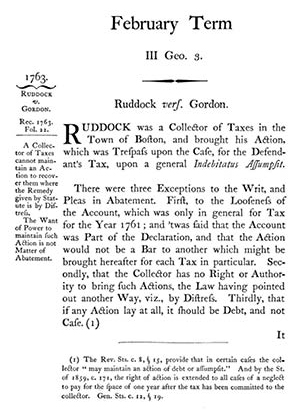
[P. 58]
3 George III (Feb.) in the Superior Court of Judicature
1 · brief description
The Plaintiff, collector of taxes in Boston, brought an action against the Defendant in the standard contractual form of a trespass on the case “indebitatus assumpsit” (Law Commonplace, p. [96], n. 9). It was objected: (1) that the collector’s account was too general and might not bar future, more specific actions for back taxes; (2) that the collector had no right to bring such a civil action, but should use distress instead; and (3) that the action, if proper at all, should be in debt. The Court held that the collector’s authority should not be decided in connection with a plea in abatement, but at trial on the merits. Nevertheless, “being asked by both parties on that point,” the Court held that the tax collector had no power to bring such actions, but apparently must proceed by distress.
2 · record
Available at Rec. 1763, fol. 22.
3 · professionals involved
No indication.
4 · authority
None cited.
5 · later citations
None. As Samuel Quincy noted, later Massachusetts statutes gave the collector an explicit power to maintain “an action of debt or assumpsit.” See Reports, 58, S. Quincy n. 1, citing Mass. Rev. Sts. C.8 § 15. Massachusetts courts also later would hear a disability that “destroys the plaintiff’s right of action” either “in abatement or bar,” Langdon v. Potter, 11 Mass. 313 (Mass. 1814), a much more sensible approach. See Reports 59, S. Quincy n. 2.
6 · note
This is a very odd case. Having ruled that the issue of the tax collector’s right to bring this action should not be decided at the pleading stage by a writ of abatement, but rather later at trial, the Court then ignored its own ruling and decided the issue anyway, just because the parties urged it to do so. The ultimate decision certainly seems reasonable, as the tax collector always had the power of “distress,” i.e., to seize possession of personal chattel to force payment of back taxes, in the same way usually allowed for back rent. See Bouvier’s Law Dictionary (8th ed., F. Rawle, 1914), vol. 1, 872–898. (Hereafter, Bouvier’s.) While a common law action for money might be more effective in some cases, that power was not explicitly given by statute until after the Revolution.
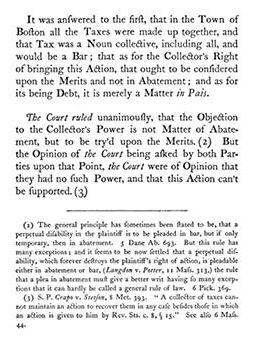
[P. 59]
It is disappointing that the Court never had to reach the issue of whether the tax collector could use trespass on the case indebitatus assumpsit, or would be required to sue in debt. Debt was the ancient remedy for a sum certain in money, but at least since Slade’s Case, 9 Coke’s Reports 57(b) (1611), the Plaintiff would normally have an election between debt and an action on the case indebitatus assumpsit (“being indebted, did undertake”). The latter cause of action, originally based on the fiction of a subsequent promise, permitted jury trial and damages, as opposed to the old wager of law process and simple restitution. See A.W.B. Simpson, “The Place of Slade’s Case in the History of Contract,” 74 Law Quarterly Review (1955), 381. Whether these distractions made any difference in Massachusetts law a century and a half later would have been interesting. The arguments on behalf of the tax collector that uncollected taxes were “merely a Matter in Pais,” i.e., lacking the legal formality or certainty for establishing a debt, does not really answer the question. See Bouvier’s, supra, vol. 1, 1523. In theory, action on the case in assumpsit lay “as well where it is certain,” while debt lay where the sum due “is certain or ascertained in such a manner as to be readily reduced to a certainty.” Id., vol. 1, 787.
In any event, this case demonstrates the Court’s willingness to overlook pleading formalities to reach a quick resolution of underlying issues. The irate tax collectors later took their cause to the legislature in a “Memorial of John Ruddock . . .” to the Governor, Council, and General Court, set out in the Boston Evening Post of Sept. 12, 1763, in which they attacked the “ruled case in the superior court of judicature.” Id., 2. The “Memorial” sought legislation to permit the tax collectors to bring an “action of Debt before . . . any Court of Record.” The committee charged to consider the “Memorial” were not entirely sympathetic. The report, by Edmund Trowbridge, observed that “said Collectors are already duly and sufficiently empowered to collect the taxes in almost all cases” and “[t]hat it would not be advisable to impower them to recover the money by action.” Id., 3.
CASE 24
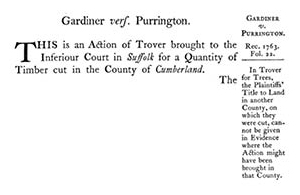
[P. 59]
3 George III (Feb.) in the Superior Court of Judicature
1 · brief description
The sole issue in this case was whether, in a case to recover the value of cut timber, evidence of title of the land could be given in a proceeding other than one in the county where the land was located. The Court held that, in the absence of “necessity” or reason why a case could not be tried in that county, the evidence of title was not admissible.
2 · record
Available at Rec. 1763, fol. 22
3 · professionals involved
The argument for the Plaintiff was by Jeremy Gridley (1701/2–1767), John Adams’s pupil master and arguably “the greatest New England lawyer of his generation.” See Appendix 6. He was opposed by his distinguished peers, Robert Auchmuty (1723–1788) and Benjamin Kent (1708–1788). See Appendix 6 for descriptions of all three. Gridley and Auchmuty combined on the same side in arguing for the Writs of Assistance. See Reports, 51, Case 22, Paxton’s Case of the Writs of Assistance (1761).
This case is remarkable for recording a candid discussion between Justice Russell and the Chief Justice, as they “worked out” a solution in open court.
4 · authority
Both sides cited a variety of English law cases: Brown v. Hedges (1708), 1 Salkeld’s Reports (covering 1689–1712), 290, see Law Commonplace, p. [32], n. 7; Walrond v. Van Moses (1724), Modern Cases (Part 8 of Modern Reports) 321, see Law Commonplace, p. [35], n. 2; and Rogers v. Dove (1652), Style’s Reports (covering 1646–1655), 331, see Sweet & Maxwell, vol. 1, p. 310. There is also a citation to Lilly’s Abridgment, which addresses transitory tort actions on page 20 of volume 1. See Sweet & Maxwell, vol. 1, p. 273. Both sides also appealed to Bacon’s New Abridgment of the Law, a common multi-volume legal encyclopedia first published in London in 1736 through 1766, in parts. Volume 1, here referred to by both parties, was first published in London in 1736.
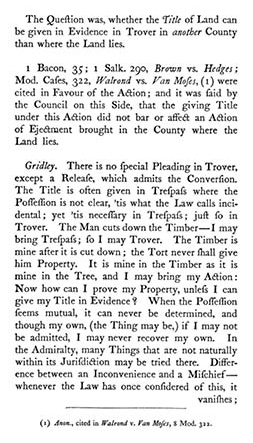
[P. 60]
The Court considered the cited English cases in its conclusion that evidence of title could not be admitted, observing that cases to the contrary were “only cases of necessity.”
5 · later citations
Samuel Quincy observed that later Massachusetts cases did agree with the Court’s decision that when title to land becomes involved, the case becomes “real,” and then should be tried in the county where the land lies. Reports, 62, S. Quincy n. 4. But he questions whether this case really involves title to land, as it is “only offered as a means of proving a right to possession of the trees.” Id. Samuel Quincy specifically refers to the cases of Lord v. Tyler, 31 Mass. 156, 15 Pick. 156 (Mass. 1833); Blood v. Kemp, 21 Mass. 169, 4 Pick. 169 (Mass. 1826); and Boynton v. Willard, 27 Mass. 166, 10 Pick. 166 (Mass. 1830).
6 · note
As Samuel Quincy noted, this was a problematic case. Assume the issue did not involve title to land, but rightful possession of trees that were chopped down by a trespasser. If so, Gridley’s argument that this is an unreasonable burden on the Plaintiff seems compelling. But suppose, as Auchmuty argued, the title of the land itself was “not determined,” and his client was claiming rightful possession of the trees because he, not the Plaintiff, owned the land. See Reports, 61. If so, title was a paramount issue, and it should be tried in the county where the land was located, unless there were exceptional circumstances.
CASE 25
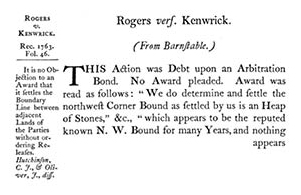
[P. 62]
3 George III (Feb.) in the Superior Court of Judicature
1 · brief description
The sole issue in this case is whether determining a boundary line in an arbitration also determines a title of freehold. If so, it was agreed by both parties that the arbitrators exceeded their powers. The sharply divided Court held that the arbitrators did not determine the freehold, and thus action on an arbitration bond was valid. The Chief Justice and Justice Oliver dissented, the Chief Justice dissented “very warmly.” Reports, 64.
2 · record
Available at Rec. 1763, fol. 46.
3 · professionals involved
Two great patriots argued this case. Robert Treat Paine (1731–1814), a signer of the Declaration of Independence and later a Justice of the Supreme Judicial Court, argued for the Defendant, against the powers of the arbitrators. James Otis, Jr. (1725–1783), the patriot who argued against the writ of assistance in Paxton’s Case, Reports 51, Case 22, was for the Plaintiff. See Appendix 6 for brief biographies of both.
The closely split Court was unusual. Fifty-eight of the seventy-eight decisions reported by Quincy were unanimous. Among the most frequent dissenters was the Chief Justice, and he dissented with Oliver twice. See Appendix 1.
4 · authority
Paine cited a variety of English Yearbook cases and English reporters, including Rolle’s Abridgment, published in London in 1668. See Sweet & Maxwell, vol. 1, 19:18, Law Commonplace, p. [8], n. 9. He also cited Bacon’s Abridgment, vol. 1, p. 132, first published in London in 1736. See Sweet & Maxwell, vol. 1, 16:1. See “Authority” in Cases 20 and 22, Reports 42, 51, supra. All of this authority was for the proposition that “parties themselves cannot pass corporeal Inheritance without solemn Livery [or by appropriate releases].” Reports, 63. Here no act was done by a party, so the arbitrators exceeded their powers if they determined title of freehold.
Otis also relied on Bacon’s Abridgment, supra, vol. 1 on “Arbitrament and Award,” for the proposal that setting a boundary is “but a mathematical line without Breadth or Thickness” and, thus, “does not affect the Freehold.” Reports, 64.
5 · later citations
Josiah Quincy himself questioned the outcome of this case, citing to one of his last manuscript volumes. “Quare, if this Case is not agreeable to law.” Reports, 64.
But in Searle v. Abbe, 79 Mass. 409, 13 Gray 409, 412 (1859), a case concerning the effect of an arbitrator’s decision in a boundary dispute, the successful arguments of James Otis in Rogers v. Kenwrick were quoted by Justice Metcalf. This citation is particularly interesting in that the case was decided before Quincy’s Reports were published in 1865. See the discussion in the excellent note by Mark Sullivan to Appendix 5, “Phantom References to Quincy’s Reports in the Massachusetts Supreme Judicial Court Reports,” infra. Samuel Quincy, citing additional cases, pointed out that an arbitrator’s boundary decision may not actually convey lands, but could operate by estoppel to prevent parties from later disputing the title. Reports, 64, S. Quincy n. 3.
6 · note
It is hard not to agree with the dissenters here, the obviously agitated Chief Justice and Justice Oliver. Josiah Quincy also apparently felt the dissenters were in the right. Otis’s argument about how a line has no significance is simply bogus; shifting the boundary line shifts the area of the freehold. If this should have been done by releases by the parties, then enforcing an arbitration bond was unjust. The strongest argument for the case’s outcome, picked up in the later Massachusetts cases, was simple expediency.
ILLUSTRATION 18: Robert Treart Paine (1731–1814). Portrait by Edward Savage and John Coles Jr., c. 1796–1801. Courtesy, Massachusetts Historical Society. Paine was a signer of the Declaration of Independence. He served as Massachusetts Attorney General (1777–1790) and as a Justice of the Supreme Judicial Court (1790–1804). See brief biography in Appendix 6, infra.
CASE 26
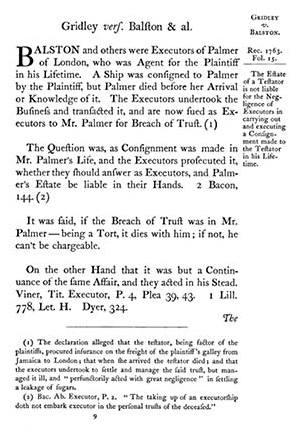
[P. 65]
3 George III (Feb.) in the Superior Court of Judicature
1 · brief description
The sole issue in this case was whether executors of the deceased Defendant, who had been an Agent for the Plaintiff, would be liable in tort for breach of trust for mishandling the deceased’s agency after his death. The Court’s unanimous opinion was that breach of trust was a tort action against the Agent, and died with him.
2 · record
Available at Rec. 1763, fol. 15. The files at the Massachusetts Archives contain the following:
- Gridley v. Balstone, Jan. 1762, No. 170982.
- • Bill of Costs for Court of Common Pleas.
- Gridley v. Balstone, (same) Feb. 1763, No. 171010.
- • Fragment of Judgment for Superior Court of Judicature.
- Gridley v. Balstone, (same) Aug. 1763, No. 171131.
- • Writ of Review for Superior Court of Judicature at Suffolk County.
- Gridley v. Balstone, (same) Nov. 1762, No. 171142.
- • Bill of Costs for Superior Court of Judicature, Boston.
3 · professionals involved
No indication.
4 · authority
Bacon’s Abridgment, vol. 2, p. 144, “Executor,” part 2, (London, 1736), was again cited. See Cases 20, 22, 24 “Authority,” Reports 42, 51, 59, supra. This was for the proposition that the executors did not, simply by “taking up of an executorship,” undertake “the personal trusts of the deceased,” as Samuel Quincy correctly noted. See Id., vol. 2, p. 144; Reports, 65, S. Quincy n. 2.
Other English authority was cited for the opposite proposition: that the executor’s actions were “but a Continuance of the same Affair,” including Viner’s Abridgment under the title “Executor and Plea” (first published in London between 1741–1753 in 23 volumes); Lilly’s Practical Register; a General Abridgment of the Law, vol. 1, 778 (just published in two volumes in London, 1719); and Dyer’s Reports, which are of the earliest of the English law reports, first published in 1585 with a substantially increased 6th edition in 1688 (the case cited is Ligeart v. Wiseman, which begins on page 323b of vol. 3). See Sweet & Maxwell, vol. 1, 299: 47. The Court rightly said “these authorities” were “not in Point.”

[P. 66]
5 · later citations
None.
6 · note
This case demonstrates the Court’s critical use of English authority, as it correctly rejected a wide range of citations as irrelevant. Bacon’s Abridgment, vol. 2 (1st ed., London, 1736), widely used by the Court in other cases, was relied on as correct.
The declaration shows the Plaintiff was shipping sugar from Jamaica to London, and the deceased was his Agent in London. But before the deceased even learned of this particular shipment, he died. His executors undertook the business when the ship arrived, allegedly with “great negligence.” The essence of the case was that the executors never agreed to do this business, and it was not automatically part of their duties. In the absence of fraud, the Plaintiff had no recourse. As a matter of policy, it might have been regarded as unfair to require a standard of care of people who never agreed to a business, but who tried to transact it as an emergency measure. The alternative would be no agency at all.
CASE 27
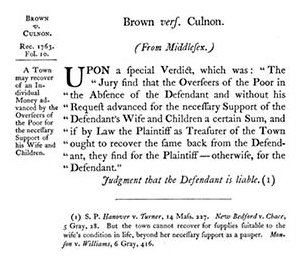
[P. 66]
3 George III (Feb.) in the Superior Court of Judicature
1 · brief description
The sole issue in this case was whether the Overseers of the Poor could collect, from the Defendant, “the necessary Support” paid by the Overseers to the Defendant’s wife and children. The Defendant was absent, and had not requested the support. Held, yes.
2 · record
Available at Rec. 1763, fol. 10.
3 · professionals involved
No indication.
4 · authority
None cited.
5 · later citations
As Samuel Quincy observed, this remained good Massachusetts law, but only for the wife’s “necessary support as a pauper.” Reports, 66, S. Quincy n. 1. He cited the cases Hanover v. Turner, 14 Mass. 227 (1817); New Bedford v. Chace, 71 Mass. 28, 5 Gray 28 (1855); and Monson v. Williams, 72 Mass. 416, 6 Gray 416 (1856).
6 · note
The case came to the Court on special verdict of a jury, i.e., they found the necessary facts but requested guidance on the law. The Massachusetts “safety net” for poverty was local, and put the burden on local authorities. To recover from an absent husband “necessary support” would be reasonable. See Douglas Lamar Jones, “The Transformation of the Law of Poverty in Eighteenth-Century Massachusetts,” Law in Colonial Massachusetts (eds. Coquillette, Brink, Menand, 1984), 153, 158–164. The most common device to provide for destitute single parents with a family was use of a custodial family, which received payments from Overseers. This could lead to serious disputes between the parent and the authority. If the father was in debtor’s prison, the local authority could be in a particularly hard bind. Id., 162–163.
CASE 28
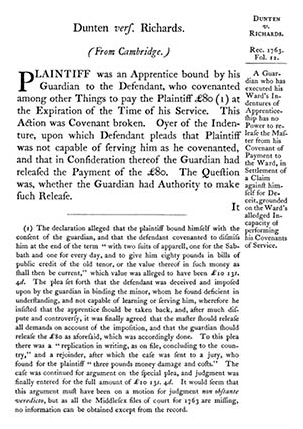
[P. 67]
3 George III (Feb.) in the Superior Court of Judicature
1 · brief description
This was an action on a covenant between an apprentice, a minor, and his master which included an “£80” payment (or same value in “current” money) at the expiration of service (found by the Middlesex Jury to be worth £10,135.4d. in current money). The covenant was entered into by the Plaintiff’s guardian, on the Plaintiff’s behalf. Allegedly, the guardian agreed with the master to forgo the payment, and the master, in turn, released the Plaintiff from apprenticeship, because the Plaintiff was “deficient in understanding” and was “not capable of learning or serving him.” Reports, 67, S. Quincy n. 1, containing the Declaration. Held, unanimously, the guardian had no such authority, and the master had to pay the money.
2 · record
Available at 1763, fol. 12. The Middlesex files of court for 1763 are missing, as Samuel Quincy noted. Reports, 67, S. Quincy n. 1.
3 · professionals involved
No indication.
4 · authority
None cited. The Plaintiff cited one English case, the only one cited in the report, for the principle that “Guardians have no Right to release or give Discharge but for Sums received.” The case was While v. Hall (1616), Moore’s Reports (covering 1512–1621), 852. See Sweet & Maxwell, vol. 1, p. 305.
5 · later citations
As Samuel Quincy noted, Massachusetts law has consistently held that “contracts beneficial to a ward cannot be avoided by the guardian.” Oliver v. Houdlet, 13 Mass. 237, at 240 (1816). Reports, 68, S. Quincy n. 2. It would have been interesting had the master sued the guardian on the subsequent “understanding,” rather than try to avoid the covenant. Samuel Quincy suggests that the common law would not hold the guardian to the covenants of the indenture, although he signed it on behalf of the minor, but a father might be held to an indenture signed on behalf of his son. Reports, 68, S. Quincy n. 2.
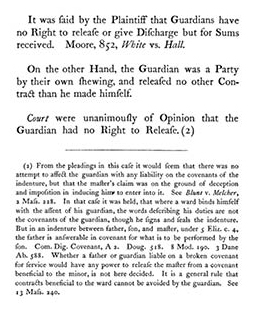
[P. 68]
In Hunting v. Stafford, 183 Mass. 157 (1903), this case was cited to show that guardians in Massachusetts have long been held to have fiduciary obligations to minors, including an obligation not to release contracts beneficial to the minor. Id., 160.
6 · note
Quincy’s Law Commonplace was full of cases involving apprentices and masters. See Law Commonplace, [19]–[20]. In general, these cases made it difficult for either party to easily extract himself from the covenant. Almost certainly, the Defendant master in this case would have found it difficult to dissolve the relationship on the traditional grounds of dereliction, without paying the promised sum. To permit the guardian to release the minor, without the minor’s consent, would permit an evasion of the mutual duties. In addition, there were social security issues. Assume the minor here really was, as the Declaration alleged, “deficient in understanding,” perhaps to the point of mental retardation. The close-knit system of social welfare, based on “custodial families” compensated by local officials, would hardly be benefited if boys, like the Plaintiff in this case, could be too easily “released” from beneficial apprenticeships. They would simply become charges on the public. See Douglas Lamar Jones, “The Transformation of the Law of Poverty in Eighteenth-Century Massachusetts,” Law in Colonial Massachusetts (eds. Coquillette, Brink, Menand, 1984), 153, 157–160.
CASE 29
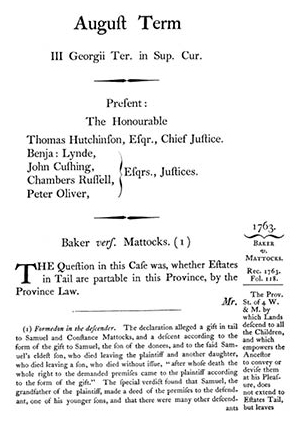
[P. 69]
3 George III (Aug.) in the Superior Court of Judicature
1 · brief description
This was one of the most important cases reported by Quincy. The issue was whether an entail estate was “partible,” i.e., could be split “to all the children alike,” or should go only to the eldest male, if one existed. English common law only gave inheritance to the eldest son-i.e., “primogeniture”-unless the lands were governed by some special custom, such as “gavelkind,” which made the lands partible.
Primogeniture had been abolished in Massachusetts as to fee simple estates by a provincial statute, 4 William & Mary Chap. 8, in 1692. Charter and General Laws of the Colony and Province of Massachusetts Bay (Boston, 1814), 230–236. The statute recited the “assistance” of the younger children in “subduing” the land and the unfairness of excluding them. See Reports, 70, S. Quincy n. 2. But the statute only mentioned “fee simple,” an estate held by what today we would describe as “outright” ownership. A “fee tail” was held by the tenant entail, and then went to his or her children, who were “remainder men.” If there were no “heirs of the body,” the fee reverted to the heirs of the original donor, the “reversioners.” This device, since the Statute De Donis of 1285, had been important in preserving great English landed estates, and through the wide use of the settlements inspired by the “entail male,” ensured male social dominance. See J. H. Baker, Introduction to English Legal History, supra, 273–277, 280–283; Daniel R. Coquillette, Anglo-American Legal Heritage, supra, 95–115.
Thus this case presented a major “choice of law” decision with profound social and gender implications. This was recognized at the time, as Justice Cushing put it, “This point is of great consequence to the Province.” Reports, 73. By a narrowly split court, three to two, it was decided that fee tails were not partible, a victory for reactionary ideas.
2 · record
Available at Rec. 1763, fol. 118. The Declaration and special verdict are particularly important. See Reports, 69–70, n.1.
3 · professionals involved
The informal dean of the bar, Jeremy Gridley (1701/2–1767) and Samuel Fitch (1724–1799) argued for partibility. (While Fitch was, in 1763, relatively junior to Gridley, he later became Advocate General of the Admiralty [1768–1776].) Arguing against partibility was Quincy’s pupil master, Oxenbridge Thacher (1719–1765) and the great James Otis, Jr. (1725–1783). For biographies of all four, see Appendix 6.
It remains curious that the advocates for partibility, a relatively egalitarian idea, were known to be conservative Tories. Indeed, Fitch was proscribed in 1778. Those arguing for the hierarchical entail without partibility were relatively Whig. Otis, of course, was a great patriot, and Thacher’s seat in the House was taken by Sam Adams on Thacher’s death in 1765.
In the oral argument, Otis attacked the idea that there was a “Natural Right of Descent to all Children alike,” and advocated following the English entail, rather than expanding the colonial exception! See “Note 6,” infra, for a further discussion.
The Justices were closely split. There, too, the votes were curious. Chief Justice Hutchinson and Justice Cushing voted for partibility, with Justices Oliver, Russell and Lynde forming the majority. Reports, 72–74. Hutchinson and Oliver were politically Tory, while Cushing was a moderate Whig. But these categories are always overly simplistic. Hutchinson was a complex man, whose loyalty to the crown was balanced with a deep identification with the colony and its institutions, political and legal. See generally Bernard Bailyn, The Ordeal of Thomas Hutchinson (1974), 9–18; William Pencak, America’s Burke: The Mind of Thomas Hutchinson (1982); Andrew S. Walmsley, Thomas Hutchinson and the Origins of the American Revolution (1999). See also John A. Denehy, “Thomas Hutchinson: Chief Justice of the Massachusetts Superior Court of Judicature,” 8 Massachusetts Legal History (2002), 1, 8–15. In any event, the fundamental issues presented by Baker v. Mattocks did not split the Justices on political grounds, but on jurisprudential beliefs about statutory construction and the correct relationship between colonial law and English common law. See “Note 6,” infra.
4 · authority
For such an important case, very little authority was cited. Reference was obviously made by the lawyers and judges on both sides to the Provincial statute, 4 William & Mary, Chap. 8 (1692). Fitch also cited to Coke on Littleton (London, 1628) three times for the proposal that the Statute Westminster “did not alter the Course of Common Law Descents by creating entails, only by limiting them.” He also looked to Viner’s Abridgment (London, 1742–1753) under “Gavelkind,” for the proposition that gavelkind, the custom of partibility in certain English lands, was another relevant precedent, particularly since entails were usually partible in gavelkind lands. (In this he was corrected by Justice Russell, who observed that the common law never applied to gavelkind lands, while the common law did apply here, “unless in the case of particular Estates.” Reports, 70.)
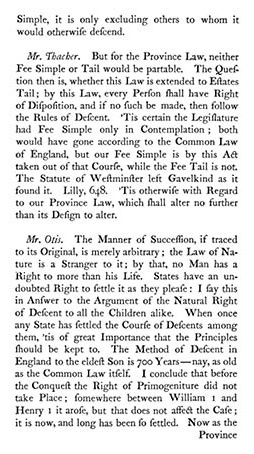
[P. 71]
Thacher, arguing against partibility, referred to Lilly’s Collection of Modern Entries (London, 1723, English trans., 2d ed., 1741), 648, for the proposal that “the statute of Westminster left Gavelkind as it found it,” while it was otherwise with the province law, “which shall alter no further than its Design to alter,” Reports, 71, a weak argument as to the authority cited.
In any event, the most powerful arguments by the opposing senior lawyers, Otis and Gridley, made no specific references to authority at all, but argued instead in terms of historical and legal generalities, of varying accuracy. See the discussion at “Note 6.”
5 · later citations
As Samuel Quincy correctly observed, later Massachusetts law followed the majority opinion, and did not permit partibility when land was entailed. See Corbin v. Healy, 37 Mass. (20 Pickering) 514, 516 (1838); Wright v. Thayer, 67 Mass. (1 Gray) 284, 286 (1854). This was of limited importance, once entails could be broken by statute, through a common deed, but, as Samuel Quincy also pointed out-even in 1865 it couldn’t be done in a will, leaving a drafting “trap for the unwary.” See Mass. Statutes 1791, c.60. This would be no joke for an accidentally disinherited younger child. See Reports, 74, S. Quincy n. 4.
6 · note
This case provides a fascinating insight into the legal minds of 1763 Massachusetts. At stake was the application of a Province statute with clear policy goals. It began by pointing out the differences between Massachusetts and England, “[w]hereas estates in these plantations do consist chiefly of lands which have been subdued and brought to improvement by the industry and labour of the proprietors with the assistance of their children, the younger children generally having been longest and most serviceable unto their parents in that behalf [because older parents are more likely to have land?] who have not personal estate to give out unto them in portions, or otherwise to recompense their labor.” Reports, 70, S. Quincy n. 2; Prov. St. 4 William & Mary, Chap. 8 (1692). The statute concluded by ensuring free divisibility by will by all persons “lawfully served any lands . . . in his own proper right in fee simple” and, in default, to all the deceased; children equally. By statute, therefore, Massachusetts had the same rules of inheritance for fee simples as prevailed in England in land governed by the curator of gavelkind, i.e., originally much of East Anglia and, until 1926, much of the land in Kent, with major difference, gavelkind land went to all sons equally, not to all children equally, unless there were only daughters. See J. H. Baker, An Introduction to English Legal History, supra, 265–266. (Note: many of the original settlers in Massachusetts came from East Anglia.) For two other helpful accounts of the laws of primogeniture and entail in the colonies, see Robert Morris, “Primogeniture and Entailed Estates in America,” Columbia Law Review, vol. 27 (1927), 24–51, and George L. Haskins, “The Beginnings of Partible Inheritance in the American Colonies,” Essays on the History of Early American Law, ed. David H. Flaherty (Chapel Hill, 1969).
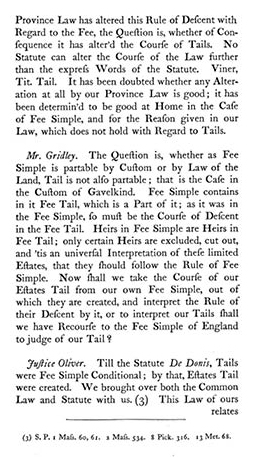
[P. 72]
In gavelkind lands, the “partible” quality of the custom extended to estates tail, “for if a person died seized in tail of lands held in gavelkind, all his sons inherited together as heirs of his body,” rather than just the oldest son, as in common law primogeniture. See Justice Cushing at Reports, 73. Thus one of the major arguments for why the same should be true in Massachusetts was that the effect of the 1692 statute was to make Massachusetts land like those held in gavelkind in England. See the arguments of Fitch and Gridley for partibility, Reports, 70–72.
A second argument for partibility was based on the nature of a fee tail estate. The term “estate tail” or “entail” derives from the Latin “feudum talliatum” and the French “entaille; tailler, to cut.” See Earl Jowitt, The Dictionary of English Law (ed. C. Walsh, 1959), 715–716. (Hereafter, “Jowitt”). The idea is that an entail is a “cut down” fee simple, as that can only be inherited by “heirs of the body,” i.e., blood descendants-as opposed to a fee simple, which could be inherited by any heir. (“In tail male” could only be inherited by blood male heirs.) If there was a failure of suitable issue, the statute of Westminster II, c. 1 “De donis conditionalibus” (1285), provided that the land revert back to the heirs of the original grantor. These heirs of the grantor always had a right to prevent the tenant in tail from alienating the land by a “writ of foremedon” (from “de forma donationis” or form of the gift), than defeating their right of reversion. This was the cause of action used here. See Reports, 69, S. Quincy n. 1. Such heirs of the grantor were called “reversioners.” Likewise, the tenant in tail’s children also had an expectation to inherit, which they could also enforce by the writ of formedon. They were called “remaindermen.” See Jowitt, supra, 715–716, 827.
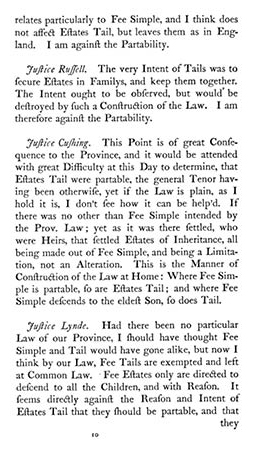
[P. 73]
By 1763 various mechanisms had evolved in Massachusetts to permit a tenant in tail in possession to bar the entail during his or her life. But one could not bar an entail in Massachusetts by will until after 1791, as Samuel Quincy noted at Reports, 74, S. Quincy n. 4.
If an entail was just a “cut down” fee simple, and if fee simples in Massachusetts had been made partible by the 1693 Provincial statute, then-so it would seem to follow-entails were also partible, and so Gridley argued. “Fee simple contains in it Fee Tail, which is a Part of it . . . and ’tis an universal Interpretation of these limited Estates, that they should follow the Rule of Fee Simple.” Reports, 72.
Thacher responded to this argument that, in Massachusetts, “neither Fee Simple or Tail would be partible” except for the 1692 Act. “[O]ur Fee Simple is by this Act taken out of that course, while the Fee Tail is not.” Id., 71.
But the most interesting argument was that of Otis, directed against partibility. He answered an argument never made by his opponents, that partibility was required by the Law of Nature . . . i.e., “the Natural Right or Descent to all the Children alike.” Reports, 71. To this Otis answered “The Manner of Succession, if traced to its Original, is merely arbitrary; the Law of Nature is a Stranger to it; by that, no Man has a Right to more than his Life.” Id., 71. What an extraordinary argument for a patriot, who had argued two years before against the Writs of Assistance, and would support a Revolution founded on “inalienable rights,” including an attack on taxation without representation! See Paxton’s Case, Reports 48, Case 22, Note 6.
Justice Oliver was convinced by the statutory argument to decide against partibility. His reasoning was that the Statute De Donis (Westminster II, c.2) (1285), created the “Estates Tail,” an inaccurate historical view, and “[w]e brought over both the Common Law and Statute with us.” Since the Provincial Law “does not affect Estates Tail” it “leaves them as in England.” i.e., Not partible-Reports, 72–73.
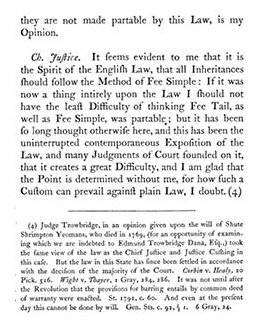
[P. 74]
Justices Russell and Lynde voted the same way, but for more policy-oriented reasons. Entails were designed to keep land in the family, and to keep them from being broken up. “The very Intent of Tails was to secure Estates in Familys, and keep them together.” This would be “destroyed by such a Construction of the Law.” Reports, 73. Lynde also made a policy argument. “It seems directly against the Reason and Intent of Estates Tail that they should be partible.” (i.e., estates tail are to hold lands together, not divide them). Reports, 73.
Cushing and the Chief Justice seemed convinced by Gridley’s “chopped down fee” argument. As Cushing observed, “This is the Manner of Construction of the Law at Home [i.e., England]: Where Fee Simple is partible, so are Estates Tail; and where Fee Simple descends to the eldest Son, so does Tail.” Reports, 73. But both were somewhat relieved to lose. Cushing pointed out that there would be “great Difficulty at this Day to determine . . . Estates Tail were partible, the general Tenor having been otherwise . . .” Reports, 73. The Chief Justice agreed “it has been so long thought otherwise here [i.e., fee tails not partible] . . . I am glad that the Point is determined without me, for how such a Custom can prevail against plain Law, I doubt.” Id., 74. As Richard Morris has observed “[t]he admission of the dissenting judges in Baker v. Mattocks that the rule they favored was opposed to the practice then current” is evidence that, in practice at least, the entail had prevailed “up to that time,” Study and History of American Law (Philadelphia, 1959), 97. (Although I would not go so far as to agree with Morris that it was also supported by “the weight of authority,” as there is so little before Quincy’s Reports. See id., 97.)
Thus the majority decided to limit the social goals of fairness and egalitarianism articulated by the 1692 Act, to the fee simple, and to permit the cruel unfairness of the entail, so well known to readers of Jane Austen (1775–1817). (See particularly, Pride and Prejudice, 1st ed., 1815.) For such an important case, the arguments were oddly technical and focused on the 500-year-old history of the statute De Donis, rather than the immediate policy effects in 1763 Massachusetts, although two of the Justices affirmed the relatively elitist social and economic goals of the entail, preserving intact family estates. Reports, 73. This case was surely a window into the 1763 Massachusetts judicial mind.
CASE 30
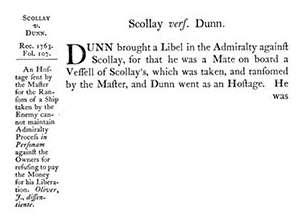
[P. 74]
3 George III (Aug.) in the Superior Court of Judicature
1 · brief description
This is one of the most extraordinary cases in Quincy’s Reports, and it is also of great importance legally. Dunn was a mate on the Peggy, a ship owned by Scollay and consigned to a London merchant, William Sitwell. It was captured by a French privateer. The French were persuaded to ransom the ship, “the captain of the Peggy drew a ransom bill on the consignee,” keeping Dunn as hostage to ensure payment. Reports, 187, S. Quincy n. 1. Scollay refused to pay. Eventually Dunn was ransomed by his friends. He brought a libel in Admiralty against Scollay, for reimbursement. Scollay in turn sought a prohibition from the Superior Court, which was granted on February 12, 1763, asserting that the Admiralty court had no proper jurisdiction, at least as to a process “against the Owners’ Persons.” Reports, 75. The issue in this case was whether the prohibition was properly granted. Held, by a split decision, “the Affair of Ransom” was not “a Contract upon the High Seas” and, therefore, outside the jurisdiction of the Admiralty. Reports, 78–79.
Following that decision, Gridley, appearing for Dunn, claimed an “appeal to the King and Council.” The Justices then closely examined the 1691 Second Charter, reviewing whether an appeal had to be a matter over £300, or whether it was discretionary, or whether the Admiralty jurisdiction was entirely excepted. The Court refused to allow the appeal to England. Reports, 81–83. See discussion at Note 6, infra. The ground was apparently that the 1691 Charter, while it provided for appeals “in cases that may deserve the same,” modified that clause by a subsequent requirement that “the matter in difference doth exceed the value of three hundred pounds of sterling.” See The Charter and General Laws of the Colony and Province of Massachusetts Bay (Boston, 1814), 32. This was despite doubts by both the Chief Justice and Justice Lynde that this case might exceed £300, as the Chief Justice observed, “As for this Case, whether it exceeds £300 or no, there is the Difficulty.” Reports, 83. In any event, no mention of an appeal has yet been found in the Privy Council records. See discussion at Note 6, infra.
There was a further note concerning this situation in August Term, 5 George 3 (1765), where it is described as “Dunn vers. Scollay” and as “Case of Hostage & Ransom.” See Reports, 187, set out in Quincy Papers, vol. 5, 478. This subsequent proceeding was really an appeal of a second case, brought by Dunn against Scollay in the Court of Common Pleas, following the prohibition against his libel in Admiralty that was upheld in this first case. See Reports, 187–188. That action was successful for Dunn, and he obtained a judgment of £700 against Scollay. Scollay appealed that judgment to the Superior Court. Quincy’s report simply sets out the authorities involved on both sides, which were very similar to those involved in this case. See Note 4, “Authority,” infra. Dunn apparently lost the appeal, and his judgment, on the issue of whether a ship’s master could “bind the owner by a contract of ransom, without special orders to that effect.” See Reports, 188, S. Quincy n.1, and the full discussion of second case, described as Case 30[b], Reports, 187–188, set out in Quincy Papers, vol. 5, 478–481, infra.
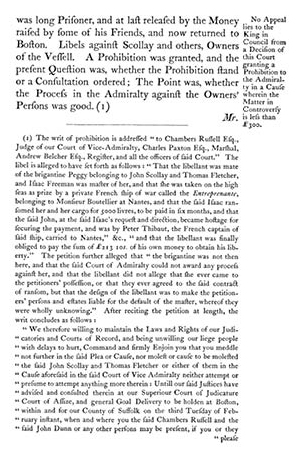
[P. 75]
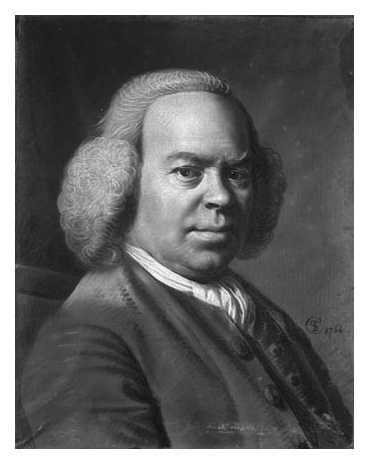
ILLUSTRATION 19: John Scollay (1711–1790), original Defendant in Scollay v. Dunn, Quincy’s Reports, p. 74 (Case 30, 1763), by John Singleton Copley (1738–1813). Dated 1764. Image courtesy of the Pennsylvania Academy of the Fine Arts. Property owned by his family would take their name and become known as Scollay Square, Boston, now Government Center. My thanks to Kevin Cox.
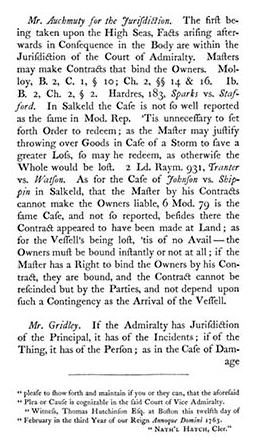
[P. 76]
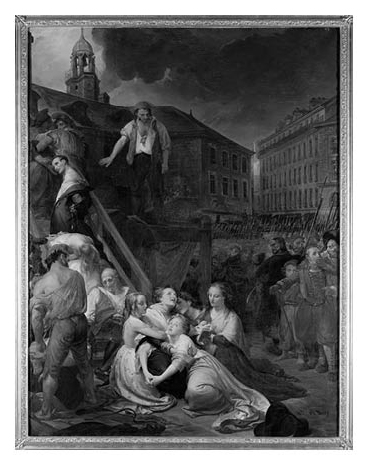
ILLUSTRATION 20: Episode in Place du Bouffay, Nantes, 1859 (oil on canvas), by Auguste Hyacinthe Debay (1804–65). The Bouffay Prison in the background was where John Dunn, original Plaintiff in Scollay v. Dunn, Quincy’s Reports, p. 74 (Case 30, 1763), was imprisoned for six years until his ransom was finally paid in 1762. My thanks to Kevin Cox. Courtesy Bridgeman Art Library.
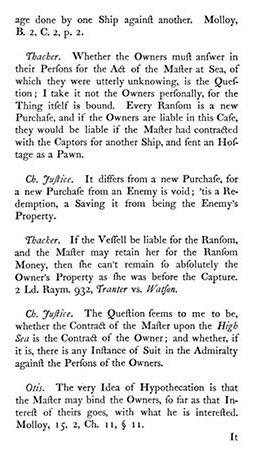
[P. 77]
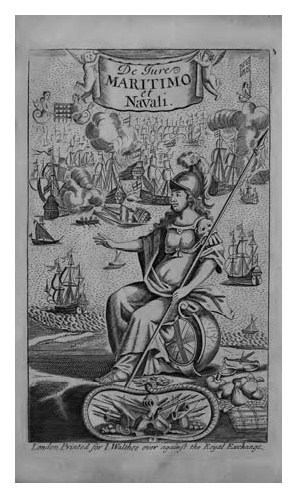
ILLUSTRATION 21: Title page, De Jure Maritimo et Navali or a Treatise of Affaires Maritime, and of Commerce (1676), by Charles Molloy (1645/6–1690). Molloy is repeatedly cited as authority in Scollay v. Dunn, Quincy’s Reports, p. 74 (Case 30, 1763). See description of Molloy’s importance in Daniel R. Coquillette, The Civilian Writers of Doctors’ Commons, London (Berlin, 1988), pp. 124–146.
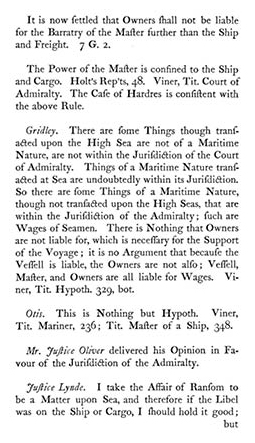
[P. 78]
2 · record
Available at Rec. 1763, fol. 107. The writ of prohibition itself is particularly important. See Reports, 75–76, n.1. The Suffolk files also contain the following:
- Scollay v. Dunn, (same) Oct. 21, 1765, Nos. 86627 and 87801.
- • See Attached Sheet.
- • No. 87801, a printed blank form of a Writ of Assistance for collection of customs, 29 Sept. 1770.
- Scollay v. Dunn: (listed as Dunn v. Scollay, Sept. 12, 1758)
- • A letter to Dunn from William Sitwell, the London merchant to whom the Peggy was consigned, dated March 3, 1758. Sitwell expresses regret that a bill was not paid, and that the confinement continued. Sitwell also says that he visited France during the previous summer. Lastly, he promises that the business with the underwriters will be taken care of.
- • A letter in different handwriting which is nearly identical to the other letter.
- • Another letter to Dunn from Sitwell dated Sept. 12, 1758. Like the other letter, this letter serves as an apology from Sitwell. Sitwell claims that he has been unable to get a discharge for Dunn, but that he was encouraged about Dunn’s release because some of the underwriters had agreed to release Dunn with a partial payment. Unfortunately, the letter continues, the remaining two underwriters absolutely refused to comply. Sitwell claims that the only way to compel these two underwriters is by law-which is uncertain because no such case has been tried before and it would take a long time. The letter further states that Sitwell attempted to get the agent of one Mr. Boutail [Mons. Boutellier, owner of the privateer?] to pay the remaining portion and that seemed promising until Mr. Boutail’s wife died, and Sitwell was unable to contact him. Thereafter, Sitwell received a settlement offer from Scollay, but for some reason could proceed no further. As a final resort, Sitwell said that he had asked for a prisoner swap in order to get Dunn out, but after three requests, the Commissioner has failed to respond. Apparently, Dunn was considered a prisoner of war. Lastly, Sitwell says that he would have continued his payments, but has ceased because of the settlement letter from Scollay. In a bit of an about face, Sitwell then becomes defensive and claims that he will not give more money because he has already given a good deal of money at his own risk. In the end, however, Sitwell reiterates that he is Dunn’s friend.
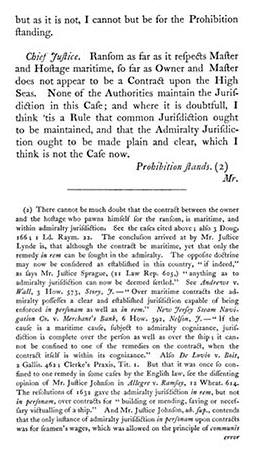
[P. 79]
3 · professionals involved
This case was argued by the leaders of the colonial Bar, with Robert Auchmuty (1723–1788) and Jeremy Gridley (1701/2–1767) arguing for the jurisdiction of the Admiralty and, when that was denied, for appeal to the Privy Council. In opposition on both issues were Oxenbridge Thacher (1719–1765) and the patriot, James Otis, Jr. (1725–1783). See brief biographies for all four in Appendix 6. Assuming that Tories would favor the Admiralty, with its lack of jury trial, and also would favor broad supervision of colonial courts through appeal to the Privy Council, Reports, 80, then the advocates were true to type. Gridley had defended the Writ of Assistance against Otis, and Robert Auchmuty actually became Judge of the Massachusetts Vice Admiralty (1767–1776) and was proscribed in 1778. Auchmuty’s father had also served as the Judge of the Vice Admiralty court, from 1733 to 1747. Otis, of course, was a famous patriot, and Thacher’s seat in the House passed to Sam Adams on Thacher’s death in 1765. See Appendix 6.
4 · authority
This case is particularly important for the use of statutory and English case law authority on both sides, although the crucial question as to the right of appeal from the Court’s decision upholding the prohibition-involving a fundamental construction of the words of the Second Charter-was done without any citation to authority. That could be because the question of appeal was a purely colonial issue, whereas the scope of the admiralty jurisdiction had attracted much attention in England. In any event, the next page of the manuscript after the case report lists the authorities for either side, including several not included in Quincy’s account of the arguments themselves. See Reports, 83, S. Quincy n. 7.
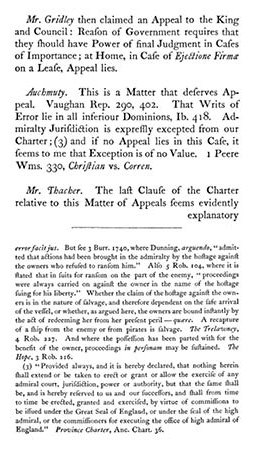
[P. 80]
Among the authorities cited by the distinguished professional team attacking the prohibition, Gridley and Auchmuty, were some very familiar sources, such as Lord Raymond’s Reports, Modern Reports and the appropriate sub-headings of Viner’s Abridgment, such as “Hypothecation.” These sources also frequently appear in Quincy’s Law Commonplace. See Law Commonplace, [35], n. 2, [96], n. 4 (Modern Reports); p.[32], n. 7 (Salkeld’s Reports); [26], n. 2 (Lord Raymond’s Reports) and [16], n. 2 (Viner’s Abridgment). Other sources cited were more unusual, with heavy reliance on Charles Molloy’s De Jure Maritimo et Navali: Or a Treatise of Affaires Maritime and of Commerce, first published in London in 1676, and frequently republished, with the “new” edition of 1744 mentioned in Quincy’s “authority” note. Reports, 83, S. Quincy n.7. See Sweet & Maxwell, vol. 1, 511:64. See also the full discussion of Molloy’s importance as a “bridge” between common lawyers and the civilian law of the sea and commerce in Daniel R. Coquillette, The Civilian Writers of Doctors’ Commons, London (Berlin, 1988), 140–146. According to Quincy’s “authority” note, Gridley and Auchmuty also referred to “Sea Laws, 128.” This is probably William Welwood’s famous Abridgment of all Sea-Laws, first published in 1613 and republished in 1636, although the page reference seems uncertain. See Sweet & Maxwell, vol. 1, 516:100 and Coquillette, The Civilian Writers, supra, at 128. At the very least, these sources demonstrated the strength of Gridley’s famous library and the breadth of learning of the advocates.
Their opponents, Thacher and Otis, were more prosaic. Essentially, they tried distinguishing cases such as Tranter v. Watson (1703), 2 Ld. Raymond’s Reports, 932, cited by their opponents, as being about security in the ship, rather than a personal action against the owner. (Security in a vessel, usually secured by a lien on the vessel in Admiralty, was known as “hypothecation.” See Jowitt, supra, 932.) They also cited Molloy, supra, and Viner’s Abridgment, “Tit. Mariner, 236; Tit. Master of the Ship, 348” to show that “this is Nothing but Hypoth. [hypothecation],” i.e., security in the vessels only, and further cited the statute 7 George 2 (1733) for it being “now settled that Owners shall not be liable for the Barratry [i.e., a wilfull, unauthorized act] of the Master further than Ship and Freight.” Reports, 78. See Jowitt, supra, 215.
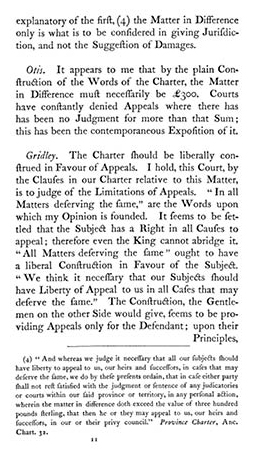
[P. 81]
As to the issue of appeal, Auchmuty cited to Vaughan’s Reports 290, Craw v. Ramsey (1670), beginning on 274, 402 (Process out of Courts at Westminster into Wales, beginning on page 395), another commonly cited report in the colony (see Law Commonplace, [50], n. 2), and to Christian v. Corren in 1 Peere William’s Report 330, a rather unusual report of cases in Chancery, and [special cases] in the King’s Bench, between 1695–1735, published in London in installments between 1740–1749. See Sweet & Maxwell, vol. 1, 347–348:33. Their adversaries cited no authority except, in Otis’s words, “the plain Construction of the Words of the Charter. . . .” Reports, 81.
5 · later citations
This case has never been cited by the Supreme Judicial Court for the principal holding, and for good reason. As Samuel Quincy observed, in light of later cases, “[t]here cannot be much doubt that the contract between the owner and the hostage who pawns himself for ransom, is maritime, and within admiralty jurisdiction.” Reports, 79, S. Quincy n. 2. Further, later American cases made it clear that the hostage could proceed in personam against the owner as well as in rem against the boat. New Jersey Steam Navigation Co. v. Merchant’s Bank, 47 U. S. 394, 6 How. 392 (1848) (Nelson J.). Reports, 79, S. Quincy n.2. (Although earlier English cases may have supported the decision in Scollay v. Dunn, see Reports, 79–80, S. Quincy n. 2.)
This case has been cited for the proposition that a writ of prohibition may issue against the state, see Connecticut River R. Co. v. Franklin County Commissioners, 127 Mass. 50, 58 (1879), and as to the colonial record of issuing writs of prohibition to admiralty courts in Massachusetts. See The Underwriter, 119 F. 713, D.C. Mass. (1702).
6 · note
This is a highly important case for four reasons. First, it sheds vivid light on the practices and risks of Massachusetts commerce. See Introduction, supra, 52–57. John Scollay’s brigantine, the Peggy, was on consignment to a London merchant in Atlantic trading operations. See Quincy, 187, S. Quincy n.1. It was captured at sea on October 26, 1756, by a French privateer, the Entreprenante. The captain, Isaac Freeman, persuaded the French to take a ransom note, secured by a hostage, the Mate and Plaintiff in this case, Dunn. Neither Scollay nor the London merchant, William Sitwell, paid the note, and Dunn languished in prison at Nantes until rescued by his own family and friends. See Introduction, “First Flower,” Section IV B, 52–57, supra. Ransom notes of this kind were fairly common in the latter half of the eighteenth century, but this was a very graphic example. Of course, Dunn, on his return, promptly sued Scollay.
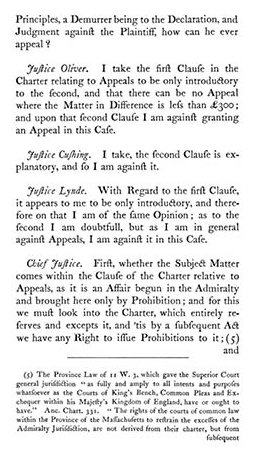
[P. 82]
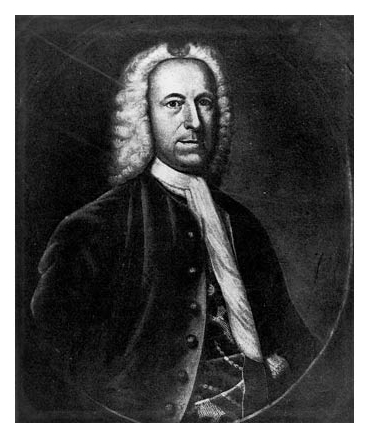
ILLUSTRATION 22: Chief Justice Benjamin Lynde Jr. (1711–1780), Justice, Superior Court of Judicature, 1745–1769, Chief Justice, 1769–1771, attributed to John Smibert (1688–1751) or possibly to his son, Nathaniel. Dated about 1738. See Henry Wilder Foote, John Smibert, Painter: With a Descriptive Catalogue of Portraits (Cambridge, Mass., 1950), pp. 73, 219–220, 263–264. Lynde’s father, Benjamin Lynde Sr. (1666–1745) was also a Justice of the Superior Court of Judicature, 1712–1729, and Chief Justice, 1729–1745. Lynde presided at the Boston Massacre trial, and would have heard John Adams and Josiah Quincy argue for the Defendants. See Editor’s Foreword to Volume 4, supra. In 1774, he was one of the signers of the Salem address to Gen. Thomas Gage. See id., p. 219. See also Sally E. Hadden, “Benjamin Lynde, Jr., Servant of the Commonwealth,” 9 Massachusetts Legal History (2003), p. 1. Lynde voted to grant the writ of prohibition in Scollay v. Dunn, Quincy’s Reports, pp. 74, 82 (Case 30, 1763). Image courtesy of the Library of Congress. Special thanks to Kevin Cox and Charles Riordan.
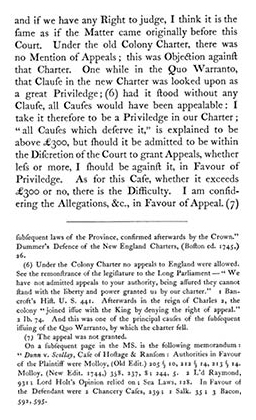
[P. 83]
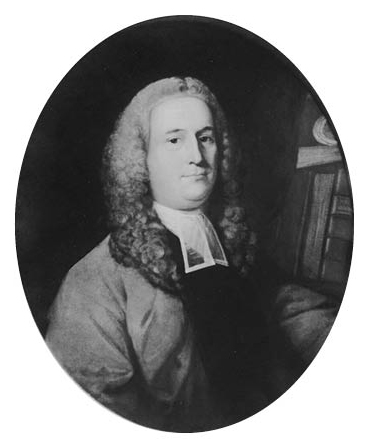
ILLUSTRATION 23: Chambers Russell (1713–1766), who served both as a judge for the Vice Admiralty Court and as a Justice of the Superior Court of Judicature (1752–1760), arguably by Joseph Blackburn (circa 1700–1780), although also attributed to Gilbert Stuart (1755–1828) and others. See Sibley’s Harvard Graduates, vol. IX (1731–1735), p. 83. Russell recused himself from Scollay v. Dunn, Quincy’s Reports, p. 74 (Case 30, 1763), to avoid voting on whether the Superior Court of Judicature should prohibit him from hearing Dunn’s suit in the Court of Vice Admiralty. See Kevin W. Cox, “Scollay v. Dunn: The Conflict and Confluence of Colonial Admiralty and Common Law Jurisdiction in 1760’s Boston” (2007), unpublished paper on file with editor, p. 13. Many thanks to Kevin Cox. Image courtesy of The Frick Collection.
The second important issue in this case concerned the jurisdiction of colonial courts. Initially, Dunn’s lawyers chose to file libels against Scollay and other owners of the Peggy in the Court of Vice Admiralty, certainly on the theory that this was a contract entered into on the high seas. The relationship between the jurisdiction of common law courts and admiralty courts was a major point of contention on both sides of the Atlantic. See F. L. Wiswall, The Development of Admiralty Jurisdiction and Practice Since 1800 (Cambridge, 1970), 1–39; E. S. Roscoe, Studies in the History of Admiralty and Prize Courts (2nd ed., London, 1932). The standard means used by courts to control admiralty jurisdiction was the powerful prerogative Writ of Prohibition, see Daniel R. Coquillette, Anglo-American Legal Heritage, supra, 246–247. By a split Court, with Justice Oliver in dissent, such a writ was issued here, preventing Dunn from further proceedings in Admiralty.
The decision was thus an important one, both in light of admiralty jurisdiction’s contested past and for its future, as the first federal courts of the new American republic would have admiralty jurisdictions. See Henry J. Bourguignon, The First Federal Court (Philadelphia, 1977), 3–78. Scope of admiralty jurisdiction became an important issue as such courts sought to expand their power. See Daniel R. Coquillette, “‘Mourning Venice and Genoa’: Joseph Story, Legal Education, and the Lex Mercatoria,” From Lex Mercatoria to Commercial Law (V. Piergiovanni, ed., Berlin, 2005), 11–51. The decision was also important in determining the possible effect of political ideology on the justices, as the Vice-Admiralty Court was free of pesky colonial juries, and was often favored by the English in controversial cases. See, for a powerful example, John Adams’s defense in Rex v. Corbet, supra, vol. 11, 275–276, described in D. R. Coquillette “Justinian In Braintree: John Adams, Civilian Learning, and Legal Elitism, 1758–1775,” Law in Colonial Massachusetts (eds. Coquillette, Brink, Menand), 392–394.
One of the Superior Court judges, Chambers Russell, did not participate in the decision, most certainly because he was also the Vice-Admiralty Judge and would have been considering a prohibition against his own jurisdiction-a most awkward position. Oliver, a staunch Tory, predictably voted for an expanded view of the Vice-Admiralty jurisdiction, but Lynde and the Chief Justice did not. Lynde refused to find admiralty jurisdiction beyond a libel “on the Ship or Cargo,” even though he found “the Affair of Ransom to be a Matter upon Sea.” Reports, 78. Here, of course, Dunn was trying to sue Scollay personally, rather than proceeding against the ship, which may have been very difficult to locate and attach.
Chief Justice Hutchinson voted with Lynde, although he disagreed with Lynde’s rationale, finding that “Ransom as far as it respects Master and Hostage maritime, so far as Owner and Master does not appear to be a Contract upon the High Seas.” Reports, 79. The Chief Justice relied on the absence of authority directly in point, “[n]one of the Authorities maintain the Jurisdiction in this Case . . .” and on a general rule that “common [law] Jurisdiction ought to be maintained” unless “the Admiral Jurisdiction ought to be made plain and clear, which I think is not the case now.” Reports, 79. As Samuel Quincy demonstrated, later American courts, led by Joseph Story, rejected the rationale of both Lynde and Hutchinson, and consistently found for a broader admiralty jurisdiction. See Reports, 79, S. Quincy n. 2. Bolstered by Story’s sweeping view of admiralty jurisdiction, Justice Nelson wrote in 1848 that “[o]ver maritime contracts the admiralty possesses a clear and established jurisdiction capable of being enforced in personam as well as in rem.” New Jersey Steam Navigation Co. v. Merchant’s Bank, 47 U. S. 394, 6 Howard 392 (1848), cited at Reports, 79, S. Quincy n. 2. Thus, the colonial judges’ earlier loyalty to the common law jurisdiction was remarkable!
The Chief Justice’s reference to the “authorities” brings in a third point of significance for this remarkable case-the use of sophisticated English authority. As discussed in Note 4, “Authority,” supra, both sides made use of extensive English sources, including unusual treaties such as Charles Molloy’s De Jure Maritimo et Navali [1676] and William Welwood’s Abridgment of all Sea-Laws (1613). Molloy, in particular, was a “bridge” between Roman and Civil law continental sources and the Common law of England. See Daniel R. Coquillette, Civilian Writers of Doctors’ Commons, London, supra, at 140–146. These citations demonstrated the depth of the colonial law libraries and some sophistication about civilian law, a trend also reflected, more strongly, by John Adams’s law practice. See D. R. Coquillette, “Justinian in Braintree: John Adams, Civilian Learning, and Legal Elitism, 1758–1775,” Law in Colonial Massachusetts (eds. Coquillette, Brink, Menand), 382–418. That some of these authorities were used in a rather loose manner, as Chief Justice Hutchinson implied in his ruling, should not detract from the scholarly level of the argument, which would have been respectable in London. See Note 4 “Authority,” supra. It was also remarkable that, in such an important case, there was no reference to colonial law at all with regard to the substance of the dispute. Quincy doubtless found this to be an incentive to create colonial law reports.
Finally, there was the important legal issue of the appeal to the Privy Council, the “King and Council” in London. Here the Court was required to make colonial law, as the issue had to be determined by reference to Section 4 of the Second Charter. The wording of the Charter was badly drafted, and left it open to debate whether the words “cases that may deserve the same” [i.e., “liberty to appeal to us”] were limited by the subsequent provision allowing appeals “in any personal action, wherein the matter in difference doth exceed the value of three hundred pound sterling.” See Reports, 81, n. 4 and The Charter and General Laws of the Colony and Province of Massachusetts Bay (Boston, 1814), 32. One could certainly argue that the first clause gave the Court discretion to grant appeals to deserving cases, whereas the second clause required that appeals be granted in cases with contested amounts over £300. Justice Oliver, however, read the first clause to “be only introductory to the second” and, therefore, that “there can be no Appeal where the Matter in Difference is Less than £300.” In this case “upon that second Clause,” Oliver was “against granting an Appeal,” because he was of the view that less than £300 was involved. Reports, 82. Justice Cushing agreed that the “second Clause is explanatory,” and that the amount was under £300. Reports, 82.
Justice Lynde agreed that the amount had to exceed £300, but “as to the second I am doubtful” [i.e., he was not sure that the £300 amount had not been exceeded by this case.] “[B]ut,” he continued, “as I am in general against Appeals, I am against it in this Case.” Reports, 82.
Chief Justice Hutchinson was also unsure whether the case was worth more than £300. “As for this case, whether it exceeds £300 or no, there is the Difficulty.” Reports, 83. He was also concerned that “it is an Affair begun in the Admiralty and brought here only by Prohibition,” because the 1691 Charter originally excepted admiralty from all its provisions, including the appeals clause. See The Charters and General Laws of the Colony and Province of Massachusetts Bay (Boston, 1814), supra, 36. The ability to issue prohibition to the Admiralty was based on a subsequent statute, Province Law, 11 William 3 (1699). Finally, the Chief Justice was concerned whether the Court had discretion under the “all Causes which deserve it” language, to deny appeals exceeding £300. While the language of the Report is unclear, the Chief Justice apparently opposed such discretion, in favor of an appeal exceeding £300 being a privilege under the Charter. “I take it therefore to be a Priviledge in our Charter; ‘all Causes which deserve it,’ is explained to be above £300, but should it be admitted to be within the Discretion of the Court to grant Appeals, whether less or more, I should be against it, in Favour of Priviledge.” Reports, 83.
In all events, the appeal was denied. All the justices, except the Chief Justice, expressed clear opposition. As Justice Lynde put it, “I am in general against Appeals.” Given the importance of the case and the difficulty of the legal issues involved, the resistance of the Court to appeals to London was striking.
In addition, the Chief Justice was quite right to wonder if the case did not exceed £300 after all. When Dunn brought his action later in the Common Pleas, he was awarded a judgment of £700. See Scollay v. Dunn (1766), Reports, 187, Case 30 [b], S. Quincy n. 1. In any event, no evidence of an appeal has yet been found in the Privy Council records, and the case was mentioned by Joseph Smith as an example of limitations on such appeals. See Joseph H. Smith, Appeals to the Privy Council from the American Plantations (New York, 1956), 166. My thanks to my distinguished colleague, Sharon H. O’Connor. See the discussion at Banister v. Henderson (1765), Reports, 119, Case 42, Note 6, infra.
There is an excellent paper, “Scollay v. Dunn: the Conflict and Confluence of Colonial Admiralty and Common Law Jurisdiction in 1760s Boston,” on file with the Editor. It was prepared by my brilliant research assistant, Kevin W. Cox, Harvard Law School Class of 2005, who also was invaluable in assisting with these annotations.
All in all, Scollay v. Dunn was a great colonial case, involving compelling human and economic factors, difficult issues of jurisdiction, sophisticated authorities, and a major decision about right to appeal to under the Charter. Even in London, it would have been a “major league” case.
CASE 31
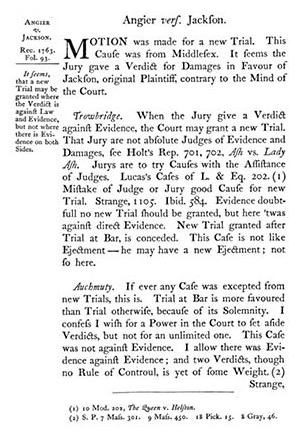
[P. 84]
George III (Aug.) in the Superior Court of Judicature
1 · brief description
This an important case on the power of juries. A Middlesex jury gave a verdict for damages in favor of the Plaintiff Jackson, contrary “to the Mind of the Court.” Angier, the Defendant, now moves for a new trial. Held, motion denied, because there was “Evidence on both sides” and the Court below was “not clear” that the verdict was “against Law and Evidence.” Reports, 85.
2 · record
Available at Rec. 1763, fol. 93.
3 · professionals involved
Edmund Trowbridge (1709–1793) argued for the new trial. He was later to become a Justice of the Superior Court (1767–1775). Arguing for the power of the jury was Robert Auchmuty (1723–1788), who became Judge of the Massachusetts Vice Admiralty Court (1767–1776), where-ironically-jury trial was not allowed. Auchmuty was also proscribed as a loyalist in 1778. This is another example where lawyers certainly argued legal positions that were not “knee-jerk” assertions to their politics-here a Tory who was already Advocate General in Admiralty (1762–1767) was arguing for the inherent power of a common law jury. See brief biographies in Appendix 6.
4 · authority
Trowbridge relied on a series of English cases, including the famous Ash v. Lady Ash, Holt’s Reports 701, 702 (K.B. 1688–1710), together with Strange’s Reports (covering 1716–1749), 584 (the 1724 case of Musgrave v. Nevinson), 1105 (the 1739 case of Smith v. Parkhurst, vol. 2), and Lucas’s Cases in Law and Equity, which was part 10 of the Modern Reports [1709–1725], first published in 1736. The case from Lucas’s Reports is Regina v. Corporation of Helston in Cornwall (1714), 202. Quincy’s Law Commonplace has extensive notations to Strange’s and Modern Reports. Significantly, the Law Commonplace directly cross-references to Angier v. Jackson in a section on new trials, demonstrating the interconnectedness of the Reports and the Law Commonplace in Quincy’s legal training. See Law Commonplace, [90], n. 4. The authorities stand for new trial only where the jury verdict was against direct evidence.
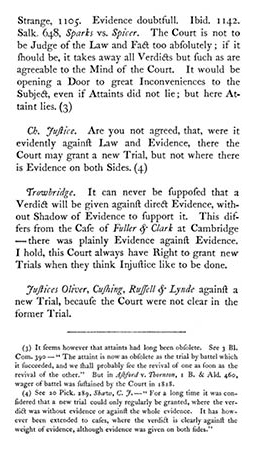
[P. 85]
Auchmuty argued that “[t]his case was not against Evidence,” although there was “Evidence against Evidence.” Reports, 84. He also evoked another case in Strange’s Reports where the jury verdict was permitted to stand though the “[e]vidence [was] doubtful.” See Ashley v. Ashley (1740), Strange’s Reports, supra, 1142. He also cited to Sparker v. Spices in Salkeld’s Reports (1689–1712), first published in 1717; for the proposition that the Court should defer to a jury if the evidence is arguable.
The use of English reports on either side to decide the inherent power of a colonial jury certainly must have encouraged Quincy’s ambitions to publish a colonial law report. Even more interesting was Trowbridge’s citation to “the Case of Fuller & Clark at Cambridge,” where the jury verdict had been upheld, but where there was “plainly Evidence against Evidence.” Reports, 85. That case was never reported.
5 · later citations
As Samuel Quincy noted, later Massachusetts law permitted a new trial where “the verdict is clearly against the weight of evidence, although evidence was given on both sides.” Miller v. Baker (1838), 37 Mass. Reports 285, 20 Pickering 285, 289 Mass. (Shaw, C. J.). See Reports, 85, S. Quincy n. 4.
More recently, however, the extent to which eighteenth-century common law jury verdicts could be set aside by reviewing judges has taken on much significance. This is because the so-called “Re-Examination” Clause of the Seventh Amendment of the U.S. Constitution provides that “no fact tried by a jury, shall be otherwise re-examined in any court of the United States, than according to the rules of the common law.” U.S. Const. Amendment VII. The meaning of this important clause requires knowledge of what the “rules of common law” were at the time the Seventh Amendment was adopted in 1791. Cases like Angier v. Jackson are important evidence of what these rules were, occurring only 28 years before. For a full review of this importance in the context of two major, and recent, Supreme Court cases, see Honda Motor Co. Ltd et al. v. Oberg, 512 U. S. 415, 424 (1994), “Brief of Legal Historians Coquillette, Hager, Mann and McEvoy as Amici Curiae in Support of Respondent,” No. 93–6444, March 31, 1994; Gasperini v. Center for Humanities, 518 U. S. 415, 432–3 (1996), “Brief of Federal Jurisdiction and Legal History Scholars Amar, Chemerinsky, Coquillette, McEvoy and Miller and of Trial Lawyers for Public Justice as Amici Curiae in Support of Petitioner,” No. 95–719, March 1, 1996.
6 · note
Even as an advocate for jury power, Auchmuty did not argue for an unlimited power. He stated that “I confess I wish for a Power in the Court to set aside Verdicts, but not for an unlimited one.” Reports, 84. The Court unanimously agreed, refusing to set aside a verdict “where there is Evidence on both Sides.” Id., 85. In the Chief Justice’s words, a common law jury verdict should stand unless it were “evidently against Law and Evidence.” Id., 85. [Italics added.] It should be noted that he used “and,” not “or,” above, as the key issue was whether there was at least some evidence to support the verdict. This standard remains of great importance in American constitutional cases arising under the Seventh Amendment Re-examination Clause. See Note 5, “Later Citations,” supra.
CASE 32
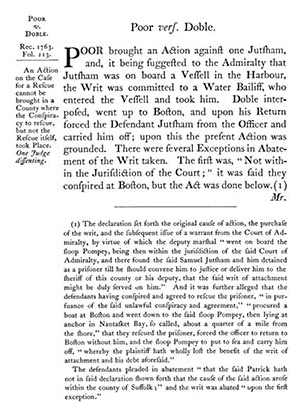
[P. 86]
3 George III (Aug.) in the Superior Court of Judicature
1 · brief description
Poor had a writ of debt against one Jutsham, who was on board the sloop Pompey lying off Nantasket Bay. A warrant was obtained from the Court of Admiralty to arrest Jutsham on the sloop, and a water bailiff duly tried to arrest him aboard the sloop. Allegedly, the Defendant Doble, with others, got a boat in Boston, went out to the Pompey, and forced the water bailiff to return without his prisoner. The Pompey then put to sea with Jutsham, a good escape from the creditor, Poor.
The creditor Poor now sues Doble in tort in Suffolk County (i.e., Boston) for procuring the escape, claiming that he, Poor, was a victim of a conspiracy that arose in Boston. Held, 3 to 1 with the Chief Justice dissenting, that the cause of action arose from the rescue, not the conspiracy, and the rescue was outside the jurisdiction of a court in Suffolk County.
2 · record
Available at Rec. 1763, fol. 113. The declaration is of particular intent. See Reports, 86, S. Quincy n. 1.
3 · professionals involved
Quincy’s pupil master, Oxenbridge Thacher (1719–1765), argued for the writ being good. His mentor and John Adams’s pupil master, Jeremy Gridley (1701/2–1767), the informal dean of the bar, argued for the other side, and won. See brief biographies in Appendix 6.
The split Court was given as “3 vs. 1.” The dissenter appears to be the Chief Justice. See the discussion at Note 6, infra. Given that the potential jurisdiction of the Vice Admiralty Court was also questioned, it is possible that Chamber Russell recused himself, because he served concurrently as the judge of the Vice Admiralty Court. For a similar conflict, see Scollay v. Dunn, Reports, 74, Case 30, supra.
4 · authority
None cited.
5 · later citations
Samuel Quincy questioned whether this case was correctly decided, citing both contemporary and later authority that “an action on the case against rescuers” is not “local at common law” but “transitory.” See Reports, 87, S. Quincy n. 2. As Samuel Quincy further noted, Bacon’s Abridgement, a favorite of the contemporary Massachusetts bar and first published in London in 1736, made the same argument under “Escape, F.” The corollary assertion, that imprisonment on shore pursuant to high seas orders was not within the Admiralty jurisdiction, is quite distinguishable. See Adams v. Haffard, 37 Mass. 127, 20 Pickering 127 (1838). The Admiralty jurisdiction was strictly limited to high seas matters, whereas the common law had concurrent jurisdiction with the Admiralty of torts upon the high seas, as Samuel Quincy observed. Samuel Quincy also offers the example from a later case of a ship ‘in Nantasket Bay a quarter of a mile from shore’ “that was not judged infra corpus comitatus [i.e., “within the body of the county,” as opposed to the high seas].” See Commonwealth v. Henry Peters, 53 Mass. 387, 12 Met. 387 (1847). Even in this situation, Samuel Quincy argued, concurrent tort jurisdiction would lie. See Reports, 87, S. Quincy n. 2.
6 · note
As a matter of law, the Chief Justice was right when he asked “If Conspiracy be in one County and Rescous (Rescue) in another, could the Courts in both have Jurisdiction?” Reports, 87. Indeed, why not? In this case, the rescue was certainly within the Court’s concurrent tort jurisdiction with Admiralty. So why three votes to abate Poor’s writ?
Readers of today’s Patrick O’Brian novels about seamen of Quincy’s time get a sense of the public sympathy for certain debtors. There was clearly a story behind this Declaration and the rescue itself. The majority of the Court was probably happy to duck this case, relying on Gridley’s artful argument that, “’tis the Rescue, and not Conspiracy, which is the Cause of Action.” Reports, 87. Better use of contemporary authority by Thacher, such as arguing from the favorable provisions of that reliable “stand by,” Bacon’s Abridgement, supra, might have changed the Court’s mind.
CASE 33
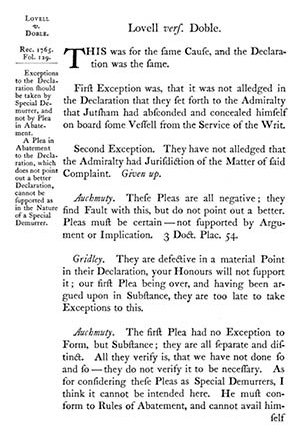
[P. 88]
3 George III (Aug.) in the Superior Court of Judicature
1 · brief description
This is the same case as the last, Poor v. Doble, Case 32, with the same Declaration as set out at Reports, 86, S. Quincy n. 1. It is a pleading squabble about whether an action for causing an escape of a debtor from an arrest by the water bailiff off Nantasket could be heard in Suffolk County. The case for jurisdiction apparently was that the escape was within the traditional Admiralty jurisdiction, and thus could be heard in Suffolk. Here, the lawyers for the Defendant, seeking to evade the jurisdiction, raise two more pleading exceptions, i.e., 1) that the Plaintiff’s Declaration did not set forth that the escaped debtor “concealed himself on board the Vessel” and 2) did not allege that “the Admiralty had Jurisdiction.” Reports, 89–90. A “Declaration” was a statement of claim, the first pleading delivered by a Plaintiff. It included the cause of action, the purchase of the writ and in this case, the Admiralty warrant to the Deputy Marshall. See Reports, 89, S. Quincy n. 1. Both of these exceptions were rejected by the Court, which nevertheless found no jurisdiction for the rather weak reasons stated in Reports, 86, Case 32, supra.
2 · record
Available at Rec. 1765, Fol. 125.
3 · professionals involved
As in Case 32, Jeremy Gridley (1701/2–1767) was in opposition to the writ and Declaration. Now he is joined by Samuel Fitch (1724–1799), who will become Advocate General of the Admiralty (1768–1776).
Oxenbridge Thacher (1718–1765), who argued for the validity of the writ in Case 32, has been replaced by Robert Auchmuty (1723–1788), who will become Advocate General of the Admiralty (1762–1767) and then Judge of the Massachusetts Vice Admiralty Court (1767–1776). He is joined by the great patriot James Otis, Jr. (1725–1783), who served as Advocate General of the Admiralty from 1756 to 1760. The two opponents with the special admiralty experience, Fitch and Auchmuty, will both be proscribed in 1778. See the brief biographies in Appendix 6.
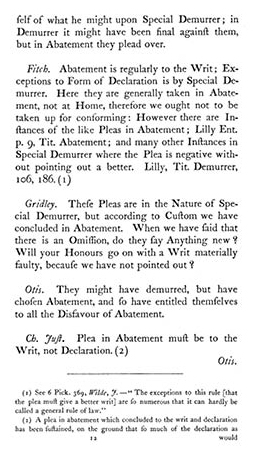
[P. 89]
Why were the two advocacy teams “beefed up” by lawyers with a special admiralty interest? If the purpose was to improve the initial attack on the writ and Declaration, it was of little value. The two new exceptions were weak, and quickly rejected.
4 · authority
This is a pleading struggle. In arguing that attacks on the writ must “point out a better,” Auchmuty relied on the old text Doctrina Placitandi; or the art and science of pleading (vol. 3, 54), written by “S.E.” (Sampson Ever) and published in London in 1677. See Sweet & Maxwell, supra, vol. 1, 268:58. Fitch countered with “many other Instances in Special Demurrer where the Plea is negative without pointing out a better,” pointing to Lilly’s Collection of Modern Entries, 9, title “Abatement,” and to pages 106 and 186, title “Demurrer,” of Lilly’s Entries, which reported “Select Pleading” in the common law courts and was published in Latin in 1723 and 1741, and then in English in 1741 and 1758. See Sweet & Maxwell, supra, vol. 1, 273:97. Quincy used Lilly’s Entries in his Law Commonplace, 38, n.5, and he owned a copy at his death. See his Estate Catalogue, no. 24, set out in Appendix 8.
5 · later citations
This case was never cited by the Supreme Judicial Court. The one statement of law set out, the Chief Justice’s view that a “Pleas in Abatement must be to Writ, not Declaration,” was rejected by Ilsley v. Stubbs, 5 Mass. 280, 285 (1809), as Samuel Quincy points out. Reports, 89–90, S. Quincy n. 2. Later Massachusetts pleadings permitted a plea is abatement to both together, on the sensible ground that “so much of the declaration as would be necessary to make a perfect writ, is a part of the writ. . . .” Id., 89–90, n. 2. Ilsley v. Stubbs, supra, at 585.
6 · note
The most interesting argument, in this technical squabble, was Fitch’s answer to Auchmuty’s argument that the opposition to the Declaration should have been by special Demurrer, rather than pleas in abatement, because only the former are appropriate to attack a Declaration, rather than the writ. Fitch, Auchmuty, and Otis further argued that pleas in abatement must point out a better writ, and that having “chosen Abatement” the opposition “have entitled themselves to all the Disfavour of Abatement.” Reports, 89. Fitch pointed out that “Here” exception to the Declaration “are generally taken in Abatement,” not “at Home” (i.e., England). Thus, “we ought not to be taken up for conforming.” Reports, 89. Chief Justice Hutchinson rejects this “colonial practice” argument out of hand, “Plea in Abatement must be to the Writ, not Declaration.” Reports, 89.
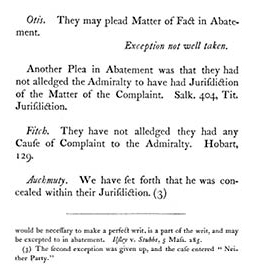
[P. 90]
Technical pleading arguments, now abolished by “notice pleading” systems such as the Federal Rules of Civil Procedure of 1934, were a mystery to lay people and an arcane specialty of the common law bar. The Superior Court, as in Reports, 86, Case 32, frequently reached results with little regard for technicalities, but the Chief Justice was not going to permit local pleading errors to become official practice “Here,” i.e., in the Commonwealth, as opposed to “Home,” i.e., England. In any event, both pleading exceptions were rejected, although the creditor still lost, for the reason given in Reports, 86, Case 32.
CASE 34
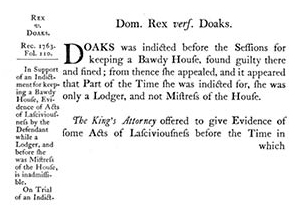
[P. 90]
3 George III (Aug.) in the Superior Court of Judicature
1 · brief description
Doaks was indicted for keeping a Bawdy House and was convicted. She appealed because “for part of the Time she was Indicted for, she was only a Lodger, and not Mistress of the House.” The Court agreed that there was a defect in the indictment, and that additional evidence of Doaks’s “lasciviousness” before when she was proved “Mistress of the House” was not admissible to remedy the defect. Nor was proof of “general ill Character” admissible, as the Defense had not put her character in issue. Reports, 91.
2 · record
Available at Rec. 1763, fol. 110.
3 · professionals involved
The King’s attorney, John Worthington (1719–1800), was the prosecutor. See brief biography in Appendix 6. There may have been no one for the defense, but the arguments are sophisticated.
4 · authority
None cited.
5 · later citations
As Samuel Quincy noted, this case was good later Massachusetts law. Character evidence cannot be introduced by a prosecutor unless “the defendant has voluntarily put his character in issue.” Commonwealth v. Hardy, 2 Mass. 318 (1807) (Parsons, C. J.). Rex v. Doaks was cited with approval in Commonwealth v. Kozlowsky, 238 Mass. 379 (1921), where the question was raised whether the Attorney General, or his assistant, may be present in his official capacity during grand jury deliberations. Proof of the Attorney General’s chief role as prosecuting officer during the provincial period was shown by the King’s Attorney’s appearance in court in this case, and the court cited Rex v. Doaks, Reports, 90. See also, Dom. Rex v. Mangent (1765), Reports, 162, (Case 44), where the Attorney General appeared. The case was also cited by the Supreme Court of the United States in Marshall v. Lonberger, 459 U.S. 422, 448 (1983) by Justice Stevens, in dissent, as an example of how the common law deemed it unfair to consider past crimes when determining the probability of whether a person committed a similar crime later. See Appendix 5, infra.
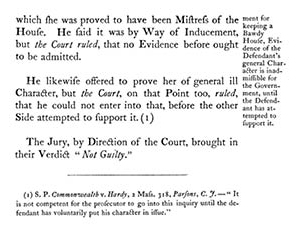
[P. 91]
6 · note
This case is of obvious sociological interest, and provides an insight into efforts to control colonial prostitution. More important is the Court’s careful concern for the law of evidence, even in a case such as this, and for specificity in indictments. It was no good for the King’s Attorney to try to remedy a defective indictment by later offering to introduce evidence of bad character or lewd behavior. Reports, 90–91.
CASE 35
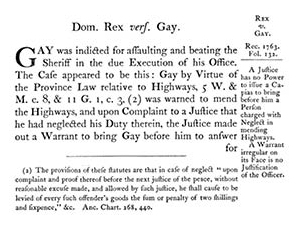
[P. 91]
3 George III (Aug.) in the Superior Court of Judicature
1 · brief description
The Defendant, Gay, concededly assaulted the Sheriff when the latter tried to arrest Gay for failing to “mend the Highways,” as required by the Province Laws. The arrest was pursuant to a defective warrant issued by a Justice. The sole issue was whether that warrant, which was illegal on its face, could be given in evidence of the Sheriff’s right to arrest Gay. In a 3-to-2 split decision, the Court held that an illegal warrant could not be admitted. Gay was, therefore, acquitted, because the Sheriff had “made the first assault.” Reports, 92.
2 · record
Available at Rec. 1763. Fol. 132.
3 · professionals involved
James Otis, Jr. (1725–1783), the patriot, appeared for the Defendant, Gay. Oxenbridge Thacher (1719–1765), Quincy’s pupil master, appeared for the Sheriff. Comparing Thacher with Otis, John Adams observed, “Thacher has not the same strength and elasticity; he is sensible but slow of conception and communication; he is queer and affected. . . .” See “Thacher,” Appendix 6.
There was no indication which of the three Justices were against admitting the warrant, and which were “doubtful.” Closely split decisions were rare, and those with no reasons noted, even more scarce. See Appendix 1.
4 · authority
Otis invoked William Hawkins’s multi-volume Pleas of the Crown. Published in London in 1716–21, 1724–26, 1739 and 1762, this treatise was one of the most commonly invoked authorities in England and the colonies on criminal law. See Sweet & Maxwell, vol. 1, 362–363:37. Quincy referred to it in the Law Commonplace, see [35], n. 5. He also owned a copy at his death. Catalogue of Estate, n. 23, Appendix 8. The correct citation is to vol. 2, 81 of the first edition (1721), and Samuel Quincy, note 4 is erroneous. The section discussed unauthorized arrest by officers, but does not directly support Otis’s position.
Samuel Quincy noted that Thacher “says that in a Case at Barnstable” the Chief Justice held “an irregular Warrant might be admitted in Justification,” and that the Court was wrong in this case. The case was Bassett v. Mayhew, May Term, 1763. See Reports, 93, S. Quincy n. 6. It is unclear if Thacher cited the case to the Court in the later Gay case. If so, the majority paid no attention.
5 · later citations
None. Later Massachusetts cases held that an illegal warrant is justification “only when regular on its face and apparently within the jurisdiction of the court or magistrate issuing it.” Fisher v. McGirr, 67 Mass. (1 Gray) 1, 45 (1854); Clark v. May, 68 Mass. (2 Gray) 410, 413 (1854). See Reports, 92–93, S. Quincy n. 5.
6 · note
The Superior Court was very careful about the right of defendants who resisted irregular arrests. See also Poor v. Doble (1763), Reports, 86, Case 32. Beating police who come with illegal warrants is not recommended today. See, e.g., Commonwealth v. Gomes, 59 Mass. App. Ct. 332 (2003) (absent the use of unnecessary force by police on his person, an individual may not forcibly resist even an unlawful entry into his residence by one who he knows or has good reason to believe is a police officer engaged in the performance of his duties); see also Commonwealth v. Moreira, 388 Mass. 596 (1983).
CASE 36
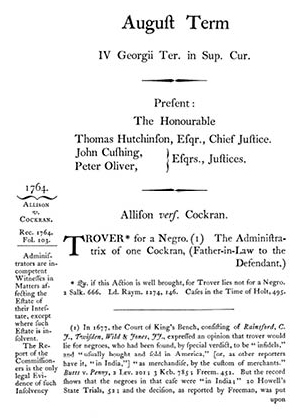
[P. 94]
ILLUSTRATION 26: Manuscript page of first page of Allison v. Cockran, Quincy’s Reports, p. 94 (Case 36, 1764), “Trover for a Negro.” Image courtesy Massachusetts Historical Society.
4 George III (Aug.) in the Superior Court of Judicature
1 · brief description
The case was argued on the narrow issue of whether the administratrix to the Defendant’s father’s estate could certify that a negro had been sold by the Plaintiff to the Defendant’s father. Administrators were only competent witnesses when the estate was insolvent. Although the Chief Justice had personal knowledge of insolvency, the only legal evidence that the estate was insolvent was a Commissioners’ Report, and that had not yet been received.
The larger significance of the case was that it was an action in “trover for a negro.” Trover, from the French “trouver,” to find, was a common law action to recover the value of goods that had been wrongfully converted. See J. H. Baker, An Introduction to English Legal History, supra, 397–399. Josiah Quincy noted, “Qu [quare, query], if this Action is well brought, for Trover lies not for a Negro,” citing English authorities. Whether Massachusetts permitted such an action for a human being was a most important issue. This implies that such actions were permitted, whereas Josiah Quincy’s queries argue that they were not. In a long note, Samuel Quincy argued that the Court was right. Reports, 94–98, S. Quincy n. 1.
2 · court records
Available at Rec. 1764, Fol. 103.
3 · professionals involved
Robert Auchmuty (1723–1788) appeared for the Plaintiff. Jeremy Gridley (1701/2–1767), the acknowledged “Dean” of the bar, and the patriot James Otis, Jr. (1725–1783) appeared for the defense. See biographies at Appendix 6.
4 · authority
None cited.
5 · later citations
None cited.
6 · notes
This was a fairly harsh and technical evidentiary ruling, as the Chief Justice admitted that “he had no Manner of Doubt but that the Estate was insolvent. . . .” Reports, 99.
The real importance of the case was that the Court took for granted that trover could lie for a Negro in Massachusetts. That exact issue had been decided by the Superior Court in Goodspeed v. Gay, Barnstable, Rec. 1763, Fol. 47. See Reports, 98, S. Quincy n. 1. Samuel Quincy’s lengthy review of the English law concluded that, despite the free status of slaves physically in England, as described by Lord Mansfield in Sommersett’s Case in 1772, Lofft’s Reports (London, 1776), 17–79, 20 Howell’s State Trials 79–82, “[b]y the English authorities . . . the right to maintain trover for a negro would seem to depend . . . whether he may be held and sold as a chattel by the law of the country where his master’s possession of him is interfered with.” Reports, 98, S. Quincy n. 2. Cases such as Oliver v. Sale, Reports, 29, Case 13, supra, leave little doubt that slaves were bought and sold as merchandise in Massachusetts. Thus it is not surprising that the Court assumed that “trover” would lie for “a Negro.” (More startling today was the Court’s easy equation of race with slavery.) Quincy’s “query” note shows a familiarity with the English law, but was not an accurate statement of Massachusetts law. See Introduction, “First Flower-The Earliest American Law Reports and the Extraordinary Josiah Quincy Jr. (1744–1775),” supra, 59–61. See generally, on Sommersett’s Case, Steven M. Wise, Though the Heavens May Fall (Boston, 2005). It is striking that Samuel Quincy’s notes were most likely written while he was in command of the Seventy-third United States Colored Troops at Port Hudson, Louisiana! See Editor’s Foreword, supra, 5–7.
ILLUSTRATION 27: Boston Post Boy, Dec. 3, 1770, 3. With notices regarding the Boston Massacre Case, see Petition of the Jurors in the Trial of Captain Preston and the British Soldier Reports, (1771), Reports, 382, (Case 77), and with regard to the death of a slave belonging to Josiah Quincy’s brother, Samuel (1734–1789). See Appendix 6, infra, for a brief biography. Courtesy of Early American Newspapers, and Archive of Americana Collection. Published by Readex (Readex.com), a division of NewsBank, inc.
CASE 37
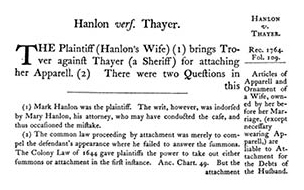
[P. 99]
4 George III (Aug.) in the Superior Court of Judicature
1 · brief description
This is a “trover” [conversion] action by Hanlon’s wife against a sheriff, Thayer, for attaching her clothes to pay her husband’s debts. The two issues were: (1) whether clothes bought before the marriage could be attached and (2) whether the clothes attached were “necessary . . . Apparell” exempt from attachment by Prov. St. 13 William Chap. 3 (1702), Sec. 367, Com. Sts. C.123, § 42. Held: by a split Court, clothes bought before the marriage could be attached, and that included all but that apparel really necessary for protection from the weather, not clothes “necessary” for one’s “Station in Life.” Reports, supra, 100–103.
2 · court records
Available at Rec. 1764, fol. 109. There is a schedule in the record showing that, among the attached goods were, “earrings, necklaces, laces, ribbons, fans, etc.” and, including “Gloshoes” [goloshes] and an “embrillo.” See Reports, 101, n. 5, as well as a “list of necessary articles” which the Defendant Sheriff “tendered back” before the law suit. See Reports, 100–101, S. Quincy n. 3.
3 · professionals involved
For the Plaintiff wife appeared Robert Auchmuty (1723–1788) and James Otis, Jr., the patriot (1725–1783). For the Defendant Sheriff appeared a “Mr. Chardon,” who does not appear on the list of barristers of August Term, and Jeremy Gridley (1701/2–1767), the informal “dean” of the bar. Chardon is likely Peter Chardon, whom John Adams described as a “promising Youth” pursuing a legal career. Chardon died in 1766. See Diary and Autobiography of John Adams (L. H. Butterfield, L. C. Faber, W. D. Garret, eds., Cambridge, MA, 1961), vol. 1, 47; see also Law Commonplace, vol. 2 of Quincy Papers, “Introduction,” 15. See short biographies at Appendix 6.
4 · authority
No English authorities were cited by counsel for the wife. Chardon cited the English statute 4 George II, c.1 as an example of the narrow meaning of “necessary” at English law. Gridley also cited to Chief Justice Holt’s decision in Hardistey v. Barney, Comberbach’s Reports, London (1724), 356. The Chief Justice was not pleased by the arguments, or the scanty nature of the Authorities, “I should have been extremely glad if this Case had been argued a little more largely by the Gentlemen of the Bar, and more Authorities cited, in Matter of so great Consequence.” Reports, 102.
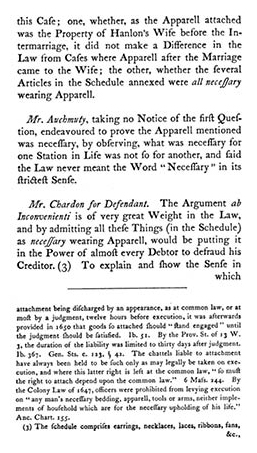
[P. 100]
5 · later citations
Hanlon v. Thayer was cited in Nolin v. Pearson, 191 Mass. 283, 284 (1906) for the precedent that a wife could not alienate or devise her property during coverture without the assent of her husband.
Later Massachusetts statutes allowed a widow all her apparel against auditors of the husband’s estate, Statutes of 1838, c. 145, General Statutes, c. 96, § 4, and later Massachusetts cases defined the word “necessary” in a more lenient way. As Samuel Quincy pointed out, the quaint Chief Justice Lemuel Shaw observed that “This word [necessary] is not used in its most rigid sense, as something absolutely indispensable, and without which a debtor cannot live.” Davlin v. Stone, 58 Mass. (4 Cushing) 359, 361 (1849). See Reports, 103, S. Quincy n. 7.
6 · notes
This case was sometimes called the “Naked Wife Case,” from the Chief Justice’s observation: “for one Gown can never be supposed sufficient-must she go naked when that is washing?” Reports, 103. It has traditionally been used to illustrate the severe hardships that women suffered by their subordinate legal status in the colony. This was felt most painfully when a woman brought ample personal resources by marriage into the grasp of the creditors of a penniless husband. One of my excellent students, Sally Ann Carter, Harvard Law School Class of 1997, did a detailed reexamination of the record, and came to a different conclusion. “My research into the 1764 Massachusetts case Hanlon v. Thayer has opened up possible scenarios and interconnections instead of yielding clean truths. Yet I am comfortable stating that this case is not merely about what it at first glance seems to be: whether ‘a woman with assets who marries a bankrupt husband loses all her belongings to his creditors, including her clothes.’” See Sally Ann Carter, “An Exploration of Hanlon v. Thayer,” May 10, 1997, unpublished paper on file with the Editor, 1. In particular, Ms. Carter argues that the case really “illustrates the effect on legal process of the system of formalistic pleading still in use in 1764” and that “there was no particular reason to believe the husband was bankrupt.” Id. The underlying records, instead, show that the case was really about defenses to collecting a judgment, taking its present form as “the result of the necessity in 1764 of using legal fiction in order to navigate the legal system.” Id. Ms. Carter is right. The record shows that both Quincy and Chief Justice Hutchinson oversimplified the case on appeal, not the first or last time that has happened in the history of the law.
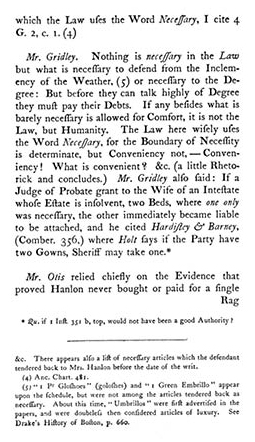
[P. 101]
CASE 38
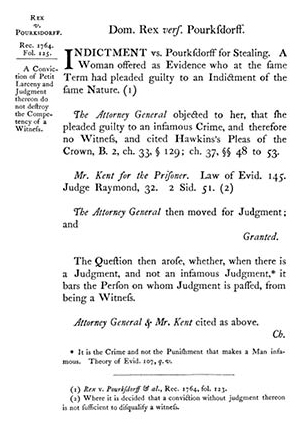
[P. 104]
Dom. Rex v. Pourksdorff (1764)
4 George III (Aug.) in the Superior Court of Judicature
1 · brief description
The sole issue was whether a woman, who had pleaded guilty to stealing, was competent to be a witness for the Defendant, Pourksdorff. Conviction of felony destroyed the competency of a witness at common law, but the Court here held that she could testify, as “the Crime is not of such a Nature as the least to invalidate the Credit of the Witness’s Oath.” Reports, 105. She then testified that she had stolen goods in question, not the Defendant, and Pourksdorff was acquitted on “[t]his Evidence alone.” Reports, 106.
2 · court records
Available at Rec. 1764, Fol. 125.
3 · professionals involved
Counsel were very distinguished, at least for a thievery case. The Attorney General, Edmund Trowbridge (1709–1793), Attorney General, (1749–1767), appeared for the prosecution. Benjamin Kent (1708–1788), who himself became Attorney General in 1776 and served as Suffolk County Attorney General from 1777–1785, appeared for the Defendant. See Appendix 6 for brief biographies.
4 · authority
The Attorney General relied heavily on William Hawkins’s popular Pleas of the Crown (London, 1716–21); see full description in Dom. Rex v. Gay, Reports, 90, Case 35, Note 4, “Authority,” supra. The selections cited hold that a pardon can enable a convict to “be a good witness,” which is not really in point. Kent cited “Law of Evidence,” almost certainly referring to Law of Evidence by a Late Learned Judge [G. Gilbert], 145, first published in Dublin in 1754 and London in 1756, with subsequent editions in 1760 and 1769. See Sweet & Maxwell, supra, vol. 1, 379:5. He also cited [Sir Thomas] Raymond’s Reports, 32 [the case of Fitch v. Smalbrook (1661)], a case about a prior conviction on perjury being entered into evidence “to weaken the credit of a witness,” thus not really on point. Sir Thomas Raymond’s Reports covered all the common law courts from 1660–83, and were first published in London in 1696. See Sweet & Maxwell, supra, vol. 1, 308:106. He also cited [Sir Thomas] Siderfin’s Reports, vol. 2, 51 [the case of Foster v. Ramsy (1657)] which involved disability of felons, but was not directly on point. Siderfin’s Reports covered the King’s Bench from 1678–94, and was published in London in 1683–84 with Part 2 in 1689. See Sweet & Maxwell, supra, vol. 1, 309:120. Many thanks, as always, to Mark Sullivan.
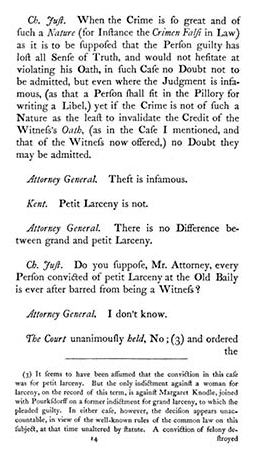
[P. 105]
At one point, the Chief Justice speculated on what English Practice would be in such a case. “Do you suppose, Mr. Attorney, every Person convicted of petit Larceny at the Old Baily [the London criminal sessions] is ever barred from being a witness?” Reports, 105. The Attorney General honestly answered, “I don’t know,” but the Chief Justice’s question appeared to be more argumentative than a genuine search for guidance.
5 · later citations
None. As Samuel Quincy pointed out in Quincy, 104–105, S. Quincy n. 2, conviction for even small larcenies excluded witnesses, until all exclusion for convictions was abolished by statute in 1851. See St. (Mass) 1851, c. 233, § 97; St. 1852, c. 312 § 60.
6 · notes
Samuel Quincy thought this case was clearly wrong. “[T]he decision appears unaccountable, in view of the well-known rules of the common law on this subject, at that time unaltered by statute.” Reports, 105, S. Quincy n. 3.
Another way of looking at it was that the Court was clearly right, and anticipated legal reforms still eighty years in the future. As the Chief Justice forcefully pointed out, the issue is not a technical one (i.e., “grand larceny” or “petit larceny”), but a practical question of whether “it is to be supposed that the Person guilty has lost all Sense of Truth, and would not hesitate at violating his Oath.” Reports, 105. “[I]f the Crime is not of such a Nature as the least to invalidate the Credit of the Witness’s Oath, (as in the Case . . . of the Witness now offered), no Doubt [it] may be admitted.” Reports, 105.
Despite Samuel Quincy’s protestations, this decision led to the acquittal of an innocent Defendant. It was a reasonable, balanced application of a rule of evidence.
ILLUSTRATION 28: The “Old Bailey,” London, showing a testifying witness. See the reference in Dom. Rex v. Pourksdorff (1764), Reports, 105 (Case 38). From Rudolf Ackerman, The Microcosm of London (1808–1811?). The engraving is done by the famous Thomas Rowlandson (1756–1827). Courtesy, Coquillette Rare Books Room, Boston College.
CASE 39
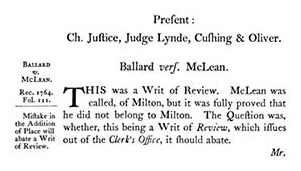
[P. 106]
4 George III (Aug.) in the Superior Court of Judicature
1 · brief description
The Defendant was wrongly said to be “of Milton” in a writ of review. Even though the error was that of the Clerk’s office and the three-year limit for review would expire before another writ could be brought, the writ was abated, by a split court.
2 · court records
Available at Rec. 1764, Fol. 111.
3 · professionals involved
Richard Dana (1700–1772) argued in support of the writ. Oxenbridge Thacher, Quincy’s pupil master, (1719–1765) argued for abatement. See brief biographies in Appendix 6.
The Court split. Four Justices sat. Justices Lynde, Cushing, and Oliver voted to abate the writ, and the Chief Justice dissented, stating, “[a]bstracted from the Custom I see no Reason why it [the writ] should abate.” Reports, 107. The Chief Justice led his colleagues in dissents. See Appendix 1 and the brief biographies of the Justices in Appendix 7.
4 · authority
Dana cited Strange’s Reports, a very popular English reporter in the colonies. See Quincy’s Law Commonplace, [21], n. 12. It was first published in London in 1755 in two volumes, and covered cases from 1716–1749. The case cited was Cortisos v. Munoz, 2 Strange’s Reports 924 (1732), which held that if a Defendant was described nuper (“lately”) of London merchant, the writ was good, even if the Defendant was “commorant in Middlesex.” Thacher quite rightly distinguished the case by observing that “had he [the Defendant] been named nuper it might have done, but the Plaintiff has declared with Certainty.” Reports, 107.
5 · later citations
None. Later Massachusetts cases were more lenient when quashing a writ would cost a Plaintiff a right to appeal. See Clap v. Joslyn, 1 Mass. 129, 133 (1804); Reports, 107, S. Quincy n. 1. Samuel Quincy also cites Brewer v. Sibley, 54 Mass. (13 Met.) 175, 177 (1847); Commonwealth v. Green, 17 Mass. 515, 537 (1822); and Commonwealth v. Keith, 49 Mass. (8 Met.) 531 (1844).
6 · notes
This was a harsh pleading case, where a Clerk Office error of no real consequence cost a Plaintiff a writ of review. Attention to such technicalities of pleading, when real consequences were involved, astonishes modern lawyers. The Chief Justice, at least, would have allowed the writ.
CASE 40
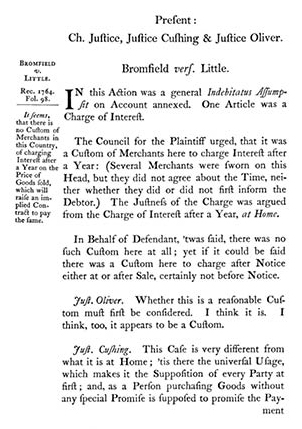
[P. 108]
4 George III (Aug.) in the Superior Court of Judicature
1 · brief description
The sole issue in this case is whether the Defendant debtor should pay a customary interest on an outstanding debt after one year. This was the custom “at Home” i.e., in England. A split Court held that this custom “however reasonable it may be” had not yet been adopted “here” nor “is it implied in the Contract.” So instructed, the Jury did not allow the Plaintiff creditor interest.
2 · court records
Available at Rec. 1764, Fol. 98.
3 · professionals involved
There was no indication of counsel.
Three judges heard the case. Justice Oliver thought that the custom was “reasonable” and in effect. Justice Cushing held that the custom, “however reasonable” was not in effect “here,” and Chief Justice Hutchinson, himself a wealthy merchant and shipowner, agreed with Cushing. The Chief Justice was “glad it is growing into a Custom” but doubted “whether it is so general as it can be supposed in this Case.” Reports, 109.
4 · authority
Except for reference generally to the custom “at Home,” none cited.
5 · later citations
None.
6 · notes
For such a short case, this was highly significant jurisprudentially. The Chief Justice noted that, “This case is of much importance to the Community.” Reports, 109. All three Justices made it clear that they would look to mercantile custom as a source of law. They even allowed merchant testimony to assist them. “Several Merchants were sworn on this Head, but they did not agree about the Time, neither whether they did or did not first inform the Debtor.” Reports, 108. The only disagreement between the Justices was whether the custom had sufficiently evolved to be “supposed in this Case.” Id., 109.
In addition, all three Justices state explicitly, or imply, that incorporating mercantile custom into the common law was a two-step process. First, “[w]hether this is a reasonable Custom must first be considered.” Second, if found “reasonable,” is the custom a “universal Usage, which makes it the Supposition of every Party at first. . . .” Reports, 108.
Finally, all three Justices ignored the argument of counsel for the creditor that the “Justness of the Charge” was to be established by reference to the custom “at Home,” in England. Colonial mercantile custom, in the view of at least Justice Cushing and the Chief Justice, should be determined solely by the custom in the colony, not England.
“Incorporation” of mercantile custom into the common law was an important development in the eighteenth century, best symbolized by William Murray, Lord Mansfield, the great English Chief Justice. See Daniel R. Coquillette, “Legal Ideology and Incorporation IV: The Nature of Civilian Influence on Modern Anglo-American Commercial Law,” 67 Boston University Review, 877, 934–970. After the Revolution, “custom” became even more important in American jurisprudence, and was emphasized by jurists such as Jesse Root (1736–1822) in his “Preface” to his Connecticut Reports (1798), covering the period 1789–1798. American customs, in Root’s mind, helped solve the problem of how to have enough law for the new Republic without adopting English law wholesale, something he found distasteful.
As Root observed:
[A]nother branch of common law is derived from certain usages and customs, universally assented to and adopted in practice by citizens at large, or by particular classes of men, as the farmer merchants, etc., as applicable to their particular business, and to all others of the same description, which are reasonable and beneficial.
These customs or regulations, when thus assented to and adopted in practice, have an influence upon the course of trade and business, and are necessary to be understood and applied in the constructions of transactions had and contracts entered into with reference to theory. To this end courts of justice take notice of them as rules of right, and as having the force of laws formed and adopted under the authority of the people. Id.
See the discussion at Daniel R. Coquillette, The Anglo-American Legal Heritage, supra, 428–433.
This short case illustrated Root’s important ideas in actual practice.
charge no. 1
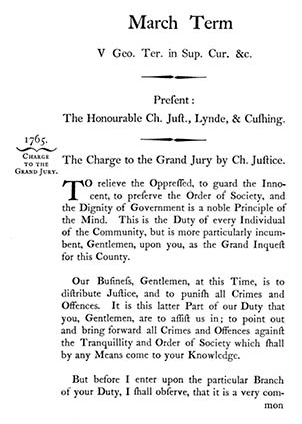
[P. 110]
Charge to The Suffolk Grand Jury by
Chief Justice Hutchinson 1765-March Term
notes: page 110
The “Grand Jury” was a “jury of presentment.” As such, it did not decide the ultimate guilt or innocence of a suspect, but merely whether there was adequate reason to bring the suspect to trial, a standard that later became “probable cause.” “Grand juries” got their name from the Law French “big” because they were larger than the “petit,” or “petty” trial juries. At English law, the number was usually 23, as opposed to a trial jury of twelve. See D. R. Coquillette, The Anglo-American Legal Heritage, supra, 160–62.
“The presenting body at the assizes or quarter sessions acquired the name ‘grand jury,’ to distinguish it from trial juries. The grand jury was charged to make presentments from its own knowledge, but the regular practice from at least the 1360s was for draft written accusations (known as bills of indictment) to be prepared in advance of the session. The grand jurors scrutinized these bills, if necessary hearing ex parte evidence from accusers; if they considered that there was a case to answer they found the bill ‘true,’ and it was endorsed billa vera (‘a true bill’), but if they did not it was endorsed ignoramus (‘we do not know’) and proceedings on the bill ended. The finding of a true bill by the grand jury was not a conviction, or a finding of guilt, and it required only a majority vote of twelve; it was written accusation upon oath, the effect of which was to initiate proceedings between the king and the accused person to try the issue of guilt.” J. H. Baker, An Introduction to English Legal History (3d ed., London, 1990), 576–577 (notes excluded). See also D. R. Coquillette, The Anglo-American Legal Heritage, supra, 160–62; J. H. Baker, “Criminal Courts and Procedure at Common Law” in Crimes in England 1500–1800 (J. S. Cockburn, ed., 1977, pp. 15–48).
The Massachusetts Grand Jury also consisted of 23 and could act by a bare majority of twelve. As the Chief Justice noted “In the Petty Jury, Gentlemen, you are sensible that all must agree in the Verdict; but to every Indictment the Agreement of twelve only is sufficient.” See Reports, infra, 116.
Grand juries evolved in England partly to assist “justices in eyre,” often called “assize justices.” These were royal high court judges who “rode circuit” from county town to county town at regular intervals, hearing cases that should be tried by the common law of the realm, as opposed to local courts and Magistrates. Serious crimes, termed “felonies” from the law French, were so included, as opposed to “misdemeanors,” lesser offences of little interest to the central authorities. One simple reason for the distinction was that “felonies” could result in “escheat,” or forfeiture, of the Defendant’s land to the feudal lord or Crown, matters of keen interest to the central tax collectors.
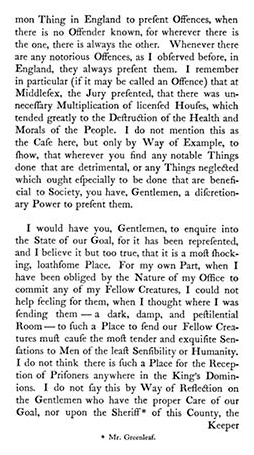
[P. 111]
Grand juries were expected to use any information available to them to discharge their duty. They also had the function under the assize Judge’s Commission of Gaol Delivery to inspect the local gaols and dungeons and to be sure those held were either indicted and tried, or released. See J. H. Baker, An Introduction to English Legal History (3d ed., London, 1990), 20–25.
In Massachusetts, the Superior Court of Judicature stood in place of English high court judges of the common law, and the Grand Jury served a very similar function, even centuries later. Thus, the Chief Justice emphasized that the Grand Jury could use information that “by any Means come to your knowledge,” Reports, 110, and that it had a special responsibility to inspect the gaol where accused were held. Reports, 111–112. This responsibility, in Massachusetts, had developed to include inspecting conditions in the gaol, rather than just being sure those held were properly tried or released. Reports, 111–112. The Grand Jury was also to focus on serious felonies, and could “omit taking Notice of such Misdemeanors, (i.e., ‘lesser offences’) unless you should think there has been any gross Neglect in the courts of “Inferior Jurisdiction.” Reports, supra, 116.
Was a Grand Jury a tool of the state, or a defender of the innocent and a check on state power? This controversy persists to this day in America. In 1765, it was clear that the Chief Justice saw the Grand Jury as a tool of the prosecution, and that the Grand Jury received “Directions” from the Attorney General. Reports, 112. The Chief Justice’s instruction on secrecy also showed that the colonial administration would not hesitate to use secret informers, i.e., spies. Reports, supra, 116. There was, and is, another good reason for Grand Jury secrecy, and notably overlooked by the Chief Justice. Information given to a Grand Jury is not subject to challenge, as it would be in a trial. Secret information of this sort is notoriously unreliable, and that is the primary reason for Grand Jury secrecy today. See Federal Rules of Criminal Procedure, Rule 6, and Moore’s Federal Practice, § 606.06.
The Chief Justice also focused on certain areas where he believed the jurors would be tempted to excuse felonious conduct, contrary to their “Duty.” The first was reporting offenses where “no Offender is known,” i.e., no identified Defendant. The example given was “multiplication of licensed Houses.” Reports, 111. The second was “Riots, Routs and unlawful Assemblies,” with particular attention to the “Pope Day,” the anniversary of the Gun Powder Plot, which featured contests between the street mobs of the North and South End. Reports, 113. The Chief Justice glossed over highway robbery, “very rare in this Country,” but emphasized forgery, particularly “Forgery of Notes of Hand.” Reports, 115. The first two offenses, too many bars and charges of riot against individuals who were engaged in a publicly popular-if rough-celebration, were obvious examples of where jurors would be reluctant to act. The third, forgery of notes of hand, was described as a “wicked” crime, “how destructive its Consequences[!].” A lay juror might well fail to understand that negotiable notes were like “Public Bills of Credit,” i.e., like cash, and that their forgery was the economic equivalent of highway robbery, albeit with a pen. Reports, 115.
One is left wondering if the Chief Justice had a political agenda in March of 1765. Certainly the following “Pope’s Day” took on political overtones, following the Stamp Act, as Samuel Quincy observed, Reports, 113–114, S. Quincy n. 3, and Grand Jury secrecy for informers could also become important for cases of treason. But there were politically neutral explanations for his exhortations as well, as discussed above.
notes: page 111
Chief Justice Hutchinson’s concern for prisoners in the Gaol, “our Fellow Creatures,” was remarkable, in his day and ours. The Gaol was only used to house those awaiting trial. “Every Man in the Eye of the Law is presumed innocent till proved guilty. How preposterous then, Gentlemen, is it to commit a Man to a Place, who whether innocent or not must run the Hazard for his Life. . . .” Reports, 112. The Massachusetts county jails, still used in part for the same purpose, long presented such problems, and judges and counsel today still express similar concerns, ranging from conditions in local jails to extraordinary detention at Guantanamo Bay. See, for example, Inmates of the Suffolk County Jail v. Eisenstadt, 360 F. Supp. 676 (1973) (U.S.D.C., Mass., Garrity J.) holding that conditions at the former Charles Street Jail were so bad as to violate the inmates’ rights under the Eighth and Fourteenth Amendments. Id., 690–691. See also Marion County Jail Inmates v. Anderson, 270 F. Supp. 2d 1034 (U.S.D.C., S. D. Indiana, Barker, J.). As to Guantanamo Bay, see El-Banna, et al. v. Bush, 394 F. Supp. 2d 76 (2005) (U.S.D.C., D.C., Oberdorfer, J.), finding that petitioners there failed to demonstrate “an imminent threat to their health.” Id., 78. Many thanks to Charles Riordan.
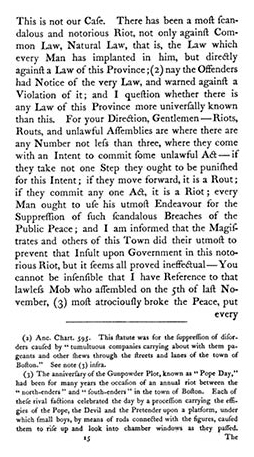
[P. 113]
notes: page 113
The Chief Justice’s appeal to “Natural Law, that is the Law which every Man has implanted in him,” as well as to the Common Law (i.e., non-statutory law) and the “Law of the Province” (i.e., statutory law) showed juristic sophistication. Reports, 113. Note, however, that he especially relied on the statutory law, particularly where the offenders have direct notice of the statute.
CASE 41
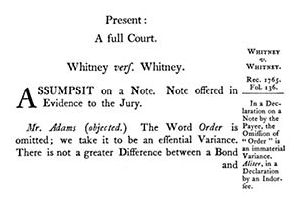
[P. 117]
5 George III (Aug.) in the Superior Court of Judicature
1 · brief description
This is a general contractual (“assumpsit”) action on a Note. The Note apparently was to pay “Plaintiff” instead of the usual “Plaintiff or Order.” (Defense counsel stated “Order” was omitted, Plaintiff’s counsel said only the “or” was left out.) Since the action was brought by the payee, rather than a third party holding the Note by endorsement, the omission made no difference. But the Note apparently went to the Jury on another point, whether it was properly made at all by the payor.
2 · court records
Available at Rec. 1763. Fol. 136.
3 · professionals involved
John Adams (1735–1826) appeared for the Defendant. Robert Auchmuty (1723–1788) appeared for the Plaintiff. See Appendix 6 for short biographies.
It was unclear why the Chief Justice did not give his opinion in such a simple case, unless it was because of some conflict of interest.
4 · authority
Adams cited Baynham’s Case (1730), Fitz-Gibbons Reports (covering 1727–1732), 130, 131, published in London in 1732, and W. Nelson’s Law of Evidence, published in London in 1717, 1735, 1739, and 1744. See Sweet & Maxwell, supra, vol. 1, 300:55 and 379:7, respectively. These authorities were cited for the rather weak and obvious point that some variances in negotiable instruments “are fatal.” Reports, 118. But this was where the Plaintiff was a third party taking by endorsement, and the date was wrong. Auchmuty also cited an English source, G. Duncombe’s Trials per Pais: a Law concerning Juris Nisi Prius etc., 399, first published in 1665 and republished eight times by 1739, see Sweet & Maxwell, vol. 1, 375:8, observing that Adams’s cases were inappropriate.
5 · later citations
As Samuel Quincy noted, Fay v. Golding, 27 Mass. (10 Pick.) 122 (1830) decided the same point of law, where the action was brought by the payee, omission of “or his order” was not a “material variance.” Reports, 118, S. Quincy n. 1.
6 · notes
This was an apparently “open and shut” case where the Note was made to the Plaintiff payee, and had not been endorsed to a third party. Why a lawyer as skilled as John Adams would defend such a case as an “essential variance” is the only mystery.
The Court did say the “Note should go in as Evidence, on another Point,” and Josiah Quincy cross referenced Case 21, Russel v. Oakes (1763), Reports, 48. In the Russel case the note had been endorsed to the Plaintiff, but had been already paid by the payee, a much more difficult problem-see the discussion at Case 21, Note 6.
CASE 42
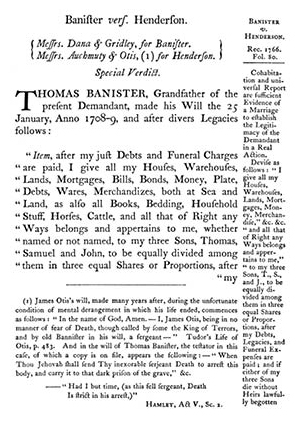
[P. 119]
5 George III (Aug.) in the Superior Court of Judicature
1 · brief description
This is another very important case, described by Auchmuty as “a Case of great Expectations and great Importance,” Reports, 128. Like Dudley v. Dudley (1762), Reports, 12, Case 9, and Elwell v. Pierson (1763), Reports, 42, Case 20, it involved a poorly drafted will. (The will, made on January 25, 1709, raises important questions as to the general competency of the colonial bar at that time, or whether the testator, an obviously rich man, even had legal advice, Otis asking which use of words “is likeliest to get into the Head of a mere Layman. . . .” Reports, 136.) There was also a threshold issue as to whether the testator was lawfully married.
The ancestor, Thomas Banister, left his estate to be “equally divided” between his three sons, John, Thomas, and Samuel, “and if either of my three Sons die without Heirs lawfully begotten in Wedlock, I will their Share or Proportion to the surviving Sons or Son of their Heirs forever.” Reports, 120. The sons died in this order: John (without issue), Thomas (with issue), and Samuel (without issue). Samuel, the last surviving son, “supposing he had a Fee, conveys away this Estate.” Reports, 124. The Demandant, Banister, heir of Thomas, now sues “the Tenant,” to whom Samuel alienated the estate, on the grounds that the land was entailed, with cross-remainders and thus Samuel was only a tenant entail, with no interest to sell that would survive his death. The proper title would, thus, be in the surviving heir of Thomas, as tenant entail. (Note: under the holding in Baker v. Mattocks (1763), Reports, 69, Case 29, that would be the eldest male-as entails were ruled to be not partible in Massachusetts.)
The argument for the Defendant Tenant was four fold: 1) that the testator was not legally married so that the Demandant was not a legal heir; 2) that the words of the will established three equal tenancies in common, with executory devises over, not an entail-thus Samuel, as surviving son, had a legal fee to sell; and 3) that even if an entail was established by the words of the will, it would have been subject to three cross-remainders, and the law allowed only two; and 4) that collateral warranties between the brothers would bind their issue, including the Demandant.
The Court held that the testator was legally married, despite the absence of a marriage certificate. This was due to the evidence of cohabitation and universal report. But by a closely divided decision, three to two, the Court further held that the Tenant should nevertheless prevail, apparently because the words of the will established tenancies in common with executory devises, rather than an entail with cross-remainders. (According to Quincy, the collateral warranty argument was abandoned by Tenant’s counsel, although both he and Samuel Quincy noted that it was a good defense.)
There was no reason given for the ultimate judgment, but the arguments of counsel were set out at length by Quincy. The three prevailing Justices were Lynde, Cushing and Russell, and the dissenters were the Chief Justice and Oliver. Among the prevailing arguments were powerful policy appeals by James Otis, Jr., against the institution of entail. “The Common Law and Policy of England have been, this 4 or 500 Years, tired of these intailed Estates . . . Many have been the ill Effects felt both by State and Individuals. . . .” Reports, 140. It was also noted that a decision for the Demandant would be against equity, depriving the Tenant of land “-fairly purchased, long possessed, the Purchase Money used to support the [Banister] Family.” Reports, 147.
2 · court records
Available at Rec. 1766. Fol. 80. Samuel Quincy noted that an opinion was given by John Read (1680–1749) in 1745 on the same will. See Banister v. Cunningham, Rec. 1754, Fol. 148. See Reports, 156–159. Read came to the opposite conclusion from the Court, finding that the words of the will established an “Estate Tail” with “Cross-Remainders.” See Reports, 157. He also concluded that the Estate Tail would be partible, giving each heir a tenancy entail, exactly opposite from what the Court eventually decided in Baker v. Mattocks, Reports, 69, Case 29, supra. Rarely do we have two major legal reviews of the same words in a colonial will, much less two reviews that come to exactly opposite results! This certainly demonstrates the difficulty of the case.
3 · professionals involved
Richard Dana (1700–1772) and Jeremy Gridley (1701/2–1767) appeared for the Demandant, and Robert Auchmuty (1723–1788) and the patriot James Otis, Jr. (1725–1783) appeared for the Tenant. See short biographies in Appendix 6. These arguments may have been among their greatest. Quincy records brilliant, even biting, exchanges. In addition, each side was asked to file a “brief State of the Case” to assist the Court, and these are reproduced at Reports, 145–151. This was a highly unusual procedure. Finally, Quincy reproduced “Another State of Banister’s Case which I received from Chief Justice Hutchinson,” which he also reproduced. See Reports, 151–155.
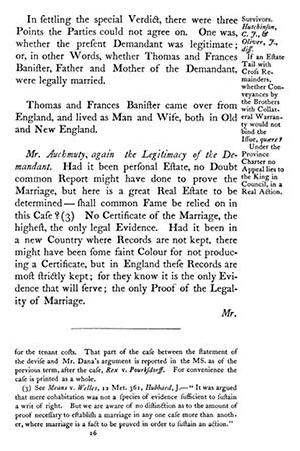
[P. 121]
The latter remains a mystery. It stated with brilliant clarity the argument for the Demandant, but it was apparently not written by Demandant’s counsel. We know Chief Justice Hutchinson favored the Demandant’s case. Did he write this document?
This was one of the most prominent cases to be decided by a closely divided court, 3 v. 2, with Lynde, Cushing & Russell in the majority, Chief Justice Hutchinson and Oliver in dissent. Hutchinson was the most frequent dissenter in Quincy’s Reports. See Appendix 1, infra.
The “tone” of the legal argument in this case was certainly remarkable-far more personal and combative than what Quincy usually records. Gridley referred to one of the opposing arguments as a “terrible Bugbear.” Reports, 141. The exchange continued:
“The Lawyers who talk of the Abhorrence of the Law, the Confusion, the Awkwardness, and I don’t know what all, of Cross Remainders, were asleep, I believe, and had their Heads muffled up in Napkins.
Mr. Auchmuty. I don’t understand such Reflections.
Mr. Gridley. I meant no Reflection on you, Sir.
Mr. Otis. Mr. Auchmuty, I did not take Mr. Gridley intended to reflect upon us, but on all the Judges of England.
Mr. Gridley. What mighty Difficulty to former People I can’t tell; ’tis very plain now. Cross Remainders may be among 2; why not 3?”
Such an exchange, while civil by today’s standards, was not the norm for an active bar of just over a dozen men, who frequently dined together. Gridley, Otis, Thacher, Adams and Auchmuty even formed a little “Law Clubb” . . . “for the study of Law and oratory.” See Diary and Autobiography of John Adams, L. H. Butterfield, ed., Cambridge, Mass., 1964), 1, 251. (Hereafter, “Adams Diary.”) See also Daniel R. Coquillette, “Justinian in Braintree,” Law in Colonial Massachusetts, eds. Coquillette, Brink, Menand (Boston, 1984), 376–382.
4 · authority
Of all of Quincy’s cases, this remains the most important for what it tells us about colonial use of legal authority. Not only did Quincy record the arguments of counsel in great detail, but he also noted the reaction of the judges-and added his own critique of both the arguments and the judges. Quincy’s critiques, added by way of notes, were usually more accurate than what was happening in the courtroom. These notes leave little doubt that Quincy was a particularly talented young lawyer, a thesis confirmed by his Law Commonplace. It is also possible that Quincy was being advised by a senior lawyer. If so, it was not one of the participating lawyers, as Quincy’s comments cut both ways. Finally, while almost all of the voluminous authority cited was English, this case was also one of the rare examples of citations to earlier colonial cases-in particular, Dudley v. Dudley, Reports, 12, Case 9, supra, and Elwell v. Pierson, Reports, 42, Case 20, supra. This would surely have encouraged Quincy’s reporting “project.” Each of these important aspects of Banister’s Case will be commented upon below.
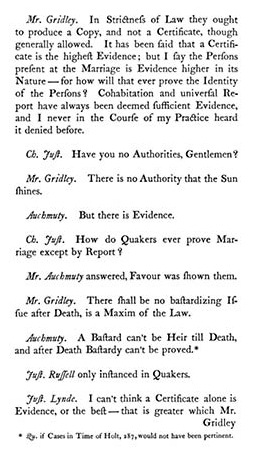
[P. 122]
A. The Marriage Issue
The Demandant had to prove that he was the legitimate heir of his grandfather, as a threshold issue. But there was no wedding certificate. The question was whether their living together for years as man and wife would be sufficient evidence. Gridley, for the Demandant, appealed to his own long experience, “Cohabitation and universal Report have always been deemed sufficient Evidence, and I never in the Course of my Practice heard it denied before.” Reports, 122.
But the Chief Justice wanted authority. “Have you no Authorities, Gentlemen?” Gridley’s response, “There is no Authority that the Sun shines,” obviously displeased the Chief Justice, for he noted again, “I am sorry for Want of Authorities.” Reports, 122–123. He obviously took the matter into his own hands, and appeared the next day with authority from Burn’s Ecclesiastical Law, first published in London in 1760, and again in 1763. See Sweet & Maxwell, supra, vol. 1, 166:22. Burn established that “cohabitation of the Parties” and “publick Fame and Report” was evidence of marriage and, more importantly, that “half Proof, ought to be extended in Favour of Marriage, rather than contrary to it.” Reports, 123–124. The key passage from Burn was directly quoted from Thomas Wood’s A New Institute for the Imperial on Civil Law, first published in London in 1704, and republished in 1712, 1721 and 1730. This authority apparently resolved the issue for the marriage.
It is worth noting that Thomas Wood, D.S.L. (1661–1722), was a leading English civilian jurist, from the famous group of Roman law learned scholars and practitioners centered in Doctors’ Commons, London. Richard Burn (1709–1785), a clergyman, frequently relied on civilian expertise. Banister’s Case is thus an example of colonial American cases that relied on English civilian, rather than common law, authority. See the discussion in Daniel R. Coquillette, The Civilian Writers of Doctors’ Commons, London (Berlin, 1988), 198–215.
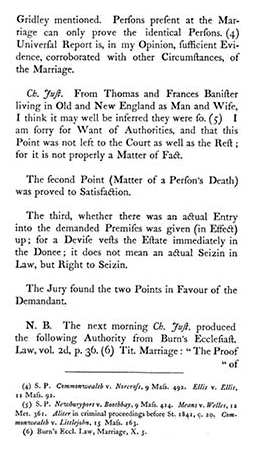
[P. 123]
B. The Entail Issue
The central argument in the case was whether Banister’s poorly drawn will established an entail with cross-remainders-which would give the Demandant title as Banister’s senior male heir-or whether it established tenancies in common between Banister’s three sons, with executory devises, which would give the Defendant Henderson good title. See the discussion at Note 6, infra. Like any botched will, there was unlikely to be any case directly in point, and many cases available to both sides to argue by analogy. So many sixteenth, seventeenth, and eighteenth-century English cases were invoked, that Gridley complained, “I won’t produce 20 Authorities where 1 is necessary; here have been numerous Authorities cited, to what Purpose I know not, unless Show.” Reports, 143 (emphasis in the original). Otis answered, with equal sarcasm, “You must allow children a little ostentation.” Reports, 143.
Despite the range of the English cases cited on both sides, it became clear in the argument that the lawyers were only imperfectly aware of what the cases held, and were also fairly ignorant of the relevant English statutes. As an example, Dana cited to Chadock v. Cowley (1625), 2 Croke’s Reports, 695. (Croke’s Reports, part 2, covering the period 1582–1641, were first published in London in 1657.) See Law Commonplace, [21], n. 6. Otis interrupted, rather unprofessionally, stating, “Are you not sensible, Sir, Lord Holt denies that Case to be Law?” Dana, taken aback, replies, “No: But if he does, he is not infallible: But the Authorities mentioned are sufficient.” Reports, 126.
It was certainly reasonable for Otis to invoke the name of the great English judge, Sir John Holt (1642–1710), who was Chief Justice of the King’s Bench for 21 years, 1689–1710. But Holt had not doubted Chadock v. Cowley, which found a fee tail by implication, but rather Hearn v. Allen (1627), 3 Croke’s Reports, 126, which found, three to two, no fee tail. Since Otis was arguing against the fee tail, Lord Holt’s doubts about Hearn, expressed in Nottingham v. Jennings, 1 Lord Raymond’s Reports, 570 (1st ed. London, 1743), cut against Otis, not for him! (Holt said of Hearn, “If the said case were law.” Id., 570.) Quincy quickly picked this up, noting “Qu. If that Doubt of Lord Holt does not make against Mr. Otis” and later “Qu. If the Case . . . would not be in Favour of the Demandant.” Reports, 126. But neither of the advocates, Dana nor Otis, knew enough English law to catch the error. Quincy, however, did!
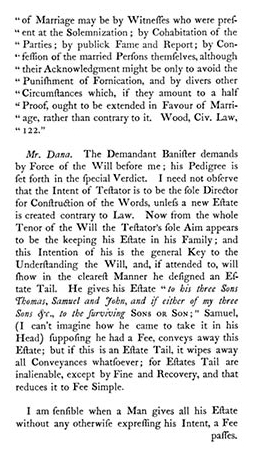
[P. 124]
The same occurred with a key English statute. The Chief Justice asked Auchmuty, “What do you suppose can bar an Estate tail?” He replied, “Conveyances with collateral Warranty.” Reports, 128. Indeed, the final argument for the Defendants was that such conveyances barred the issue in this case. This time Gridley interrupted, “Abolished long ago by Act of Parliament.” Reports, 128. Auchmuty has no immediate answer, and later, rather lamely, remarked, “It is true there is a statute about Warranties, but unless they produce, I shall not answer it,” a response prohibited by modern professional rules that require a lawyer to disclose to the court adverse authority not disclosed by opposing counsel. Reports, 133. See A.B.A. Model Rules of Professional Conduct Rule 3.3 (a)(2).
In truth, the statute in question, 4 & 5 Ann, ch. 16 (1706), was not relevant at all, as it only applied to ancestors making collateral warranty that did not have an estate of inheritance in possession, which would not be the case here under either party’s theory, a point picked up by Otis, who also denied “the Statute of Ann to extend here.” Reports, 140. With this view, Quincy himself agreed. “[A]nd qu. if ye Act of Parliament extends, or is binding here.” See Reports, 145.
The point is that, despite all the quantity of English authority argued in this case, the lawyers themselves were not particularly accurate or skillful in its use. Quincy, on the other hand, knew a lot of English law, and caught some of the errors.
It is also very important to note that, in the end, both sides relied on policy arguments, rather than relying narrowly on authority. The Demandant’s lawyers emphasized again and again that the testator had intended an entail, even though he used the wrong technical terms. Dana argued, “On the Whole, the Testator’s sole Intent plainly appears to intail his Estate; his Words aptly enough express his Intent; and, as it is consistent with the Rules of Law, it is the Business of the Law to fulfill that Intent.” Reports, 128.
The opposing side argued against entailed land as a matter of policy, urging the judges to find against an entail unless it has been perfectly created. Otis made an impassioned speech:
The Common Law and Policy of England have been, this 4 or 500 Years, tired of these intailed Estates; and therefore every legal Method has been prosecuted for their Suppression. Many have been the ill Effects felt both by State and Individuals, in Conveyance of these Estates; therefore so far from being favoured they have ever been discountenanced; and surely never was such an Estate as is here contended for, favoured-big with the greatest Confusion and Injustice-inconsistent both with Law and Common Sense. I therefore submit it to your Honour’s Judgment, not doubting that Judgment will be rendered according to Law.
Reports, 140.
It should be noted that this case also shows Quincy referring to Blackstone’s Commentaries (Oxford, vol. 1, 1765, vol. 2, 1766, vol. 3, 1768, vol. 4, 1769), something he did only once in his Law Commonplace. See Quincy’s querie “Qu. If 2 Black. Comment. ch. 20, pp. 302, 303 and ch. 13, pp. 381, 382 would have been impertinent in this Case.” Reports, 155. See the discussion of Quincy’s use of Black-stone in Introduction, Law Commonplace, Quincy Papers, vol. 2, 19–20 n. 37.
C. American Authority
Banister left a charge upon the estate: “Funeral Charges, Debts and Legacies,” which, according to Auchmuty, “many of which were very large.” Reports, 130. Auchmuty argued that these charges would convert, as a matter of law, “the Estate into a Fee,” rather than an entail. Reports, 131. This was an argument that the Court had heard before, in Elwell v. Pierson (1763), Reports, 42, Case 20, and is in the famous case of Dudley v. Dudley et al. (1762), Reports, 12, Case 9.
The Dudley case involved another wealthy colonist with a poorly drafted will, where the key words-although apparently intending a fee tail-did not use the correct formalities. The estate had a charge-providing firewood for the testator’s mother, and that was used to argue for a fee simple, rather than a fee tail. The Court, without giving reasons, declined to find a fee tail. Reports, 25. The Elwell case also involved a poorly drafted will with a charge to the legatee to “maintain Myself and his Mother during our Lives with sufficient and convenient Maintenance.” Reports, 43. But in this case the Court found that the legatee “Samuel by the Words would have taken a Tail” but the charge, “the Burden and Duty of Maintenance made it a Fee simple.” Reports, 48.
Both these cases would have strongly supported the arguments against finding an entail in Banister’s Case, as Auchmuty argued, “This Point (of Charge) had great Weight, and justly, in those Cases.” Reports, 131. But Quincy questioned “whether the Case of Elwell . . . was not adjudged against the Law.” Reports, 131. Earlier Quincy noted, “Qu. if any Estate but an Estate for Life can be enlarged by any Charge. For it is Law that ‘no Estate shall pass by Implication of Law against the express Limitation of the Party . . . ,’” citing 2 Coke’s Reports, 556, and 1 Croke’s Reports, 254. Reports, 130–131. Quincy’s point was valid. His statement was a direct quotation from Buckler’s Case (1597), 1 Coke’s Reports 55a, at 55b, which was so applied in Hogg v. Cross, Will, 1 Croke’s Reports (1591), 254, at 255. The error of the Court in Elwell is that it found that the testator’s words established an entail, and thus the charge could not establish a contrary result as an implication of law. In both Dudley, supra, Reports, 12, Case 9, and in this case, Banister v. Henderson, the Court did not find that the testator’s words established an entail. Conceivably, they could have formed that the testator’s words did not establish an express limitation, so that the fact of the charge could be persuasive. Of course, in neither the Dudley nor the Banister cases did the Court give reasons for finding a fee, rather than an entail.
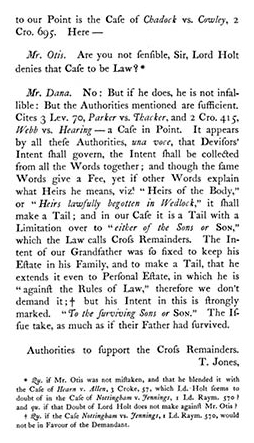
[P. 126]
The relevance of the colonial Elwell and Dudley cases to major cases like Banister must have encouraged Quincy in his efforts to create a Massachusetts law report. The memory of the lawyers was also important, but they frequently appeared on opposite sides of the same issues, and could not be expected to recount the precedents reliably. For example, Gridley argued against the entail in Dudley, for the entail in Elwell, and for the entail in Banister. Auchmuty argued for the entail in Dudley and against the entail in Elwell and Banister. Otis was consistent, arguing against the entail in both Dudley and Banister. With counsel shifting sides on major issues, accurate reports would be valuable to everyone.
5 · later citations
Banister v. Henderson was cited in 1959 in Stamper v. Starwood, 339 Mass. 549, 553 (1959), on the issue of evidence of marriage. The Court held that length of the marriage and number of children could establish the good faith of the wife in determining whether a bigamous second marriage had become valid under an enabling statute that recognized such marriages, if entered into at least one party in good faith.
As Samuel Quincy noted, more than two cross-remainders were allowed by later English and Massachusetts law. Reports, 155–156, S. Quincy n. 9. See Hall v. Priest, 72 Mass. (6 Gray) 18 (1856).
note: page 138
“Videbatur”
The issue being discussed here is whether one could have more than two cross-remainders, a theory necessary to the Demandant’s case. Otis was claiming that the untitled case set out in Dyer, Les Reports . . . (London, 1738 ed.) at 304 was obiter dictum (“a saying by the way”) as far as this case was concerned. Dyer’s Les Reports, covering 1513–1582, was one of the oldest published English reports, first published in London in 1585. See Sweet & Maxwell, vol. 1, 299–300:47. As the Dyer case only involved two cross-remainders, this is correct. Common law doctrine has traditionally regarded any judicial opinion “not necessary to a judgment” as “not binding as precedent.” See Jowitt, supra, p. 1255. Gridley’s reference to the “Roman Judges” of the civilian tradition and “videbatur” (“videbatur,” it “seems”) was inappropriate. See Reports, 138. On Roman law “precedent,” which was not systematic at all, see W. W. Buckland, A Text-Book of Roman Law (3d. ed., Peter Stein, 1963) 638 (“Roman law had no system of precedent”); H. F. Jolowicz, Historical Introduction to the Study of Roman Law (1954), 569 (Precedent as “exemplum”). My thanks to my distinguished colleague, Charles Donahue Jr.
note: page 143
“reddendo Singula Singulis”
This phrase means “by giving each to each,” and refers to the legal construction rule that “when one of two provisions in one sentence is apportioned to one of two objects in another sentence . . . the other provision is similarly appropriated to the other object.” Jowitt, supra, 1493. This is done through common sense. Hence in the phrase “‘If anyone shall draw or load a sword or gun,’ the word ‘draw’ is applied to ‘sword’ only, and the word ‘load’ to ‘gun’ only . . . because it is impossible to load a sword or draw a gun.” Jowitt, supra, 1493.
note: page 145
“Dr. Sullivan’s Lect. On the Laws of England.”
Francis Stoughton Sullivan, L.L.D., did not publish his lectures until 1770. See Francis S. Sullivan, Lectures on the Constitution and Laws of England, London, 1770, Sweet & Maxwell, vol. 1, 108:113. But he began giving the lectures much earlier, at the University of Dublin. See Francis S. Sullivan, A Plan For the Study of Feudal and English Laws in the University of Dublin, Dublin, 1761. The Plan was only 9 pages long. Did Quincy have a manuscript copy, or did he add this note, citing to 182–183, after 1770?
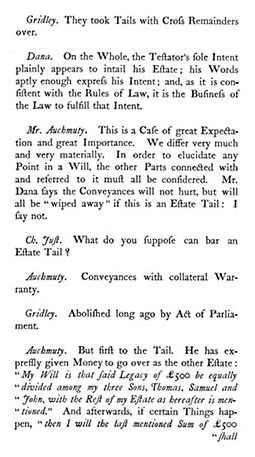
[P. 128]
6 · general notes
As he began his argument, Auchmuty noted that “This is a Case of great Expectation and great Importance.” Reports, 128. Why was such a case so important for the colonials? It certainly involved a lot of money and pitted the leaders of the colonial bar against each other, but so did a number of Quincy’s cases. Auchmuty added, “We differ very much and very materially.” Id., 128. But Auchmuty argued for the entail in Dudley, Reports, 12, Case 9, and against the entail in both Elwell, Reports, 42, Case 20, and Banister, and Gridley switched sides on the entail issue as well. See Note 4, C., supra.
I understand Auchmuty as making a different point. The Banister case presented the Court and the lawyers with an unusually stark choice of policy goals and, despite the brave and often inaccurate display of English authority, little persuasive, much less binding, precedent. And as emphasized in Dudley, Reports, 12, Case 9, the place of entail in the colony had social, economic, and gender importance. See id., Note 6. Finally, as Samuel Quincy noted, there was no Appeal allowed to the King in Council in London in a real action such as this. Id., 25, S. Quincy n.9. See The Charter of the Province of Massachusetts Bay . . . 1691 [Second Charter], Charters and General Laws, supra, 32. The Second Charter allowed appeals to the King in privy council “in any personal action, wherein the matter in difference doth exceed the value of three hundred pounds . . .” (emphasis added). This limitation on real action appeals was not always observed. In Dudley v. Dudley (1762), Reports, 12, Case 9, the Privy Council entered an order for a hearing in May 1765. See discussion at id., Note 6. In a case related to this one, Banister v. Cunningham (1754), described in Samuel Quincy’s note 9, Reports, 156, an attempt was made to appeal to the Privy Council, despite the fact it was a real action. According to Joseph Smith, the appeal was allowed at the Council Board, “although denied below.” See Joseph H. Smith, Appeals to the Privy Council from the American Plantations (New York, 1950), 248, n. 176. See also Privy Council Register, PC 2/104/323, 439, 455. The Privy Council also took a controversial real action case on appeal from the Superior Court of Judicature in 1767 and reversed the judgement below in 1771. See Jeffries v. Donnell, Privy Council Register, PC 2/112/520, PC 2/113/16/76, 88, 98, discussed by Smith, supra, at 163–165. Again, my thanks to Sharon H. O’Connor, my esteemed colleague. Most interestingly, no record has been found of effective local relief in any of these cases, despite Privy Council review. In real actions, as a practical matter, the Court seems to have been on its own.
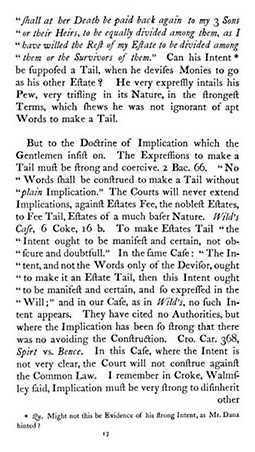
[P. 129]
Here are the legal issues in a nutshell. As observed before, Banister had poor legal advice in drafting his will, despite his great wealth-surely a comment on the colonial profession in 1709! (He may have had no professional help! Otis asks twice about what ideas are “likeliest to get into the Head of a mere Layman.” See Reports, 136, 137.) Banister’s goal was simple, to divide his property equally among his three sons, unless any of the sons died without “Heirs lawfully begotten in Wedlock.” If so, the share of the dead son without heirs should go to “the surviving Sons or Son and their Heirs forever.” Normally, a bequest that does not vest unless there are legitimate heirs was an entail, but Banister used the wrong words. He should have said, “To Thomas, Samuel and John and the Heirs of their Body (in Tail General) and if Thomas dies without Issue, the Remainder of his Share to Samuel and John in tail; and if Samuel dies without Issue, the Remainder of his Share to Thomas and John in tail; and if John dies without Issue, the Remainder of his Share to Thomas and Samuel in Tail (the cross remainders).” (But this is not what the will said! See the actual terms set out at Reports, 119–120.) If Banister had used the right words, it would have been clear that he did not intend to leave either John or Samuel, who died without issue, a vested estate. Tom’s eldest son, the Demandant, would have the tenancy in possession, and Samuel’s sale to Henderson would be void. (Assuming that you could create more than three cross-remainders. See Blackstone’s Commentaries (1766), vol. 2, 381.) The “State of Banister’s Case,” that Quincy “received from Chief Justice Hutchinson,” set it all out plainly. (Did Hutchinson himself write this to convince his brethren?) See Reports, 151, 154–155.
One technical problem with this “solution” was that it created three cross-remainders. At the time, it was doubtful that more than two could be valid at English common law. As Blackstone said, “[T]o avoid confusion, no cross remainders are allowed between more than two devises. . . .” W. Blackstone, Commentaries, vol. 2 (London, 1766), 321. But there was no logical reason why more than two cross remainders could not exist. As Gridley argued, “Cross remainders may be among 2; why not 3?,” Reports, 142, and, indeed, as Samuel Quincy noted, later common law held any number valid. Reports, 156, S. Quincy n.9.
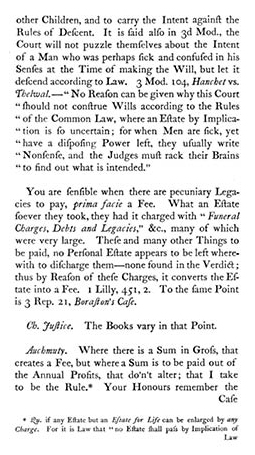
[P. 130]
But not only did Banister use mostly the wrong words to establish an entail for his lands, he actually used mostly the right words to convey an entail male in his church pew! “[T]o my Grandson Thomas . . . if he liveth to have Male Heirs . . . and to his Male Heir’s lawfully begotten in Wedlock forever . . . but if he dieth without Male Hiers, I give it to the next Male Heirs, and to descend to the next Male Heirs, without any Alienation forever.” Reports, 120. As Auchmuty observed, “He very expressly intails his Pew, very trifling in Nature, in the strongest Terms, which shows he is not ignorant of apt words to make a Tail.” Reports, 129.
One solution, favored by the Demandant, was to figure out Banister’s intention, and then implement it, despite the incorrect wording. As Dana argued, “Meaning is evident from all the words taken together, and his Intent shall take Effect.” Reports, 125. Since the testator clearly intended the land to descend to his sons’ issue, if any, and not remain vested in a son without issue, the intent would seem to require a legal entail.
Another solution, favored by the Tenant in Possession who bought the land from Samuel, would be to disfavor entails unless precisely established by the correct terms. In default of correct wording, all three sons would take equal fee simples-subject to executory devises. Even Dana, for the Demandant, admitted that “when a Man gives all his Estate without any otherwise expressing his Intent, a Fee passes.” Reports, 124. Otis argued, with characteristic eloquence, “The Common Law and Policy for England have been, this 4 or 500 Years, tired of these intailed Estates; and therefore every legal Method has been prosecuted for their Suppression.” Reports, 140. Not only do they often disinherit women, given the common use of male entails, but they tie up land and are “big with the greatest Confusion and Injustice-inconsistent both with Law and Common Sense.” Reports, 140. Finally, in this case there was a purchaser who thought he had bought good title. As Auchmuty observed, “[I]t will cause the utmost Confusion thus to eject People out of Lands they have for so many years quietly enjoyed; and . . . to turn them out upon so strained a Construction of Words . . . would be as much against Justice and Equity, as Law and Common Sense.” Reports, 133. (Often colonial entails were barred by prescription in such cases-perhaps the time here fell just short.)
Then there was the question about whether the sale to Henderson involved collateral warranties that would bar the Demandant and other issues. As Quincy observed, the Statute 4 & 5 Ann, ch. 16 (1706) did not bar collateral warranties from tenants in possession, such as Samuel. Further, Quincy questioned “if ye Act of Parliament extends, or is binding here,” probably because the colony had quite a different land law from England. See Reports, 145. But see Baker v. Mattocks, Reports, 69, Case 29, a closely divided judgment holding entails not to be partible under colonial law, despite the provincial statute that made fee simple estates partible.
All in all, these were naked policy choices with very little “fig leaf” of genuinely binding legal precedent to hide the Court’s preference. And the Court, as in Baker v. Mattocks (1763), Reports, 69, Case 29, was narrowly divided, three to two.
Of all recorded colonial cases, this reveals most graphically the dynamics between the opposing lawyers, and between the bench and bar. As discussed in Note 4, above, the lawyers were at the edge of their competence and made a series of technical errors in using English precedent-most caught by Quincy himself. While they certainly cited to English authority, they also made naked policy arguments to the Court, on both sides. Frequently, their appeals to authority were also “bluff,” with both sides ignorant of actual English doctrine. Banister’s Case was so difficult as to give the leaders of the colonial bar a real test of their expertise. If you assume that an isolated bar of little more than a dozen practitioners was inherently incapable of sophisticated argument, Banister’s Case will set you straight. But it also demonstrated that Boston was not London.
Banister’s Case also was extraordinary in that the Court requested written arguments from the lawyers, the “State of the Case” set out at Reports, 146–155. The two “States of the Case” prepared by opposing counsel repeat-in a very concise way-their oral argument. Very different was the third “State of Banister’s Case,” “which I [Quincy] received from Chief Justice Hutchinson, together with the foregoing State of that Case, by the Demandant’s Council.” Reports, 151. Was this third document prepared by an amicus curiae (a “friend of the court”)? Was it written by Hutchinson himself? (It supported Hutchinson’s dissenting view in favor of the Demandant, but appears to have been quite separate from the “State of the Case” prepared by the Demandant’s counsel.) In all events, the three “States of the Case” in Banister’s Case remains a remarkable example of written colonial advocacy.
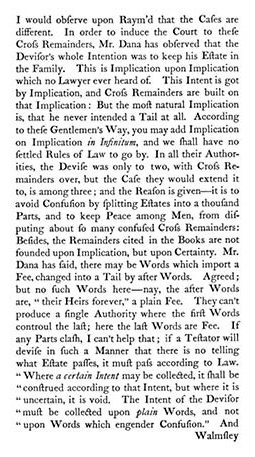
[P. 132]
Finally, it is impossible to read this case without admiration for Quincy as a Reporter. Deprived, by custom, of reasoned opinion from the Justices, he nevertheless corrected counsel’s arguments with impressive knowledge and logical acuity. He was a young and inexperienced lawyer, but he had a first class legal mind. Cases such as Banister’s Case must have convinced him that Massachusetts had reached a point in its legal sophistication where good provincial law reports were needed. There was probably no lawyer in the colony better able than Quincy to fill the need.
There is an excellent student paper by my former research assistant, Kevin W. Cox, Harvard Law School Class of 2005, “Entail on the Eve of the Revolution: Cases from the Reports of Josiah Quincy, Jr.,” on file with the Editor, which explores in depth the relationship between Banister’s Case and Quincy’s other entail cases. See also the extensive discussion of Banister v. Cunningham in Richard B. Morris’s classic Study and History of American Law (1959), 97–98.
The final judgment, for a fee simple and against the Demandant Banister’s entail, was by Justice Lynde, Cushing and Russell, with the Chief Justice and Justice Oliver in dissent. In Dudley, supra, the Chief Justice had delivered a judgment of a united court for the fee simple and against the entail. Reports, 25. In Baker v. Mattocks, supra, the issue was different, whether the entail was partible. But a negative judgment would strengthen the “effect of entail.” There, the Chief Justice and Judge Cushing voted for partibility, but their three other colleagues felt constrained by both custom and law to support the entail unweakened by partibility. Reports, 72–74.
These great cases, Banister’s Case, Dudley, and Baker v. Mattocks, pushed the pragmatic inclinations of the justices against the letter of the English law. They would go quite a ways in favoring fee simple, as in Dudley and Banister’s Case. But Baker v. Mattocks was a step too far. Only Justice Cushing would steadfastly find for the fee simple. Like Chaucer’s Sergeant at the Law, for Justice Cushing, “all was fee simple to his strong digestion.” See Daniel R. Coquillette, Anglo-American Legal Heritage, supra, 289.
CASE 43
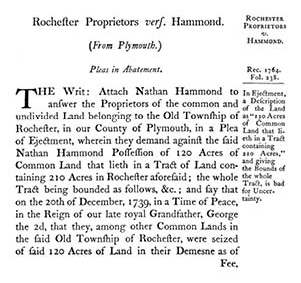
[P. 159]
Rochester Proprietors v. Hammond (1765)
5 George III (Aug.) in the Superior Court of Judicature
1 · brief description
This was a writ in abatement to a Plea of Ejectment because the land was not described with certainty. Held, claiming ejectment from 120 acres in a tract of 210 acres, giving only the bounds of the larger tract, is too uncertain.
2 · court records
Available at Rec. 1764, fol. 238.
3 · professionals involved
Robert Treat Paine (1731–1814), signer of the Declaration of Independence, brought the writ of abatement on behalf of the Defendant. James Otis, Jr. (1725–1783), fellow patriot, represented the Plaintiff Proprietors. See brief biographies in Appendix 6.
Justice Russell and the Chief Justice exchanged comments, both expressing doubt as to whether the Sheriff could accurately lay out the claimed land based on the information given.
4 · authority
Paine cited Edward Savel’s Case (1615), 11 Coke’s Reports, 55a (1st ed., London, 1600). This case held that an ejectione firmae does not lie where it is not clear “of what nature the acres are, as land, meadow, pasture, wood etc.” Id., 55a. It remained the law in Massachusetts that, in an action for land, all the information the sheriff needs must be given within the writ itself. See Samuel Quincy’s note, Reports, 162, S. Quincy n. 1, and Atwood v. Atwood, 39 Mass. (22 Pick.) 283, 287 (1839).
5 · later citations
This case was cited in Pratt v. Bates, 161 Mass. 315, 318 (1844) for the proposition that description of land to interested parties-where the land was being sold subject to contingent remainders-must be certain.
6 · notes
The Rochester Proprietors were trying to protect common land that lay within a larger tract. Otis, their lawyer, argued that “this Land is clearly described; and we have set forth that we demand the southerly Part of the 210–Acre Lot,” quoting the Latin maxim “Id Certum est, quod . . .” [“certum est quod certum reddi potest”] or [“That is certain which is able to be made certain”]. See E. H. Jackson, Latin for Lawyers, 132 (1913). This is from The Earl of Shrewsbury’s Case, 9 Coke’s Reports 46b at 47a (1611), which is not otherwise in point. Otis’s second argument, “But let the Sheriff give us Possession of the whole ’twill certainly be good for our Part recovered,” was immediately contradicted by Justice Russell, who rightly pointed out that “if the Sheriff should lay but wrong, would not Hammond remain possest of the whole?”
Protecting common lands, which could easily be based on more than a century’s casual usage, must have been difficult, and the specificity required by common law pleading increased that difficulty.
CASE 44
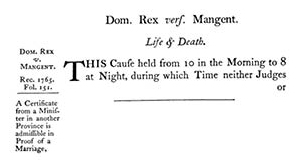
[P. 162]
5 George III (Aug.) in the Superior Court of Judicature
1 · brief description
Captioned “Life & Death,” this dramatic case did, indeed, involve the possible execution of a woman for “murther of a bastard child” pursuant to Province Laws 8 William III, Chap. 38 (1696), “An act to Prevent the Destroying and Murdering of Bastard Children,” which presumed a stillborn bastard to be murdered unless the unfortunate mother had a witness or made no effort to conceal the birth. The defense was that the mother was, in fact married, and the issue was whether a wedding certificate from a minister in another Province “without any Authentication from any Magistrate” could be admitted to prove the marriage. Held, it could be admitted, because the Court had no power to compel the minister or others from another Province to give evidence.
2 · court records
Available at Rec. 1765, fol. 151. It indicated that the woman was acquitted. See Samuel Quincy’s note, Reports, 163, S. Quincy n. 1.
3 · professionals involved
The accused was clearly represented by a lawyer, as many sophisticated authorities were invoked on her behalf. The Attorney General was in court for the King, an important precedent. See Reports, 163, S. Quincy n. 1. See also Rex v. Doaks (1763), Reports, 90, Case 34. The Attorney General was Edmund Trowbridge (1709–1793), who served as Attorney General from 1749–1767, when he became an Associate Justice for the Superiour Court. Representation of criminal Defendants was originally not a usual English common law practice, but was an important professional tradition in Massachusetts. See the discussion at Petition of the Jurors in the Trial of Captain Preston and the British Soldiers (1771), Reports, 382, Case 77, infra.
4 · authority
None were cited for the King, not even the Provincial Law of 1696! A string of English citations were provided for the defense-all on proof or disproof of bastardy. Most notable were “H.P.C.” or William Hawkins, A Treatise on the Pleas of the Crown, first published in two books in London in 1716–1721, and in subsequent editions in 1724–1726, 1739 and 1762. See Sweet & Maxwell, supra, vol. 1, 362–363:27. Hawkins was widely relied on for criminal law issues in the colonies. See Law Commonplace, [81], n. 3. Also cited was Coke on Littleton (“1 Inst.”) originally published in London in 1628. See Law Commonplace, [2], n. 1. This concerned a different context, real property inheritance, “[s]o if a man bee within the four Seas [King’s Dominions], and his wife hath a child, the Law presumpeth that it is the child of the husband, and against this presumption the Law will admit no proof.” Edward Coke, First Part of the Institutes of the Lawes of England: on Commentarie on Littleton (London, 1628), 373a. The argument being, of course, if the woman were married, the child would be presumed to be legitimate, and not a bastard. A citation to Salkeld’s Reports (covering 1689–1712) was also included. The case was Parishes of St. George v. St. Margaret Westminster (1706), Salkeld’s Reports 123. See Law Commonplace, [19], n. 4 and [32], n. 7. Also cited was Mathew Bacon’s New Abridgement of the Law, first published in London in 1736 and another favorite of the colonists. The section “Who are Bastards” explained the “four Seas” or “King’s Dominions” rule. “This was settled when the King’s Dominions extended to the four Seas only; for to pass and repass in the King’s Dominions was possible, without any knowledge or proof; but to pass out of another’s Dominions into the King’s, without some knowledge or Proof . . . was supposed by the Law not possible.” Id., vol. 1, 310. See Law Commonplace, [37], n. 5. Quincy indicated that particular emphasis was given to Kelynge’s Report of divers Case in Pleas of the Crown (covering 1662–1669), first published in London in 1708, and then in 1739. The cited page describes an indictment for the “murder of a male bastard child.” See Sweet & Maxwell, supra, vol. 1, 302:73.
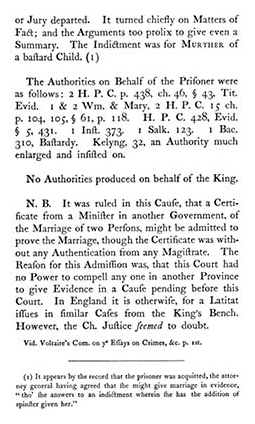
[P. 163]
5 · later citations
None. But this case showed the Attorney General in his role as chief prosecuting officer. A similar case, Rex v. Doaks (1763), Reports, 90, Case 34, was cited in Commonwealth v. Kozlowsky, 238 Mass. 379 (1921), for the proposition that the Attorney General could be present in his official capacity during grand jury deliberations. Id., at 386.
6 · notes
Quincy said that this “Life & Death” case lasted for ten hours straight, “during which Time neither Judges or Jury departed.” Unfortunately, he regarded the “arguments too prolix to give even a summary.” But we can largely recreate this most important gender case from the authorities given and the record. At the heart of the case was Provincal Law 8 William III (1696), chap. 38 which reads:
AN ACT TO PREVENT THE DESTROYING AND MURDERING OF BASTARD CHILDREN.
WHEREAS many lewd women that have been delivered of bastard children, to avoid their shame, and to escape punishment, do secretly bury or conceal the death of their children, and after, if the child be found dead, the said women do allege that the said child was born dead, whereas it falleth out sometimes (although hardly it is to be proved) that the said child or children were murdered by the said women their lewd mothers, or by their assent or procurement,
Be it therefore enacted by the lieutenant governor, council and representatives, convened in general assembly, and it is hereby enacted by the authority of the same, that is any women be delivered of any issue of her body, male or female, which, if it were born alive, should by law be a bastard, and that she endeavour privately, either by drowning, or secret burying thereof, or any other way, either by herself, or the procuring of others, so to conceal the death thereof, that if may not come to light, whether it were born alive or not, but be concealed, in every such case the mother so offending shall suffer death, as in case of murder, except such mother can make proof by one witness at the least, that the child whose death was by her so intended to be concealed was born dead.
Note that the unwed mother of a stillborn baby, with no proof that she intended it any harm, could still be condemned to death if she concealed the baby’s death in anyway, unless she had a witness that the baby was born dead. On the other hand, if she were married, there was a legal presumption (if the father were in the Dominion) that the baby was legitimate, and this not “by law be a bastard,” in the terms of the statute. See Note 4, above.
We can imagine a panic-stricken girl-perhaps unaware of the law-concealing a stillbirth. All would depend, then, on whether she were legally married to a man who could have conceived the child-or who was at least in the country. Thus the seemingly dry, technical issue of whether a marriage certificate from an out-of-province clergyman, without any authentication from a magistrate, was admissible in court becomes, literally, a life and death matter.
Josiah Quincy’s note asserted that in England the clergyman could be compelled to appear by a Latitat. This writ, named from the Latin, latitat et discurrit, “lurks and roams about,” would issue to Defendants to answer to personal actions in the King’s Bench, in conjunction with the fictitious Bill of Middlesex, even though they were “lurking” in counties other than Middlesex. See J. Baker, An Introduction to English Legal History, supra, 42. But Chief Justice Hutchinson “seemed to doubt” this, and it is indeed doubtful that even in England such a writ would lie to produce a witness, rather than the Defendant. See Earl Jowitt, supra, 241, 1062. In practice, the certificate probably would be the best available evidence. Also, the decision saved a woman’s life.
CASE 45
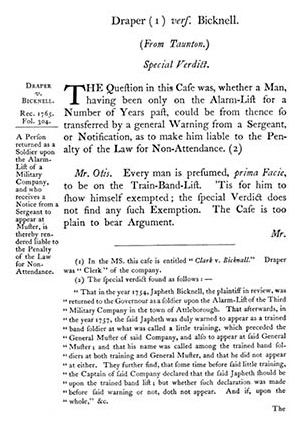
[P. 164]
5 George III (Aug.) in the Superior Court of Judicature
1 · brief description
This is, in a sense, an early conscription case. The Defendant, Bicknell, was summoned by a sergeant to appear on March 22, 1757, “at the Meeting House . . . at nine o’clock in the Morning, on the second Beat of the Drum, with Arms compleat, according to law,” with a penalty “of twenty Pounds for Non-Appearance.” The purpose was to “enlist or impress” men for Lord Loudoun’s expeditions against the French. Bicknell, believing himself to be on the secondary “Alarm-List,” rather than the primary “Train-Band-List,” did not show up. (Apparently he was blind in one eye.) Reports, 165, S. Quincy n. 2. Held, he must pay the penalty.
2 · court records
Available at 1765, fol. 304. It includes, as Samuel Quincy notes, the special verdict and, in the files, the notice from Sergeant John Puller to Bicknell.
3 · professionals involved
James Otis, Jr. (1725–1783), the Patriot, appeared for the company (Draper was the clerk). Edmund Trowbridge (1709–1793), the Attorney General from 1749–1767, appeared for Bicknell. See the short biographies in Appendix 6. As Samuel Quincy pointed out, there was a long history of litigation in this case dating back nearly eight years. Reports, 166–167, S. Quincy n. 3. Why could Trowbridge appear for Bicknell? Perhaps because the fines went directly to the company, rather than the colonial government. See Note 6, below.
4 · authority
None given.
5 · later citations
None.
6 · notes
Under Province Law of 1675, Chapter 70 of the Colony Laws, “Band Clerks,” like Draper, had the power to collect fines for men not appearing and to spend the fines on the needs of the company. See Anc. Chart., supra, 160–161, 169. Despite Trowbridge’s eloquent argument-“how unjust is it, by such a general warning to clap him on the Train-List and make him liable to heavy a Fine!”-Bicknell had plenty of notice as to the summons and the fine. See Reports, 165, S. Quincy n. 2. It was up to him to show up and be exempted. As Otis pointed out, “[t]he Case is too plain to bear Argument.” Reports, 164. So why did Bicknell fail to show? Even if you were “blind with the right eye” you might still be impressed into service. It was a risk he did not wish to take.
this volume has been typeset in caslon types, printed at reynolds dewalt, new bedford, massachusetts

design by paul hoffmann

